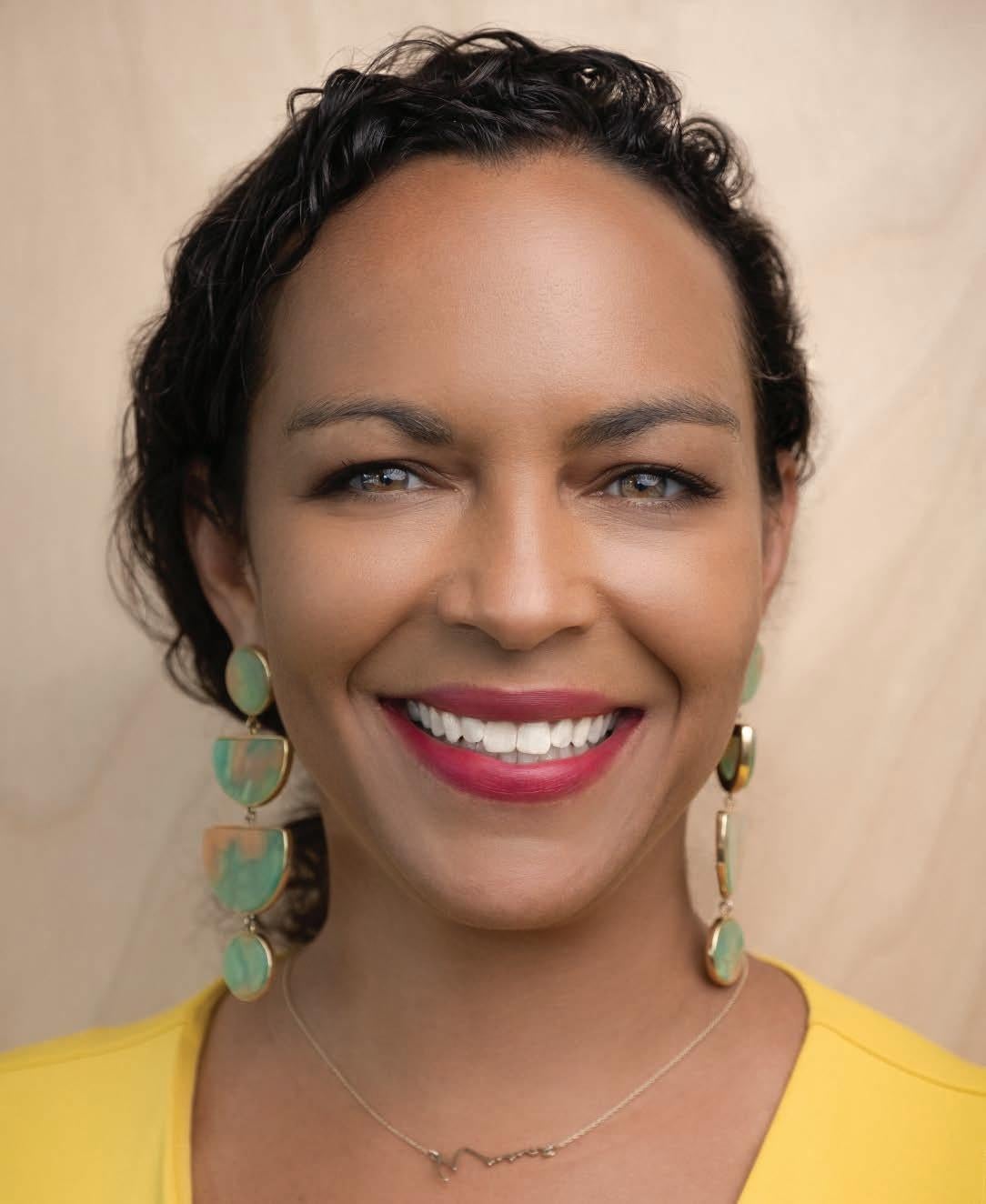
THE FUTURE OF EDUCATION WHAT LIES AHEAD
Emma Pengelly ’98 of the Walton Family Foundation
(SEE PAGE 12) DARE TO BE TRUE FALL/WINTER 2022
Milton Magazine Wins Magazine of the Year Award

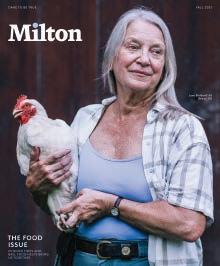
Milton Magazine made history this year, becoming the rst publication from an independent school to win the 2022 Robert Sibley Magazine of the Year Award. The award, from the Council for Advancement and Support of Education’s Circle of Excellence competition, recognizes Milton’s 2021 spring and fall issues.
The judges said, “Milton Magazine is that rare mix of big ambition and high-level execution. The judges admired both the story choices and concepts, as well as the depth and dimension of the storytelling. We found the design smart and balanced throughout, lled with thoughtful illustration and photography choices that perfectly matched the tone of the narrative. Milton Magazine does what print magazines do best: O er a thoughtful, intellectual, and engaging departure. The competition for this year’s Sibley Award was remarkably erce, with exceptional quality and ambition evident across a wide range of institutions.”
The Sibley Award has existed for 79 years; all 78 of its previous honors have been given to publications from colleges and universities.
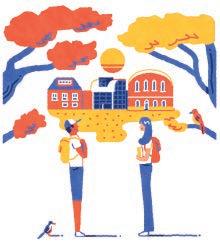
clockwise from left: amaël isnard; john huet; brian rea; ken richardson Milton Magazine “
I do
believe people
want
to
do the
right thing. And if
we
can give people examples of
a
better way, then change becomes more possible.” ERIC SCHWARZ ’79 SEE PAGE 30 Big News! Contents fall / winter 2022 head of school 4 A Time to Rejoice and Re ect faculty perspective 6 Why I Teach by Matthew Blanton in the classroom 8 New Upper School Principal Monica Benton Palmer Features Quad . . . . . . . . . . . . . . . . . . . . . . 2 24
EMMA PENGELLY
is helping communities in northwest Arkansas and the Arkansas-Mississippi
a
What’s Next For Public Schools?
For public school educators MICHAEL SABIN ‘85 and PETER FISHMAN ’01, the past two years have brought heartbreak and headache as well as lessons and opportunities.
A Brave Space
As a teacher and the director of Africana Studies at
MICHELLE JEAN-CHARLES
Thinking Big
innovator
SCHWARZ
Commitment to Mental Health
Head of School,
Chun
West offers
HEAD OF SCHOOL
Todd B. Bland
Eileen Newman
Sarah Abrams
EDITOR
Marisa Donelan
EDITOR
Martha Spaulding

DESIGN
Modus Operandi Design
Patrick Mitchell
André Mora
CONTRIBUTING ARTISTS
Andrew Bannecker
John Huet
Amaël Isnard
Mike McQuade
Eric Palma
John David Pittman
Brian Rea
Ken Richardson
Jason Schneider
Michael Warren

Rob Wilson
milton magazine is published twice a year by Milton Academy. Editorial and business offices are located at Milton Academy, where change-of-address notifications should be sent.
As an institution committed to diversity, Milton Academy welcomes the opportunity to admit academically qualified students of any gender, race, color, disability status, sexual orientation, gender identity or expression, religion, or national or ethnic origin to all the rights, privileges, programs, and activities generally available to its students. It does not discriminate on the basis of gender, race, color, disability status, sexual orientation, gender identity or expression, religion, or national or ethnic origin in the administration of its educational policies, admission policies, scholarship programs, and athletic or other school-administered activities.
Fall/Winter 2022
CHIEF COMMUNICATION OFFICER
EDITOR
ASSOCIATE
COPY
printed in the usa on recycled paper DARE TO BE TRUE FALL/WINTER 2022 On Centre . . . . . . . . . 36 Alumni Life . . . . . . 57 Building Brighter Futures 12
‘98
Delta create
vibrant future.
. . . . . . . . . . . . . . 18
. . . . . . . . . . . . . . . . . . . . . . . . . . . . . . . . . . 24
Northeastern University, RÉGINE
’96 strives to create a community where students and ideas flourish.
. . . . . . . . . . . . . . . . . . . . . . . . . . . . . . . . . . . 30 Social
ERIC
’79 has spent his career helping to level the playing field. upper school . . . . . . . . . . 38 Coaches Are Teachers Too lower school . . . . . . . . . 42 A
in the news 46 New
Kendall
remembered, Cornel
advice, Girls varsity tennis co-champions, and more class notes . . . . . . . . . . . 58 reunion . . . . . . . . . . . . . 65 Board oF trustees . . . . . . 77 nKotQ . . . . . . . . . . . . . . . 78 postscript 80 30

2 Milton Magazine
TOPS IN THE ISL
Milton’s girls’ varsity squash team had a standout year, placing first in the ISL and 12th nationally.

3Fall/Winter 2022 photograph by John Gillooly LEADERSHIP & FACULTY PERSPECTIVES
A Time to Rejoiceand Reflect

AFTER A YEAR OF SEPARATION, THE RETURN TO CAMPUS THIS PAST YEAR WAS A TIME TO BOTH CELEBRATE AND CONTEMPLATE HOW WE MOVE FORWARD.
when all students returned to campus in the fall of 2021 for in-person learning, their lively presence confirmed what many of us have long believed: There is no substitute for the full Milton Academy experience. □ The primacy of nurturing authentic relationships in small settings across our community, the excitement of our active learning and co-curricular environments, and the physical and mental presence necessary for classroom discussions at the highest level became abundantly clear. While Milton—to the credit of our faculty and staff—was able to quickly pivot to remote learning at the outset of the covid -19 pandemic and support students’ needs regardless of their location in the world, the return to a fully in-person program affirmed the incredible value of our community. □ Although the past few years affirmed the power of in-person learning, they also demonstrated that there are many modes of curricular delivery, and those modes work differently for different students. As we look toward the future at Milton, we should embrace the lessons of the past few years. Among those, most critical are the need for schools to constantly review their approaches to teaching and learning, and the recognition that every child achieves differently— according to myriad factors that include but aren’t limited to their educational foundation, their cultural and socioeconomic backgrounds, and the ways in which they learn. □ The traditional American grading system—a, b, c, d, f—implies that there are only five possible outcomes after a semester or a full year of learning. As educators, we know that such designations are no longer adequate to describe a student’s progress. Those letters on a transcript don’t provide a complete picture of a student’s mastery of skills or content, nor do they demonstrate
4 Milton Magazine
jason grow Quad Head of School
TODD B. BLAND , HEAD OF SCHOOL
improvement over time. They also feed into the pressure that many high-achieving students put on themselves to be perfect, pressure that’s compounded by an increas ingly competitive college-admis sions landscape.
In Milton’s Middle School, stu dents are well prepared for the aca demic rigors of high school without receiving letter grades. Our teachers in the middle grades are in regular communication with students and their families about achievements and progress: Students are intrinsi cally motivated because they know how they’re doing—not because of a letter grade or a number average they strive to keep or attain, but be cause they have a deep understand ing of their own proficiency. Our Lower School teachers are con stantly monitoring their students’ growth and giving them feedback, informally and in real time, as part of the rhythm of each school day. With our youngest students, this process of constant assessment informs the direction of our curriculum: Be fore moving forward to a new unit, Lower School teachers have built a complete picture of their students’ proficiency in the current one.
In the Upper School, we have begun the work of considering im proved ways to assess students’ performance to better reflect the rich learning experiences they have in their years at Milton. Be fore the pandemic, we removed letter grades from transcripts for Class IV students in recognition of the widely varied experiences stu dents have had by the time they ar rive at our school. All new Upper School students have achieved ac ademic success, but given our glob
al enrollment, their foundations for learning differ. Now, Class IV teach ers can help all students build to ward understanding and excellence, rather than spend all their energy reaching for perfection—or trying to avoid failure.
Since 2016, Milton has been a member of the Mastery Tran script Consortium, a coalition of public and private schools across the country that are investigating better and more equitable ways to assess students’ learning. Although we have not adopted its new tran script format, the ideas generated by this group provide much for Milton to consider. According to the con sortium, the MTC transcript pres ents a clear visualization of each student’s distinct strengths within
the context of their school, and it allows students to highlight partic ular projects and achievements that demonstrate their growth. Both fea tures provide the kind of evidence of learning that letter grades on their own cannot convey.
There is extraordinary value in a Milton Academy education that ex tends far beyond students’ access to superb colleges and universities. At our best, when we live our mission and prioritize holistic development at each grade level, we graduate stu dents who are not only highly capa ble academicians, but are prepared to advocate for themselves and oth ers, manage their mental and physi cal health, rise in the face of conflict and discomfort, and recognize and appreciate their own growth.

5Fall/Winter 2022
“As we look toward the future at Milton, we should embrace the lessons of the past few years.”
illustration by Amaël Isnard
Why I Teach
HISTORY AND SOCIAL STUDIES TEACHER MATTHEW BLANTON WANTS STUDENTS TO EXPLORE THE STORIES WE TELL OURSELVES ABOUT OURSELVES.

besides the threat and loss covid continues to perpetrate, it has also laid bare the power and need to be together. Milton’s faculty, staff, and students alike have drawn from untapped reserves to remain con nected. These past few years, howev er, have made abundantly apparent that virtual classrooms cannot rep licate the importance of brick-and -mortar spaces. By now, we are all more than aware that a mosaic of faces on a computer screen gener ates neither the chemistry nor the accountability that Harkness Table neighbors demand. Even if a mask hides a classmate’s nose and mouth, they can still contort their face or shift in their seat or let out an au dible clue or input that’s abundantly legible from only a few physical feet away. This unspoken vernacular— nonverbal cues of human exchange too often lost on Zoom—undergirds our social contract of learning—a tangible part of the on-campus, community-making process.
Past the pandemic horrors, how will historians look back on these years? At Milton specifically, what was it like for new students in the fall of 2021? How did they culti vate a sense of belonging? How did we collectively create commu nity when it was so hard to be in community? What will our postcovid culture look like? These in quiries necessitate that we look to the past for guidance, and many of these concerns form the core un derpinnings of what I ask students to contemplate in our history class room. How did a particular society come into being? How is it bound? What factors contribute to its shape and function? Out of this structure, what realities emerge, and which
ideologies do a people hold most dear? In their search for answers, students begin to differentiate be tween mythologies, facts, and truth, between the past and history.
My career as an educator did not begin as a historian. When I grad uated college, I planned to take a quick break from studying before starting medical school. With a psychology major and premed re quirements in hand, I began a oneyear fellowship as a math teacher at a Connecticut preparatory school. A temporary layover became a sixyear stint. I discovered that I love teaching. Numbers and equations? Less so. My favorite interactions with students involved grappling with thorny social issues. Ultimate ly, the long-term plan to become a doctor morphed into a peripa tetic journey through graduate schools in African American stud ies and American studies. Eventual ly, I landed at Milton, where some of the foundational goals I try to achieve in my history courses mir ror those I pursued when I taught the Pythagorean theorem or the chain rule: making kids feel bet ter. In fact, that objective fueled my original inspiration to become a pediatrician. Fulfilling this pos sibility in the classroom is embed ded far deeper in the mechanics of learning than in the achievement of prescribed outcomes. Prioritizing process invites us to partner our study of history with philosophical considerations of humanity. After we investigate a few basics —Who? What? When? Where?—we can in terrogate how and why people of the past negotiated their circum stances as they did. This arrange ment coheres nicely with Milton
6 Milton Magazine brenna greer Quad Faculty Perspective
Matthew Blanton
students’ steadfast curiosity. Their abiding question is often “How did it get like this?”

Somewhere within these explo rations, students start to see that history consists of the stories we tell ourselves about ourselves. They begin to notice how power influ ences which stories we recall, even valorize. Later this year, my grand mother will turn 100. She has be queathed to me invaluable accounts of her earliest years growing up in the Deep South just as her grand father shared with her chroni cles of his Mississippi childhood. Born into bondage in 1847, he be gan his life while James Polk oc cupied the White House, the ninth of 12 U. S. presidents to own peo ple as property. Yes, 2022 is only a few grandparents’ grandparents away from slavery. How, then, does this conception affect our sense of the present? In my classes, I try to impress upon my students not just the relevance but the proximity of the past. I want them to recognize how various historical conditions intersect to determine people’s lived experience. While I certain ly value content, memorization of easily “Googleable” facts is not what I emphasize. Besides grasp ing its details, for instance, how do students make sense of the signif icance of The 1619 Project? In the New York Times in 2019, the jour nalist Nikole Hannah-Jones spear headed the historical endeavor that presented an alternative U.S. ori gin story. It provoked intense reac tions, most notably from the White House, which denounced the work for “villify[ing] our Founders and our founding.” The public outcry testifies to the importance we in
vest in how we remember the past. All these dynamics motivate three symbiotic principles that govern my pedagogy. How can I help students make meaning from a particular history? How can I make it applicable? And what do I want students to take away? The fact that students in Milton’s Upper School hail from numerous states across the nation and from coun tries around the world complicates these questions in wonderful and necessary ways. To help reconcile some of this complexity, the histo rian William Cronon offers useful direction. He reminds us that mem ory lets us not only remember the past but also observe change over time and discern cause and effect. This insight, he asserts, enables us to be “moral agents.”
For our students, this conclusion defies individualism’s steady pull and empowers them to engineer the change they want to see. More specifically, it encourages them to imagine and create the communi ties they need, particularly as they each wrestle with worries about be longing. Just as Milton harbors its own history as an institution, each student possesses their own knot ty, personal, multilayered “before.” How do they invoke this past—their history—in their “becoming”? In deed, our histories inform our iden tities. How we negotiate and assert those identities within larger narra tives of which we are a part remains an enduring question. Helping kids understand this about their world, their nation, their school, and about themselves—this is why I teach.
7Fall/Winter 2022
“Along the way, they come to understand how power influences which stories we recall, even valorize.”
illustration by Amaël Isnard
New Upper SchoolPrincipal
WITH MANY YEARS OF EXPERIENCE AT INDEPENDENT SCHOOLS, UPPER SCHOOL PRINCIPAL MONICA BENTON PALMER INTENDS TO SPEND HER FIRST YEAR AT MILTON OBSERVING AND LISTENING.
Monica Benton Palmer
dr. monica benton palmer be came principal of the Upper School on July 1, 2022. Previously the dean of faculty at the Governor’s Acad emy, Palmer has two decades of independent school experience, beginning with several roles at the Madeira School in McLean, Vir ginia, where she was a member of the faculty, dorm head, parents’ li aison, enrollment manager for di versity outreach, and the fine and performing arts department chair. Prior to her career in education, Palmer was an actor, performing on stage and in film and television. She received her undergraduate degree in dramatic arts and law and society from the University of California, Santa Barbara. She holds two mas ter’s degrees from Columbia Uni versity: an m.f.a . in theater and an m.ed. in educational leadership from the Klingenstein Center for Private School Leadership. Palm er earned her doctorate in educa tion and organizational leadership from the University of Pennsylva nia. She succeeds DAVID BALL ’88 , who has been named the director of strategic initiatives.

Milton Magazine met with Palmer in the spring to discuss her new role and vision for the Upper School.
WHAT EXCITES YOU ABOUT MILTON AND YOUR NEW ROLE?
So many things excite me about this new role, but at the top are the stu dents and adults here. When you think of Milton, you think of a long history around making strides to ad vance education as we know it. To become part of this history is incred ibly exciting for me, not only as an educator but as a parent, and as a per
son who respects traditions yet push es to see what we can do better. There are so many schools that revere Mil ton as a progressive place for educa tion; to be part of it is thrilling in so many ways.
HOW SHOULD A SCHOOL LIKE MILTON BALANCE ITS CENTURIES-OLD TRADITIONS WITH THE NEED FOR PROGRESS?
Part of what I wrote about in my dis sertation was the history of board ing schools. When you have these old schools, some of which have been in operation since before the country was founded, they can be rooted in ways of the world that are not always aligned with where we are and where we’re trying to go to day. You can look at the past and re spect the history and understand the context of where the school was at a given time, but also become a beacon of change for the future. I often find that schools like Milton and Gover nor’s are looked at as examples for others, and we have a real opportu nity to advance our public purpose. Parents today are always think ing about the value proposition: “Why are we spending X amount of dollars to send our child to this school?” We need to ask that ques tion of ourselves: What is truly our purpose? Not only in the communi ty, in the state, in the region, in the country, but in the world.
WHAT ARE YOUR PRIORITIES IN THIS FIRST YEAR LEADING THE UPPER SCHOOL?
My first year is about listening, about hearing what people are say
8 Milton Magazine Quad Leadership Perspectives
david oxton
ing and listening for things that aren’t necessarily being said. I plan to observe and go to as many events, games, and performances as I can, and to approach Milton like an ar chivist so that I can glean a great deal of learning throughout the first year.

I am rooted in the belief that when we provide opportunities for our young people to go outside the curriculum and be able to take theory and put it into practice, it sticks. That’s really what education is about, and I plan to spend this year educating myself.
DESCRIBE YOUR LEADERSHIP STYLE.
My leadership style with adults is about hearing where they’re coming from. I think that’s been the most important aspect of my leadership. In my role as dean of faculty, I had to have lots of conversations that were not always easy. Having em pathy and respect for people and meeting them where they’re at is very important to me. My approach is very collaborative and founded on the basic premise that people come first.
The pandemic, for me, also intro duced the importance of support re garding mental health and the anxiety felt by not only students but adults. I make sure that people know that I’m accessible, and if I’m not at a giv en moment, there are clear directions for where I am and when you can get in touch with me.
WHAT INSPIRES YOU ABOUT WORKING WITH HIGH SCHOOL STUDENTS?
They’re always thinking and they’re
always pushing the boundaries, which they’re supposed to do. It’s age-appropriate. They have ideas about what’s wrong and what’s right and they want to know where the adults are. At the end of the day, teenagers what to know: Are you consistent? Are you truly doing what you said you’d do? The stu dents want to know that they’re cared for, they want to know that you’re there for them. It doesn’t mat ter where they’re coming from. I have met students from all walks of life and they all want to know that their educators care.
CAN YOU TALK ABOUT YOUR LEADERSHIP EXPERIENCE IN THE AREA OF DIVERSITY, EQUITY, INCLUSION, AND JUSTICE?
It’s my daily walk. It’s the shoes I walk in. It’s the skin on my back. Be ing a Black woman in this America is no easy feat, especially in a pre dominantly white institution. When I began working at Madeira, it was clear that deij came from the top. The head of school said, “If I am not the person leading diversity, equity, and inclusion, people will deem it unimportant. I can make sure that it’s prioritized in our budget and part of our strategic plan and cur riculum and everything we do here.” That level of transparency was im portant, and something I include in my own leadership. From that point, this work became part of the fabric of what I do. I have tried to lead by example as a teacher, and when I be came dean of faculty, I did the same thing across academic disciplines.
9Fall/Winter 2022
illustration by Amaël Isnard
“We need to ask that question of ourselves: What is truly our purpose? Not only in the community, in the state, in the region, in the country, but in the world.”


10 Milton Magazine FALL/WINTER 2022
EDUCATION: What Lies Ahead?

The events of the past several years have been especially challenging for the field of education. But the circumstances of these times have also brought about the potential for growth and innovation. Some of Milton’s alumni and teachers share their perspectives.
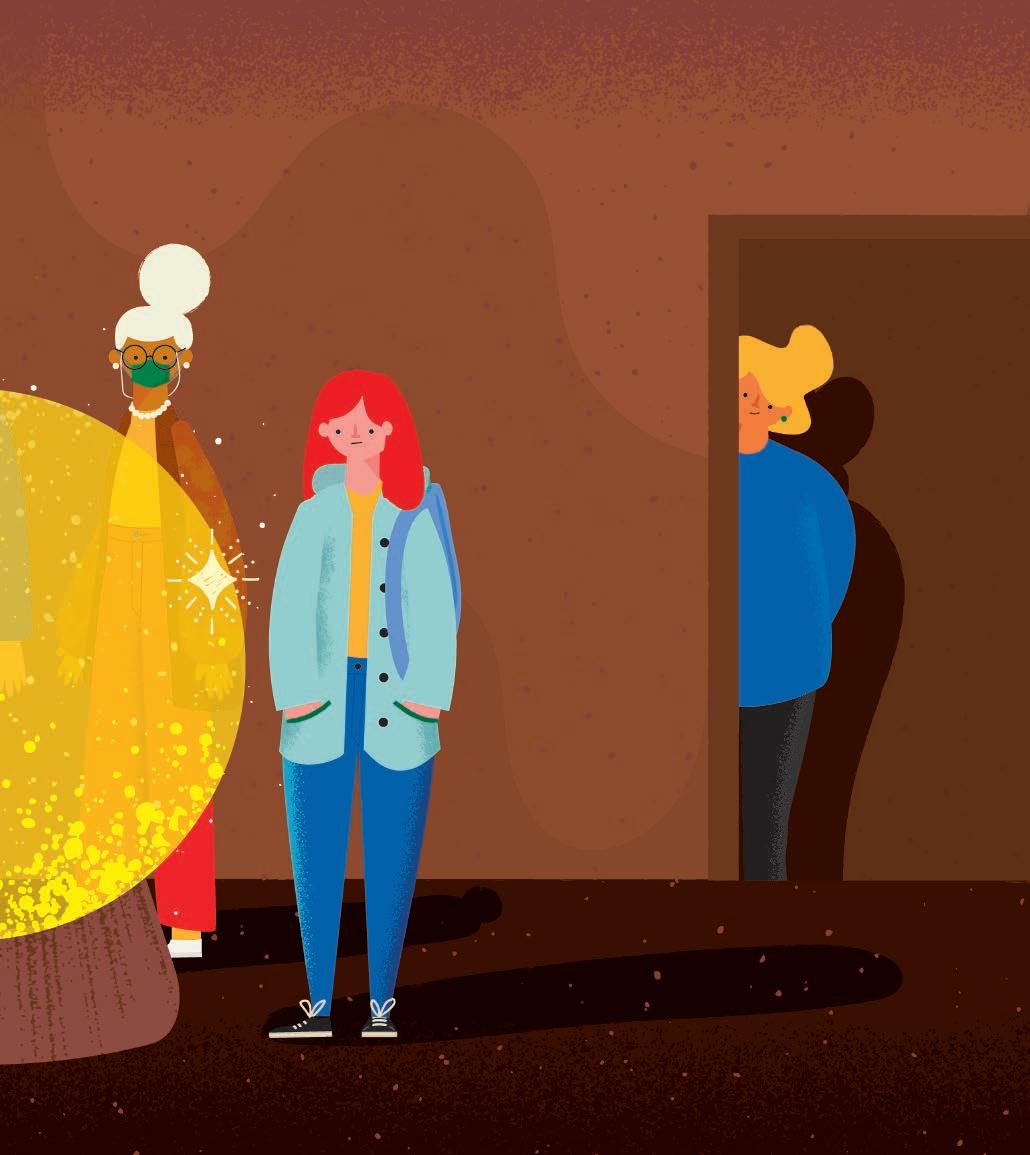
11Fall/Winter 2022
illustration by Andrew Bannecker
EMMA
Story by Andrew Bauld Photographs by John David Pittman
WITH
GREATER
12 Milton Magazine
PENGELLY ’98 IS WORKING
COMMUNITIES IN NORTHWEST ARKANSAS AND THE ARKANSAS-MISSISSIPPI DELTA TO CREATE
OPPORTUNITY FOR THEIR CITIZENS.

Thrive, Inc. provides students in rural communities with paid internships and afterschool workshops.
Vibrant northwest Arkansas is home to four of the 10 largest cities in the state, the University of Arkansas, and a handful of Fortune 500 compa nies. It’s one of the fastest-growing metro areas in the United States—an economic and artistic hub.

In the opposite corner lies the Arkansas-Mississippi Delta, where rural counties have seen their popu lations decline steadily for decades, and where high poverty, limited ac cess to health care, and educational disparities are just some of the con stant challenges to revitalization.
But look closer and you’ll find that they have a common goal: to build communities where everyone can succeed.
Helping bring that dream to life is EMMA PENGELLY ’98, deputy direc tor of the Home Region Program at the Walton Family Foundation. She and her team are working with these two distinct regions to create a thriving future, guided by the voices of those who live there. “Our job is really to help people with ideas and people with passions realize their vi sion,” she says.
As part of its five-year strategy, the Home Region Program is work ing to build an inclusive economy in northwest Arkansas for both re cent transplants and those who have lived in the area for generations, and to promote equity through educa tion and financial security in the Delta. Pengelly’s work is as dis tinct as the two regions she serves. One day she might meet with school leaders to figure out how to expand programming; on another she’s in a
hardhat on the site of a new shared community green space.
“This is where I live and work and raise my kids,” she says, “so get ting up every day and feeling like I’m doing something for my com munity brings me a lot of joy.”
Even before her current role, Pengel ly wanted to make an impact on the world. It was an ambition that was cemented during her years at Mil ton. At the time, no one in her fami ly had finished college, let alone gone off to boarding school, and leaving her hometown of Portland, Maine, to attend Milton “was a total culture shock,” she says. It would also prove a life-changing experience.
“What it allowed me to do was become the critical thinker and the independent person that I was meant to be much sooner,” Pengel ly says. She especially credits the atmosphere of Milton that en couraged respectful dialogue across backgrounds and ideologies.
“You didn’t have to agree to hear each other’s viewpoints, broaden ev eryone’s understanding, and make each other sharper,” she says.
After graduating from Milton and attending Harvard Universi ty, Pengelly knew she wanted a ca reer that would give back to the world and make a difference. She just didn’t know how she would go about deciding.
For a time, she thought she might become a lawyer. She spent a sum mer as an intern through a fellow
credit 14 Milton Magazine
At first glance, northwest Arkansas and the ArkansasMississippi Delta might seem like a study in contrasts.
ship with the Legal Aid Society, the largest social-justice law firm in New York City. Pengelly worked in the juvenile rights division, help ing families and youth struggling to get the school services they needed. It was important work, but still she felt something was missing.
Back in Massachusetts, she be gan working at a charter school in Boston, and it was there, in the af ter-school program, that she had a realization.
“I was in a position where school had been so transformative for me, and I was working at a school that
was so transformative for the stu dents there,” she says. “If I wanted to make a difference, the law wasn’t the right path. After that experience, I decided I wanted to be a teacher.”
Pengelly was inspired by her ex perience at Milton to bring to her students the same support and oppor tunity she had received. She joined Teach for America and then spent nearly a decade as a teacher and as sistant principal in Brooklyn, New York. Still, that old feeling that she wasn’t doing enough eventually re turned.
“The other teachers and leaders
in the building and I were waking up at the crack of dawn and doing our best, and things in the system still weren’t working for our kids,” Pengelly says. So she returned to Cambridge, this time as a member of the second cohort in the pres tigious doctor of education lead ership program at the Harvard Graduate School of Education.
After spending another three years at Harvard learning the ins and outs of true system-level change, Pengelly and her family relocated to Benton ville, in northwest Arkansas. In 2014, she joined the Walton Family Foun
The Walton Family Foundation fosters greater economic opportunity through its support of such community-based initiatives as Thrive, Inc., in Helena, Arkansas.
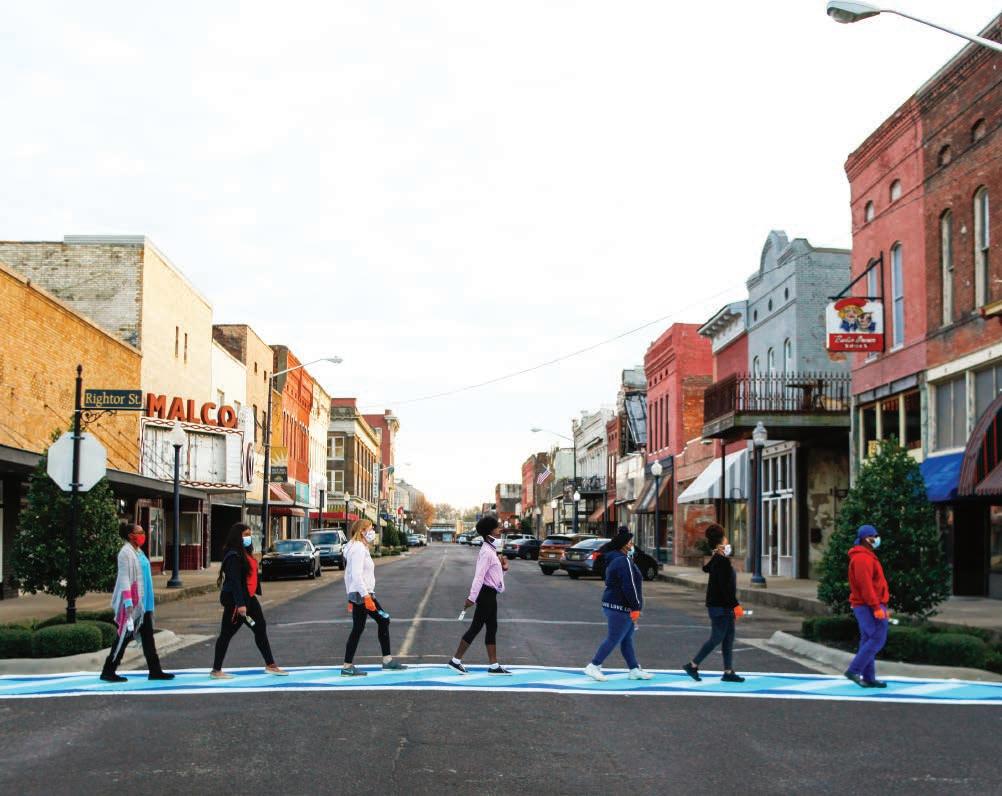
15Fall/Winter 2022 courtesy of thrive, inc.
“Great ideas can come from anywhere, and great people come from everywhere.”
dation to work on its national educa tion program, supporting new and innovative school models and help ing build a pipeline to bring more diverse educators into the teaching profession.
Now, as home region deputy di rector, Pengelly puts her skills to use addressing the myriad needs of a community that she has also come to call home. While some of that in cludes working in her “sweet spot” in education, she says her role “is re ally about a lot of the factors that make up a community.”
Those include working on solu tions to improve affordable hous ing and ensuring that everyone in the community has access to shared outdoor spaces. Having grown up with the forests and oceans of Maine, Pengelly wants a similar experience not only for her own kids but for chil dren across Arkansas.
“Growing up with access to the outdoors is so important for physi cal and mental health and for learn ing about being good stewards of our environment,” she says. “I love that part of my work allows me to think about equitable access to the outdoors.”
future of the region.
“It’s about learning and getting better at what we’re doing,” she says. “Whenever you’re using research, economic or otherwise, to chart a strategic course, there’s always at the same time listening to what the community wants and what the community’s priorities are.”
Forging partnerships with such a mixed group of community members, from city planners to artists, business leaders to teachers, Pengelly honed skills as a school leader that have translated well to her current role.
“I would say all work is relation ship work,” she says. “As a teacher it was incredibly important to build strong relationships with families, students, and other teachers. In my current job, folks come from all dif ferent places, but we’re trying to create shared goals about where we want our community to go.”
Recently, the program has re leased a new strategy for growth in the Delta following a year of con versations with the community and local leaders. The plan will have an education focus and also an empha sis on personal-asset building.
The businesses that have al ready been supported represent many of the qualities of the state. Take Griot Arts, in the Delta, which uniquely sits at the intersection of the arts, education, and a typical Main Street business. It offers af ter-school programming for stu dents, an art gallery space, and a coffee shop. Another business in northwest Arkansas, called Inter form, provides resources for under represented people interested in the fashion industry. Interform includes a focus on Marshallese youth, a large segment of the population in the re gion, which is home to the largest Marshallese community anywhere outside the Marshall Islands.
Spending time in the field with such a swath of community mem bers, from grantees and students to small-business owners, is one of the most exciting parts of Pengelly’s job, and the one she has missed most since the disruption of the pandem ic. But now, as things return to some form of normal, she’s happy to be back out in the community, witness ing firsthand the impact the foun dation’s work is having.
Despite the geographic distance, Pengelly finds northwest Arkansas to be not dissimilar from where she grew up in Portland: It has great food, an arts culture, a diversity of nature, and welcoming neigh bors invested in their community. Pengelly has tapped into that spir it of civic engagement, and she has made it a point to listen to the voic es of the community to shape the
“Some of that is small business, but also a focus on home ownership because we know a home is one of the most important assets a fami ly can have and can create multi generational economic stability,” Pengelly says.
Another concentration of the program has been on entrepreneur ship. Pengelly is particularly proud of the work the Home Region Pro gram has done to attract programs and incubators to Arkansas to help folks, particularly women and un derrepresented minorities, start new businesses.
“Great ideas can come from any where, and great people come from everywhere,” Pengelly says. “One of the things I’m so grateful to be able to do is continue to help folks who have world-changing ideas realize their vision. That feels really amaz ing.”
ANDREW BAULD IS A FREELANCE WRITER COVERING K-12 AND HIGHER EDUCATION. A FORMER CLASSROOM TEACHER, HE HOLDS A MASTER’S DE GREE FROM THE HARVARD GRADUATE SCHOOL OF EDUCATION AND LIVES IN BROOKLYN, NEW YORK.
16 Milton Magazine
“If I wanted to make a difference, the law wasn’t the right path…. I decided I wanted to be a teacher.”
 Story by Grace Tatter
Photographs by Michael Warren
Illustration by Mike McQuade
Story by Grace Tatter
Photographs by Michael Warren
Illustration by Mike McQuade
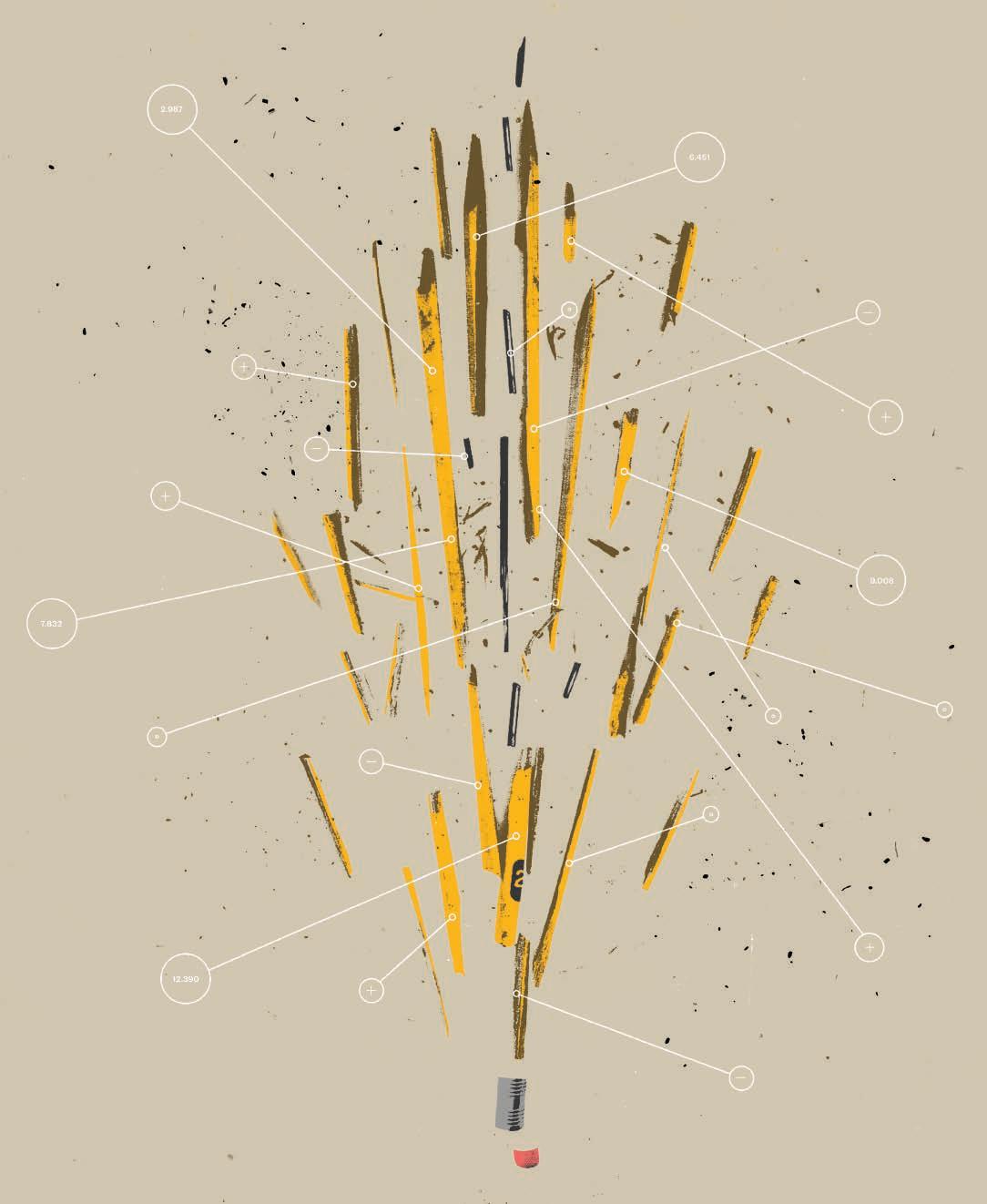
WHILE THE PAST TWO YEARS HAVE BROUGHT MYRIAD HEARTBREAKS AND HEADACHES INTO THE PUBLIC SCHOOL CLASSROOM, ALUMNI WORKING IN PUBLIC SCHOOL EDUCATION SAY THEY HAVE ALSO PROFITTED FROM IMPORTANT LESSONS AND OPPORTUNITIES.
The COVID -19 pandemic upended how public schools operate, altering everything from what instruction looks like to how progress is measured, from the role of parents to the most pressing needs of students. All these changes happened against a backdrop of fractious politics seeping into the school building— meaning that public schools, and the people whose careers are devoted to them, have been in a constant state of reckoning. How can educators and students move forward in an ever-changing landscape? And what, if anything, from the many months of abrupt school closures, Zoom rooms, and charged political debates, should they keep?
WHAT’S NEXT FOR PUBLIC SCHOOLS?
19Fall/Winter 2022
MICHAEL SABIN ’85, a principal at McDevitt Middle School in Waltham, Massachusetts, has spent his entire career in public schools. That career started before he was even a college graduate. After his sophomore year at Harvard Uni versity, he took a whole year off to work in public schools: one semes ter as an assistant teacher in New York City and one semester work ing at a middle school in Boston. He spent several years as a classroom teacher before eventually returning to Harvard for a degree in admin istration from the Graduate School of Education. He recently was look ing through papers from his early days in school leadership and came across memos about how to mark the first anniversary of the Septem ber 11, 2001 terrorist attacks.
“It was interesting to look back at how we did that, and to just re member you’re kind of this symbol ic leader of a school, but what does anybody know about the first anni versary of something like that?” he says. It was an early reminder that students’ experiences within school are heavily influenced by their ex periences outside school.
“Thinking back to 9/11, obvi ously the top priority was to make sure your school is safe, but I think the second top priority for us be came making sure our Muslim stu dents felt safe, regardless of what was happening with homeland se curity,” he says.
In this decade, current events that deeply affect students’ sense of safety and security can be almost weekly occurrences. Figuring out how to address those events—from insurrectionists storming the Capi tol to protests against racism cata

lyzed by high-profile police killings of Black people to war in Ukraine— is as much a fixture of educators’ jobs as taking attendance.
“That can get complicated some times,” Sabin says. “For example, I have a few Russian students right now. My job is to make sure those students are part of our communi ty and feel safe, whatever the politics outside. That’s paramount for me.”
“The past five to six years in par ticular, the discourse has become more toxic, more negative, more de grading to the lived experiences of so many students in our schools, par ticularly Black and brown students,” says PETER FISHMAN ’01, vice presi dent for strategy at Deans for Impact, a nonprofit organization focused on strengthening teacher preparation. “It raises the level of challenge for teach ers just as it raises challenges for stu dents.”
Politics and education have always been inextricable, Fishman points out. “That’s the nature of democrat ic governance in the service of educa tion,” he says. But these days, debates over everything from the science of how students learn to read to how his tory should be discussed have a sharp political edge to them, a minefield for educators. State legislatures have enacted a wave of new laws limiting how teachers can talk about current events, history, and racism. Educa tors nationwide are grappling with how they can provide students with a learning environment where they feel safe and supported, and how to equip them for dialogue and critical question-asking in a politically po larized world.
Like Sabin, Fishman spent his early career in Boston, becoming a teacher at the Academy of the Pa
cific Rim Charter Public School af ter graduating from Yale University. As an early-career history teacher, he says, he never would’ve expected that educators, students, and fami lies “would have to fight to be able to just teach the truth and teach a ver sion of history that engages young people in the difficult and ugly parts of our past, but also the stories of people who have been continuing to stand behind a set of bedrock prin ciples around justice, equality, and freedom,” he says.
“It’s a really fascinating and chal lenging time,” Sabin says. “As a pub lic school principal, I take seriously that I’m representing every single student and family in the town, and there’s a wide diversity of opinions, beliefs, personalities, and needs. My role is to make sure every one of those students feels safe, feels that their potential is being recognized, feels that they’re part of the com munity—but sometimes their inter ests seem somewhat irreconcilable. There’s a lot of problem solving that I think we engage in to try to make sure every single one of our students can thrive.”
Part of the reckoning over how to address the realities of current events and history in the classroom has to do with a renewed emphasis on addressing students’ social and emotional needs and how those needs are inextricable from their academic success. A perennial ques tion in education is how to measure whether those academic needs are being met. Both Fishman’s and Sa bin’s careers have spanned mini-rev olutions in school accountability.
MICHAEL SABIN ’85 (RIGHT), PRINCIPAL, MCDEVITT MIDDLE SCHOOL
20 Milton Magazine
“As a public school principal, I take seriously that I’m representing every single student and family in the town, and there’s a wide diversity of opinions, beliefs, personalities, and needs.”
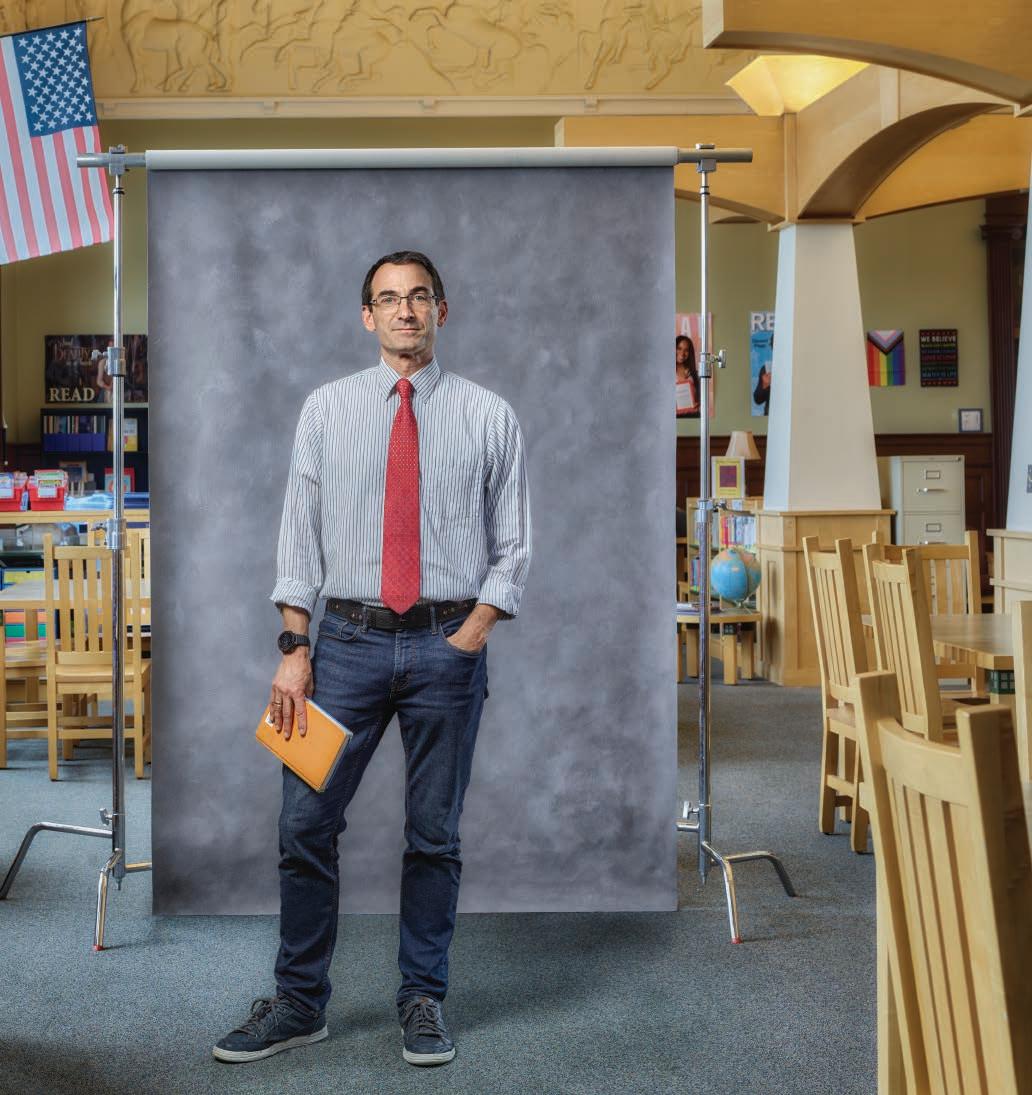
credit 21Fall/Winter 2022
Massachusetts began annual stan dardized testing in the 1990s, when Sabin first entered the classroom, a harbinger of the accountability movement formalized nationwide with passage of the No Child Left Behind Act in 2002.
During the Obama administration, more states began to adopt policies to use standardized test scores in teacher evaluations. But the pandemic com pletely upended standardized testing in 2020, when school buildings sud denly shuttered. That year of disrupt ed accelerated a long standing debate over what such tests measure and how the scores should be used.

Both Sabin and Fishman say that conversation is important— and that a high-quality education that prepares students to be leaders doesn’t entail teaching for a single end-of-year test. But they are also concerned about the effects of to tally deemphasizing accountability.
“I worry that in the absence of a focus on the academic indicators, students who have been historical ly marginalized become further marginalized, because there’s not the same level of attention to ra cial disparities and other dispar ities when it comes to academic achievement and student learning outcomes,” Fishman says.
Fishman volunteered in New Ha ven’s public schools while a student at Yale. The teachers he worked with in New Haven told him to look for a school environment with a culture of feedback and learning for teachers as well as for students. That’s what drew him to Pacific Rim, a school known for its collaborative spirit.
“There was this open-door cul ture where I could go into anybody else’s classroom and just be a fly on
the wall at the back of the room, ob serving them, and then following up afterward to pepper them with questions about decisions that they made and the ways that they built relationships with students and with families,” he says. After sev eral years in the classroom and oth er roles in education, he earned his doctorate from the Harvard Grad uate School of Education.
Today, Fishman is devoted to making sure teachers are prepared for the realities of the classroom, grounded in the science of how students learn and develop their skills with meaningful feedback. He’s optimistic that the pandem ic has brought districts and educa tion prep programs closer together, providing teachers in training with more opportunities to work with experienced educators. Conversa tions about teacher shortages in some communities have also pushed the needs of educators to the fore front.
Of his own work, Fishman says, “The impact of the pandem ic on teacher shortages and mental health and wellbeing has amplified our focus on strengthening and di versifying pipelines of early-career teachers and strengthening sup ports to early-career teachers so that they experience strong mentorship opportunities that prepare them to navigate this new dynamic and the challenges that come with it.”
Sabin has seen the pandemic fa cilitate continued learning for teach ers once they are in the classroom. No longer do educators at different schools have to drive across town to meet and compare ideas or instruc tional materials: Online convening is the norm. Sabin says that remote
learning has also increased opportu nities for one-on-one tutoring outside school, a boon for students who need more personalized support. School districts across the country have de ployed such tutoring to mitigate the effects of lost learning time caused by the pandemic. Fishman points out that tutoring programs also cre ate new pathways into teaching. How ever, many of these programs depend on federal stimulus funds that are set to expire in 2024. “No one knows what happens to all these programs after that,” Fishman says.
Although Zoom is here to stay for some aspects of the school day, brick-and-mortar schools aren’t going anywhere. In fact, the im portance of a school community is more apparent than ever.
Some of the duties of a principal include “just sitting in lunch duty and supervising kids,” Sabin says. “Seeing them smiling, laughing, jok ing, just being silly, being happy— it’s beautiful.”
He’s hopeful about what’s on the horizon in public education— despite, he says, with a smile, “years of banging my head on the wall.”
The past few years have been hard, he says. “But it’s made people realize just how much the school was doing that’s positive for kids.”
GRACE TATTER IS AN EDUCATION REPORTER AND AUDIO PRODUCER. A GRADUATE OF THE HARVARD GRADUATE SCHOOL OF EDUCATION, SHE LIVES IN NEW YORK CITY.
22 Milton Magazine
“The impact of the pandemic on teacher shortages and mental health and well-being has amplified our focus on strengthening and diversifying pipelines of earlycareer teachers and strengthening supports to earlycareer teachers.”
PETER FISHMAN ’01, VICE PRESIDENT FOR STRATEGY AT DEANS FOR IMPACT
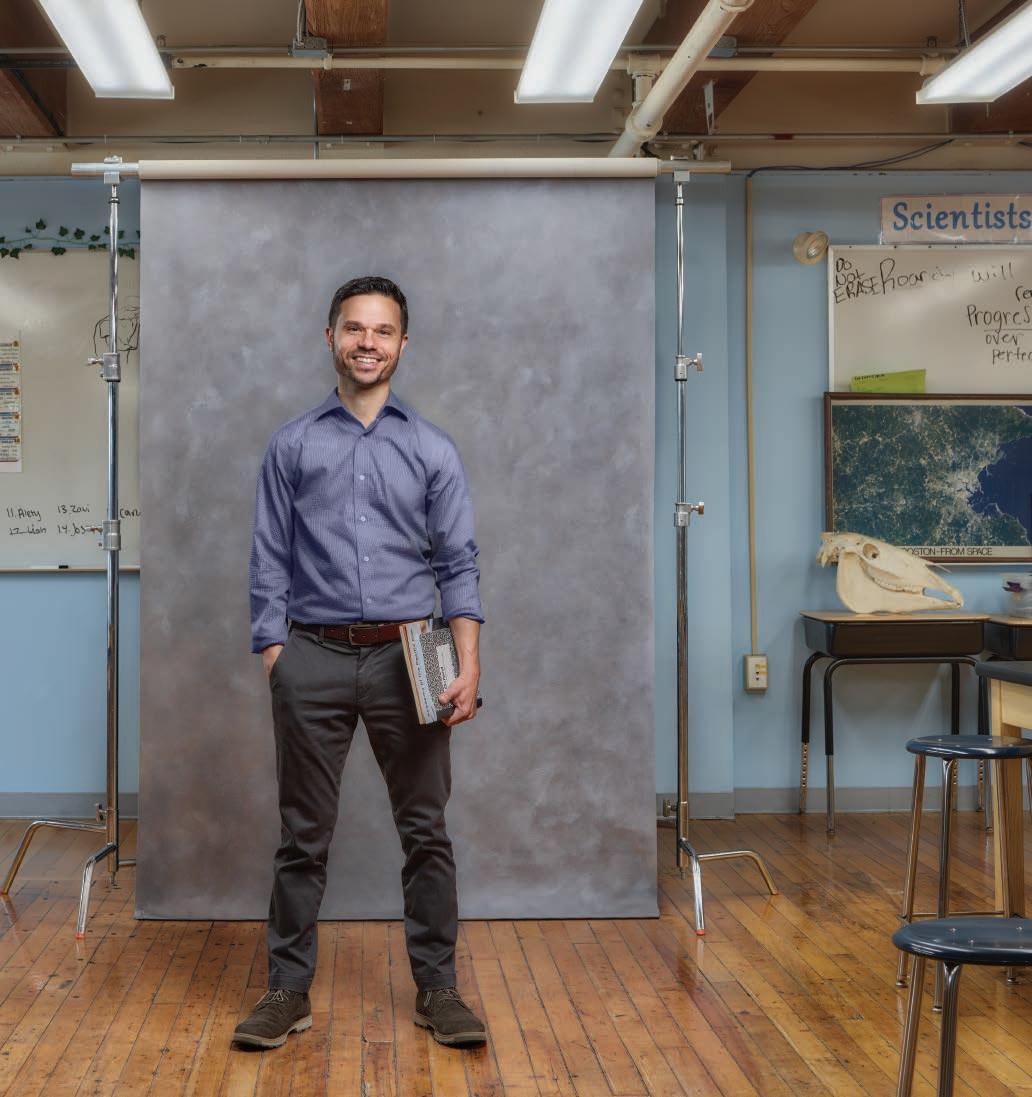
23Fall/Winter 2022
A PROFESSOR AND THE DIRECTOR OF AFRICANA STUDIES AT NORTHEASTERN UNIVERSITY, RÉGINE MICHELLE JEAN-CHARLES
STRIVES TO CREATE A COMMUNITY WHERE STUDENTS AND IDEAS FLOURISH.
Story by Marisa Donelan
Photographs by John Huet

A B R

24 Milton Magazine
AS
’96
V E
A
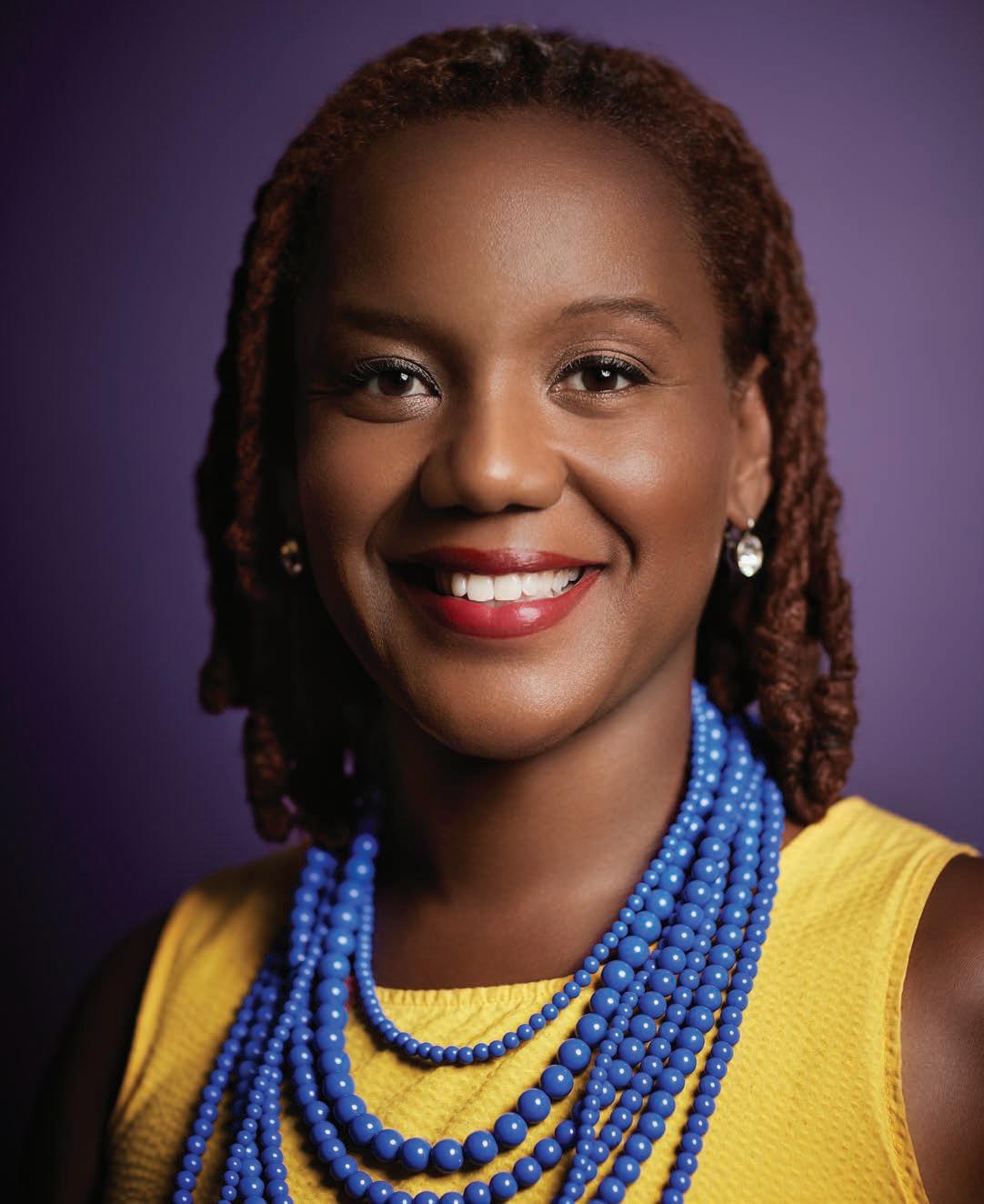
S P
C E
In her book, Martin Luther King & the Trumpet of Conscience Today (opposite page), Régine JeanCharles ’96 takes a critical view of a series of speeches by King given just months before his death. Many of King’s themes continue to apply to today’s social issues, in cluding racism and mass incarcer ation. Jean-Charles expands the message to include sexism and highlights the uncelebrated Black women at the center of move ments for civil rights and equity.

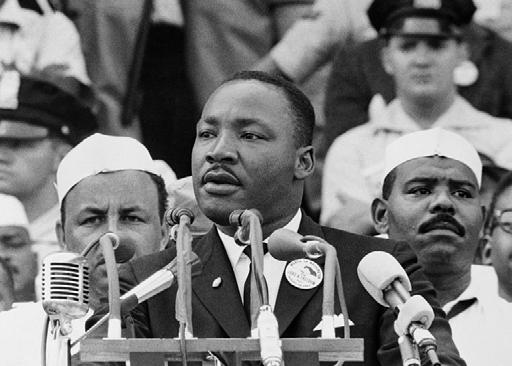
So writes RÉGINE MICHELLE JEANCHARLES ’96 in her 2021 book, Mar tin Luther King & The Trumpet of Conscience Today. In the same pas sage, she describes helping a group of students process an act of police brutality they witnessed in Paris at the tail end of a course she taught there.
Jean-Charles, a Black feminist literary scholar, cultural critic, and university professor, had led stu dents in a summer course called Paris Noir: The Literature and Culture of Black Paris, which cov ered Black culture in France from the 1930s to the Black Lives Mat ter movement. During their final week in Paris, students were un winding at a nightclub when they saw French police officers violently detain a Black man. Following the incident, Jean-Charles asked the students to reflect on what they’d seen. It was a moment not only to care for their well-being but also consider the role they play in mak ing a more just world.
“If we are to teach students to be attentive, reflective, and loving, then we must confront injustice and not turn away from incidents of pain and suffering,” she writes. “To be clear, the goal was not to have them move past it but to work through it and try to figure out what healing and justice might look like in the context of what they just wit nessed.”
Confronting the detailed and nu anced realities of injustice is neces sary for college students to develop
as thinkers and, ultimately, as agents of change, says Jean-Charles, who is the director of Africana Studies at Northeastern University. She joined Northeastern in 2020 after teach ing for more than a decade at Boston College, where the Jesuit concept of a “formative education”—which fo cuses on the whole student in an ef fort to guide young people toward purposeful lives—is a central tenet.
“It’s a concept I thoroughly be lieve in, caring for my students as entire beings, and also letting them know that I hold them to a very high standard,” she says.
Many of the students who enroll in Jean-Charles’s classes are inter ested in taking meaningful action for social justice, she says. The re lated and compounding effects of racism, economic inequality, gen der, and sexual violence—along with rollbacks of rights for lgbtq+ young people—feel urgent and de serving of more than superficial, performative efforts, she says.
“A lot of students have experi enced a range of challenges that have really been exacerbated in the past several years,” she says. “The stakes are real, and the pandemic has heightened them. I remember the students who were housing in secure, who were food insecure, who didn’t want to go home because their homes weren’t safe, and sud denly they were being told to shel ter in place.”
The topics and literature that Jean-Charles teaches can be diffi cult, particularly for students who
26 Milton Magazine top right: courtesy of régine jean-charles
“In my view, the job of the formative educator is to make justice irresistible.”
have experienced oppression. Car ing for them as human beings who have lived through trauma does not, however, come at the expense of academic rigor. Instead, teaching through the lens of a formative ed ucator and a Black feminist, JeanCharles challenges students to leave their comfort zones and take risks while exploring materials. At the same time, she cares for those who may be struggling.
“Rather than creating a ‘safe space,’ let’s create a brave space,” she says. “For Black people, and for women, and for so many in margin alized groups, higher education in stitutions will never be safe spaces. They were never intended to be safe spaces, so that idea is kind of a fal lacy. As someone who feels called to be an educator, one of my goals is to be a safe person, in terms of offering safety for people who are harmed, which does not mean not offering rigor.”
Jean-Charles’s areas of academ ic expertise are wide-ranging and include Black France, Sub-Saha ran Africa, Caribbean literature, Haiti, and the diaspora. She has covered subjects in contemporary French and Black feminism and taught a BC class called “Where #BlackLivesMatter meets #Me Too,” which combined her interests in race, gender, and justice. She also volunteers to help survivors of sex ual violence and is an active orga nizer in the town of Milton, where she lives with her husband, OHENE ASARE ’96, and their four kids.
Teaching and writing through the lens of Black feminism requires the centering of Black women’s lived experiences and intersection ality—the practice of feminism in
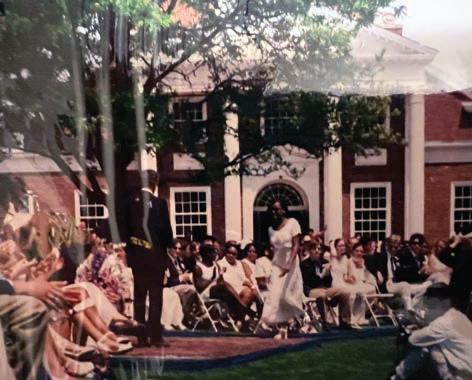

formed by social identities beyond gender and sexuality, such as race, class, and ability, and the recogni tion that these intersecting identi ties can lead to linked oppressions, Jean-Charles says. In practice, it benefits more than Black women: When the problems that oppress the most vulnerable people in a society are mitigated, all members of the so ciety are better off.
“Black feminism has always been a collective project,” she says. “We need one another. We can’t be in dividualistic because our survival depends on cooperation, and Black feminists throughout history have organized from that perspective. I see classroom teaching as commu nity building. We are a community of care, we’re a community of rigor, of critical thinking. We’re going to think hard, we’re going to disagree, and we’re going to try to do some thing. I believe in coalition as a force to transform the world.”
Jean-Charles’ Martin Luther King & the Trumpet of Conscience Today is a modern interpretation of the “Trumpet of Conscience,” a series of lectures King delivered for airing by the Canadian Broadcast ing Corporation in late 1967, just months before his assassination. Jean-Charles applies those lectures to the present-day injustices of rac ism, sexual violence, and mass in carceration.
The King who delivered the “Trumpet of Conscience”—a lamen tation about American racism, ma terialism, and militarism—is a far cry from the sanitized and sancti fied figure now heralded for the per ceived color blindness of his 1963 “I Have a Dream” speech, JeanCharles writes. The book began as
Jean-Charles at Graduation, 1996. As a Milton student, she participated in speech and debate and wrote for The Milton Paper

27Fall/Winter 2022
“So much of teaching is about communication and being in community. And I’ve always been someone who enjoys learning. To be a teacher is to always be learning.”
a keynote she delivered as part of a Martin Luther King Jr. Day celebra tion, a tradition she dislikes because of the watered-down image of King that persists today. She opens the book with the Carl Wendell Hines poem “A Dead Man’s Dream,” writ ten three years after King’s murder, which predicted that King’s “dream” would outlive the memory of King as a man: “Now that he is safely dead, let us praise him. Build monuments to his glory.”
early 19th century, enslaved people successfully fought French coloniz ers and achieved independence.
Haitian art, culture, and litera ture “is full of life,” Jean-Charles says. “It’s so rich, so exciting, and dy namic. I love teaching classes about Haiti, because I’ll start by asking my students, ‘What do you know about Haiti?’ And by the end of the semes ter, they’ll know it’s so much more than what the outside world sees.”
Jean-Charles’s new book about three Haitian women writers will be published this fall. Jean-Charles loves teaching classes about Hai ti, she says, because Haitian art, culture, and literature “is so full of life. It’s so rich, so exciting, and dynamic.”

The book both recognizes King’s boldness in addressing top ics of global injustice and poverty during the lecture series, and crit icizes King’s shortcomings, which include sexism and neglect of his female contemporaries. In contrast, Jean-Charles highlights the Black women who have been central to justice efforts and actions, from the pioneering civil rights activist Ella Baker to Darnella Frazier, the Min nesota teenager who bravely filmed and shared the police murder of George Floyd in 2020.
Her next book, a study of three Haitian women writers, is called Looking for Other Worlds: Black Feminism, Literary Ethics, and Hai tian Fiction, and will be published in the fall.
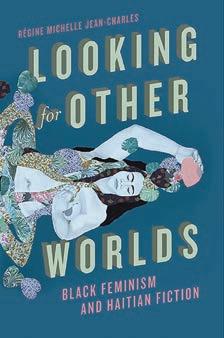
Jean-Charles grew up in Welles ley, Massachusetts, the young est child of Haitian immigrants. Her father is a physician and her mother worked at Uphams’ Corner Health Center in Boston. As a child and young adult, Jean-Charles was taught by her parents to have pride in her Black identity and to be curi ous about African American history. She also received “informal lessons” in resistance from learning about the history of Haiti, where in the
As a Milton student, JeanCharles was exuberant—she per formed on the speech team and loved to sing and dance. She wrote for The Milton Paper and used the platform to call out racism. Follow ing Milton, she attended the Uni versity of Pennsylvania and then Harvard for her doctorate.
While in Philadelphia as an un dergrad, Jean-Charles, who was raised Catholic, was introduced by friends to Protestant church ser vices, which helped her “develop a more personal and passionate rela tionship to faith that was not dic tated by the institution of religion,” she says. Today, practicing her faith is another opportunity to be in com munity and feel collective support.
That spirit of collectivism has been a thread that Jean-Charles fol lowed from her days as a student to her vocation as a professor and aca demic administrator. Today, she sees how gathering, learning together, disagreeing with one another, and being vulnerable with others are all practices she values as an educator.
“So much of teaching is about communication and being in com munity,” she says. “And I’ve always been someone who enjoys learn ing. To be a teacher is to always be learning.”
28 Milton Magazine


30 Milton Magazine
SOCIAL INNOVATOR ERIC SCHWARZ ’79 HAS SPENT HIS CAREER HELPING TO LEVEL THE PLAYING FIELD.

THINKING
Big
Story by Sarah Abrams Photographs by Ken Richardson
31Fall/Winter 2022
sitting in the bright, airy head quarters at College for Social Inno vation in downtown Boston, ERIC SCHWARZ ’79 describes what has driv en him over the past several decades to envision and create two experi ential learning programs that give students from underserved commu nities some of the same opportunities that their more privileged peers have.
“We have a huge, unacceptable, and growing achievement gap,” Schwarz says, “and the fact that it’s so big—that it’s holding back our economy and our democracy—has less to do with a student’s in-school or in-college experiences and more to do with their out-of-school ex periences. It’s the robotics camps, tutoring, foreign trips, and fancy internships that wealthier parents can afford to give their children.”
To help bridge that gap, Schwarz established over the past 25-plus years two successful programs: Cit izen Schools, a middle school men torship program, and, more recently, College for Social Innovation, a col lege-credit internship program that offers students, particularly under represented students, a semester of hands-on work experience at Bos ton-area organizations addressing societal problems.
Schwarz speaks candidly about the impact that privilege has had on his life. His father, FRITZ SCHWARZ ’53, a corporate trial lawyer, and three uncles, all Milton graduates, are heirs to the fao Schwarz toy store family. His mother, MARIAN LAPSLEY CROSS ’56, a lifelong edu cator, has ties to Milton that go back generations. Private schools, sum mer camps, and a host of unpaid in ternships, Schwarz says, all helped him to discover talents, build skills,
and develop confidence as he moved from adolescence into adulthood.
An internship with Colorado U.S. Senator Gary Hart, in 1980, Schwarz asserts, changed the course of his life. For two summers, while a student at the University of Ver mont, Schwarz interned for Hart’s successful re-election campaign and then in his Washington, D.C., office, helping to craft campaign materi als, organize a benefit rock concert, put together a network of student get-out-the-vote volunteers, and write position papers on various issues. In his last semester, in 1983, he was named student director of Hart’s campaign for the Democrat ic presidential nomination.
“What an amazing job it was for a college-age kid,” Schwarz says, looking back. “From my apartment up in Burlington, Vermont, I was organizing college students across the country and building skills that turned into a job after graduation.
If I think about those internship ex periences while in college, I think I learned five times as much as I did in all 32 of the college classes I took put together. Human beings learn best and learn most from experienc es and relationships, and yet we’ve structured schools and colleges to not be enough about experiences and relationships.
“Those learning-by-doing op portunities that I had access to— in part because of who my parents were and who my parents knew— helped change my life. I had access because my dad knew Gary Hart and was able to make that connection. Both those internships were unpaid, but I was able to get financial sup port from my family. We really need to take a new look and think about
In 2016, Social Innovation Fellow Markiesha Duverneau worked in Boston as a coach at Playworks New England, a nationwide program that promotes safe and healthy play in underserved communities. A graduate of Clark University, Markiesha says her semester with College for Social Innovation showed her the importance of being open to learning and working outside your comfort zone.

32 Milton Magazine courtesy of college for social innovation
Social Innovation Fellow
Markiesha Duverneau The Croft School Boston Operations Manager
Internships with U.S. Senator Gary Hart (below, right) provided Schwarz with invaluable experience as a college student.

“What an amazing job it is was for a college kid,” Schwarz say.
what are those experiences and men tor-rich relationships that have his torically accelerated learning and opportunity for privileged kids.”
Schwarz was determined to find a way to make life-changing oppor tunities available to those without such advantages. After five years as a working journalist and a few years helping to build the national ser vice program City Year, Schwarz es tablished Citizen Schools in 1995. Cofounded with his former col lege roommate, Ned Rimer, Citi zen Schools, in partnership with several public schools in the Bos ton area, offered middle schoolers from low-income communities an extended day— a “second shift”— that connected students with a net work of volunteer citizen teachers. From software engineers to invest ment bankers to videographers and environmentalists, community lead ers worked alongside middle school ers on a range of hands-on projects. Rigorously evaluated and fine-tuned over the years, the hugely success ful program has grown to include partnerships with public schools and community programs from across the country, today reaching 50,000 middle school students and including 25,000 career mentors. A master’s degree-level fellowship program—Citizen Schools Teach ing Fellows—provides assistance to the program’s teachers and students.
After 20 years at Citizen Schools, Schwarz turned over leadership in 2015 (he now sits on its board) to establish College for Social Inno vation (cfsi). It offers a hands-on, in-college fellowship program to
provide students with a “Semester in the City” (sitc) experience. Stu dents from small private colleges to large, public universities earn a se mester of credit working at orga nizations around Boston that are addressing urgent societal prob lems. The students—Social Inno vation Fellows—work for 30 hours a week for 15 weeks at nonprofits, government agencies, and social mission-oriented businesses fo cused on issues from the environ ment to education policy to prison reform and affordable housing.
Establishing cfsi, Schwarz says, was a continuation of his belief in the power of experiential learning and its capacity to be life-changing.
“The reality is that colleges all give lip service to experiential learning,” he says, “but for the most part they make it extracurricular. And when it’s extracurricular, as opposed to curricular, when it doesn’t have credit attached to it, it ends up be ing accessed mostly by privileged kids. People who already have a lot of privileges get amazing intern ships and amazing mentors. They get a huge leg up and are already starting ahead.
“What we’re doing with cfsi is making that kind of intensive ex periential learning—with mentors, special projects, and real-world ex periences—common, not rare. In stead of going to Barcelona, they come to Boston and are getting re al-world experience in a sector of the economy that is making a ma jor impact in helping solve the prob lems that are critically important to the younger generation.”
With the nonprofit sector the fastest-growing part of the econ omy, Schwarz says, cfsi offers
33Fall/Winter 2022
“WE REALLY NEED TO THINK ABOUT WHAT ARE THOSE EXPERIENCES AND MENTOR-RICH RELATIONSHIPS THAT HAVE HISTORICALLY ACCELERATED LEARNING AND OPPORTUNITY FOR PRIVILEGED KIDS.”
students enormous career oppor tunities. “In Massachusetts, 19 per cent of all jobs are in the nonprofit sector,” Schwarz says. “The truth is that in many industries, there is more wealth but fewer jobs, because robots and people in other countries have taken a lot of the jobs. In the worlds of health care, education, so cial work, you can’t have a robot do the job, you can’t have someone in China do the job, so you need more people. Even when the economy goes through downturns, the non profit sector continues to grow.”
In just seven years, cfsi has suc ceeded in forming partnerships with 13 Northeast schools, from private schools such as Colby College, Whea ton College, and Wesleyan Univer sity to public universities such as UMass Amherst, the University of New Hampshire, and the Universi ty of Vermont. At the same time, the program has grown to include 164 social-sector partners. Over the next few years, cfsi’s staff of 20 will be working to double enrollment (from 112 to 225) and continue to increase the number of its partner schools. A parallel program, Semester for Im pact, in which students can intern in their home college communities, will begin in 2023.
bucket in terms of all the college students who are out there. The goal is to build a model that others can learn from and that inspires other colleges to do similar things.”
Schwarz is always available to hear from those with new ideas for making a difference. He says, “Whenever someone calls and says, ‘I’m thinking of starting this organi zation. Can I get your advice?’ or if someone calls and says, ‘I know this person who’s trying to start this or ganization,’ I say yes 100 percent of the time. I love to have those con versations, because it can be kind of lonely starting something. A lot of people took the time to talk with me, and I want to pay that forward.”
As witness to the difference ex periential programs such as Citi zen Schools and cfsi can make in the lives of young people and ulti mately to society at large, Schwarz looks toward the future with opti mism. “Probably the mental makeup of a social entrepreneur or a social innovator is that you see the glass as half full, not half empty. Change is more likely to happen if you believe change is possible. If you are just dis couraged by all the very real prob lems in the world, discouragement just begets more discouragement, and you get a downward spiral.
Looking ahead, Schwarz not only wants cfsi to continue to grow; he also wants the program to serve as a model for other social innova tors who are determinded to make a difference in solving complex so cietal issues. “We want to create a model that others can learn from and adapt, because even if we grow, we’re still going to be a drop in the
“The problems are real and they’re huge and in some cases they’re getting bigger, but the solu tions are amazing too. Not just our solution; so many creative solutions are out there, and every problem we see is being solved somewhere in the world, somewhere in this country.
I do believe people want to do the right thing. And if we can give peo ple examples of a better way, then change becomes more possible.”
Mel Nagashima Boston Foundation Communications Assistant
A 2022 graduate of the University of New Hampshire, Mel Nagashima believes his new job at the Boston Foundation is due in part to the connections he made as a Social Innovation Fellow working at the Chinatown Neighborhood Center. A lesson learned, he says, is the importance of increasing your social capital: “When we have a network of relationships that work to achieve a common goal, it can help make society a better place.”
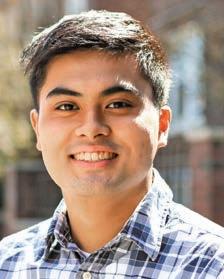
34 Milton Magazine
Social Innovation Fellow
courtesy of college for social innovation
“ THE MENTAL MAKEUP OF A SOCIAL ENTREPRENEUR OR A SOCIAL INNOVATOR IS THAT YOU SEE THE GLASS AS HALF FULL, NOT HALF EMPTY. CHANGE IS MORE LIKELY TO HAPPEN IF YOU BELIEVE CHANGE IS POSSIBLE.”
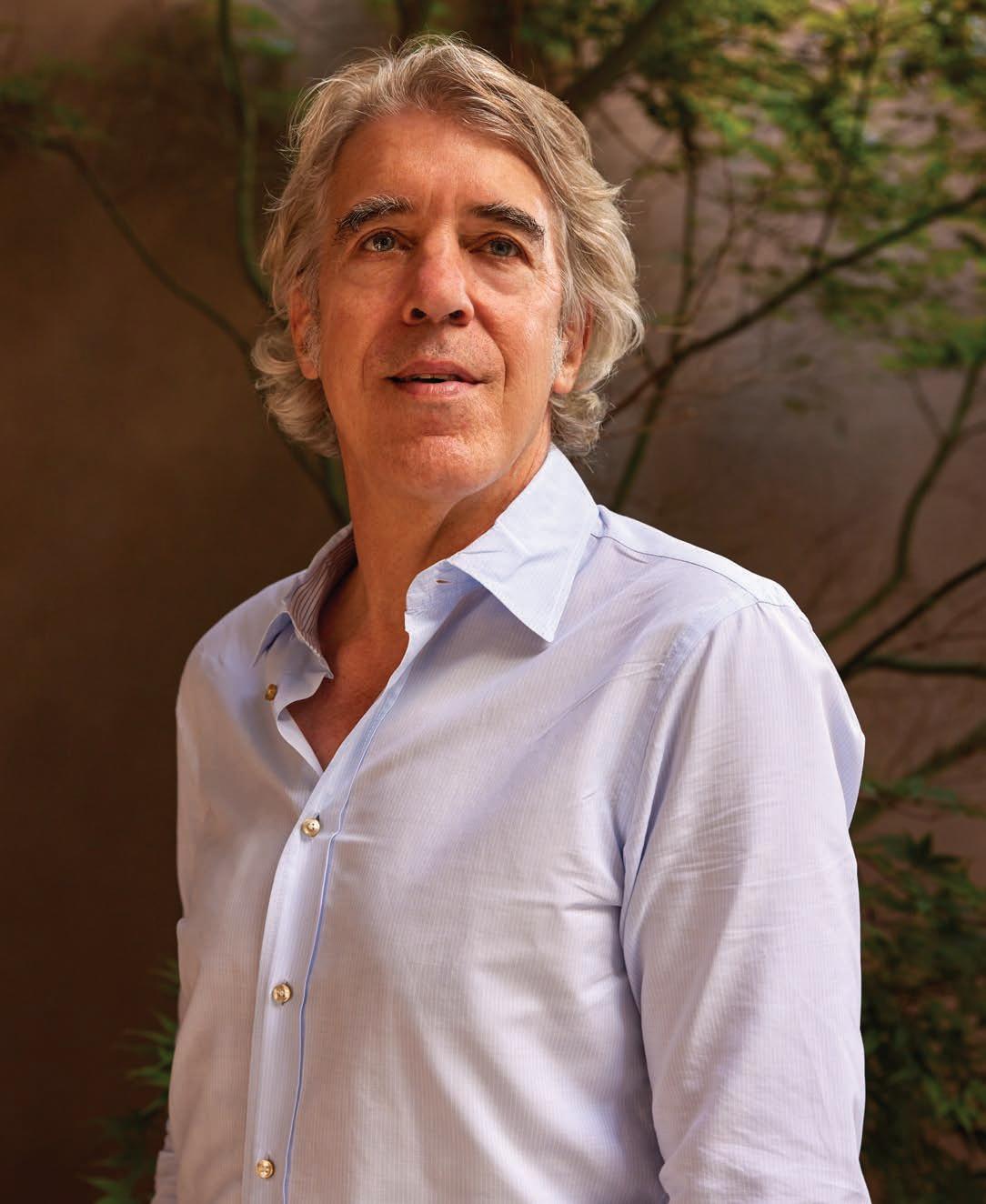
credit
On Centre
Student Life at Milton
36 Milton Magazine
37illustration by Rob Wilson Fall/Winter 2022
Coaches Are Teachers Too
COACHES PLAY A CENTRAL ROLE IN A STUDENT’S EDUCATION. BY MARISA DONELAN
from his office in the Athlet ic and Convocation Center, Athletic Director Lamar Reddicks has a con stant, daily view of the comings and goings of student-athletes, coaches, and visitors.
Whether they stop by his almost always-open door or are just pass ing through, Reddicks, who is also the head coach for the boys’ varsi ty basketball team, can get a quick read on them.
“I can tell by the way a kid walks through here whether they’re hav ing a good or bad day,” he says.
lead and relate to students is a pri mary qualification.
“When we have new hires, I have to explain to them how different Milton is compared with a lot of places,” Reddicks says. “Our kids are really smart. They have a lot of in terests and other extracurriculars. So you might have a student who’s great at your sport, but they’re also great at something else that takes up a lot of their time. There’s a lot they have to balance.”
Kevin Macdonald, head coach of the boys’ varsity football team.
Above, Cormac Ryan ’18 (left) in action for Notre Dame

Coaching at Milton involves much more than guiding students through physical training and tech nique. Many coaches teach or work on the staff at the school; others are dorm faculty members and advi sors. Informally, they act as coun selors, surrogate family members, and sounding boards on everything from academics to college selection to personal issues.
A Milton coach, first and fore most, must be good with kids, says Reddicks. Those who coach at the highest levels also have to be mas ters at their sports, but an ability to
CORMAC RYAN ’18 recalls a hard lesson Reddicks taught him about leadership. Reddicks pulled Ryan, now a captain of the Notre Dame men’s basketball team, from an ear ly-season game against Governor’s Academy because of Ryan’s attitude toward the officials and Reddicks. Ryan was a rising star at the time, getting a lot of attention from col lege recruiters, and he complained that the referees weren’t being fair.
“The next day, Reddicks called me and the other seniors into the locker room for a meeting and said, ‘I’m considering taking away your captainship, because that’s not how a captain behaves,’” Ryan recalls. “‘If
38 Milton Magazine courtesy notre dame athletics
“Some of the best teachers I’ve known have been outstanding coaches and vice versa.”
illustration by Eric Palma
On Centre Upper School

you want to be a leader, you have to act like a leader at all times, not only when things are going well.’”
Each season, hundreds of Milton students play a sport, whether they compete against other schools in In dependent School League matches or play intramurally. Some of the more popular sports, such as soccer, offer opportunities for students to play at different levels, from fresh men teams to varsity. Chris Kane, head coach of the boys’ varsity soc cer team, says that the high rate of participation gives coaches the ability to build a strong communi ty around sports.
“The expectations we set for stu dents around being a good person, working hard to improve, being selfless to the needs of the group, being a good communicator, re silience, inclusivity, and positivi ty are all qualities we try to devel op through the game,” says Kane, who also works as the director of financial aid in the school’s Admis sion Office. “Those are all import ant qualities for students outside the athletic arena as well.”
Given the amount of time stu dent-athletes practice, plus the travel time involved in away games and tournaments, a coach may be the adult a student sees the most, Red dicks says. It takes serious dedication on the part of coaches—many of whom work well into the evenings and on weekends during their sea sons—so a team’s culture is critical.
“I spend more time in the winter with the kids on the basketball team than with my kids at my house,” he says. “That’s real, and that’s not a small thing. So it’s really important to me that they’re good kids, and that we build a strong foundation.”
Coaching mirrors other aspects of education at Milton, says Kane. Teachers place a strong emphasis on markers of a student’s growth over the course of a class; coaches want to see similar growth over a season.

“We try to frame our accom plishments around growth and im provement rather than outcomes and end points,” he says. “We use soccer as a means for development, professionalism, commitment to the collective group, honesty about strengths and weaknesses, and thoughtful planning as you seek to improve. Those are the qualities that I think are most essential to success
in soccer but are even more beauti fully key factors for success in oth er parts of life.”
Kevin Macdonald, head coach of Milton’s varsity football team, has worked with dozens of coaches over the years, many of them former ath letes he coached, and many who are classroom teachers.
“I think coaching and teaching are one and the same,” says Macdon ald, who has coached and taught at Milton for 27 years and plans to re tire after the 2022 season. “Some of the best teachers I’ve known have been outstanding coaches and vice versa.”
Rachael Abernethy, an English teacher and assistant coach for girls’ varsity soccer, wrote her master’s thesis on the ways in which coach ing soccer informed and shaped her English teaching practice.
“I was studying authentic assess ments and learning how you can do little things in your classroom to make your students feel known, and seen, and valued, and then to prioritize what they want in their learning and assess them in a way that matches that,” Abernethy says. That focus on fundamental skills along with individualized devel opment helps athletes grow as well.
When recruiting football play ers, Macdonald looks closely at their grades. Milton’s academic de mands—combined with the time it takes to compete at the varsity lev el—mean that students have to work hard in their classes as well as on the field and in the gym.
“I’ve always hated the stereo type of football players as dumb jocks,” says SAM JAFFE ’22, one of the captains of the 2021 varsity team, which won the Independent School
40 Milton Magazine
“We try to frame our accomplishments around growth and improvement rather than outcomes and end points.”
Chris Kane (above), head coach of the boys’ varsity soccer team
evan scales,
john gillooly, michael dwyer
On Centre Upper School
League championship and was un defeated in the regular season. “I’ve done everything I can to flip that narrative about myself and my teammates.” Jaffe’s teammate LUKE THORBAHN ’22 says playing football has been a way to get access to good schools: “I was able to use the game I love to get an education that will last a lifetime.”
For high-achieving people like Milton students, sports provide nec essary exposure to failure and loss, says Kane. An athlete can do every thing technically correctly, can prac
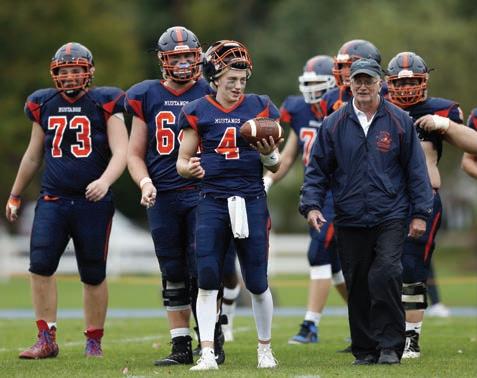
tice and improve over long periods of time, and still lose. Coaches play a critical role in helping students learn from those moments. “Sometimes the best qualities you see in athletes come out in the moments where suc cess does not happen,” Kane says.
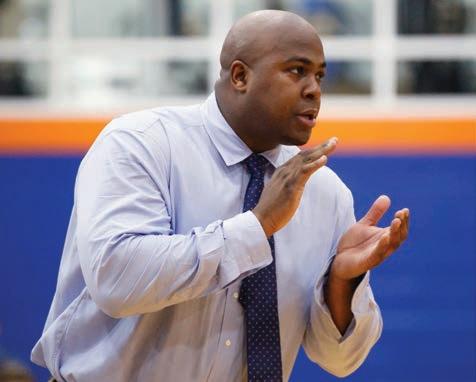
Abernethy agrees, saying, “I think it’s difficult to form a grounded sense of what it means to be successful if you have never failed.”
Developing athletes into good players comes with building their character along with their physical ability, says Amy Hickey, who is the
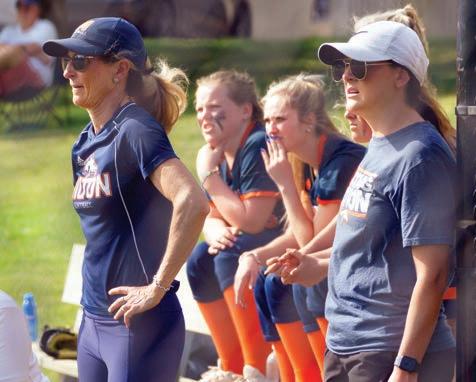
head coach of girls’ varsity softball and also serves as assistant coach on the girls’ field hockey and hock ey teams. Hickey has coached and taught physical education at Milton for two decades, and has witnessed some changes in how students ap proach athletics. As the college ap plication process becomes increas ingly competitive and students’ social interactions take place on line and in real life, the time it takes to train for and excel at a sport be comes even more precious.
“It’s so important to have real
connections,” Hickey says. “And when you’re on a team together, you have a deep connection, because you’re going through all this phys ical work—the blood, sweat, and tears—together. Our kids take on so much, and have so many commit ments, and so, as a coach, I’ve tried to focus more on the player as a whole, looking at their whole personality, the whole spectrum of what they’re doing. We’re still setting goals, and we’re still trying to win games, but it’s really about getting the kids to reach their potential.”

41Fall/Winter 2022
Clockwise from top left: Rachael Abernethy, girls’ varsity soccer assistant coach; Kevin Macdonald, varsity football head coach; Amy Hickey, girls’ varsity softball head coach; and Lamar Reddicks, boys’ varsity basketball head coach and athletic director
A Commitment to Mental Health
Frank Patti (above), Lower School principal
LEARNING HAPPENS BEST WHEN STUDENTS FEEL SAFE AND CALM, SAY MILTON’S LOWER AND MIDDLE SCHOOL PRINCIPALS. BY SARAH ABRAMS
mental health care authori ties—from the American Academy of Pediatrics to the American Academy of Child and Adolescent Psychiatry— have been reporting a precipitous na tionwide rise in the levels of stress and anxiety among school-age chil dren. In 2021, citing recent nation al surveys, the U.S. surgeon general reported “alarming increases in the prevalence of certain mental health challenges” of the nation’s youth.
For both Lower School Princi pal Frank Patti and Middle School Principal Steven Bertozzi, caring for the emotional well-being of Milton students is central to their mission.

“Anyone who’s studied elementary education,” says Patti, who recent ly implemented a multifaceted ap proach to providing mental health support for Milton’s youngest stu dents (kindergarten through fifth grade), “knows that learning for young children is a social and emo tional thing and that mental health is really connected to every part of the learning process.”
To most effectively meet their needs, the Lower School recently formed a partnership with the In
tegrated Center for Child Devel opment (iccd), a multidisciplinary enterprise that provides a range of mental health services, from neu rological to behavioral to occupa tional. An on-campus iccd mental health specialist works with Direc tor of Health and Wellness Valerie Thadhani to help connect students and parents with the correct iccd specialist.
“Children at five, six, and seven years old require a different type of attention than they do later,” says Patti. “So much is emerging that needs attention and tailored support; we’re learning about their develop mental needs and learning profiles. There are a lot more adult-to-adult conversations. By partnering with iccd, we’re creating a structure so that mental health can really be at the center of all the work we’re do ing. We’re thinking holistically, as we should be.”
At the Middle School, adminis trators and teachers are committed to providing “the time and space to know each child,” says Bertozzi. “To get to deep learning, it’s important to ask, ‘Do students feel safe and sup
ported? Is their mental health in a place where they can engage and learn in a really deep way?’ We want to know the whole child and commit the time and space for that.”
Students (sixth through eighth grade) meet twice a week in small groups for “informal check-ins” with a designated advisor to dis cuss what’s on their minds. Twice a month, students attend “360” classes with Middle School counselor Nicci King, who discusses social/emotion al issues, and the learning special ist Liz West, who teaches executivefunctioning skills. A “Time-in” gives students the space to slow down af ter a busy week. Weekly grade-level meetings—which include Bertozzi, Middle School Dean of Students Jacqui Hardaway, King, and West— are held to discuss the students. “We try to be very intentional to create a breadth and depth of opportuni ties to allow them to pause and fo cus on mental health,” says Bertozzi.
The past two years, say both prin cipals, have seen a delay in the de velopment of the students’ executive functioning skills. When Lower and Middle School students returned to
42 Milton Magazine
“Anyone who’s studied elementary education knows that learning for young children is a social and emotional thing and that mental health is really connected to every part of the learning process.”
gregory white illustration by Brian Rea
On Centre Lower School

campus in the fall of 2020, a pre ponderance of important health-re lated rules and regulations were in place. The loss of freedom and so cial interaction during this time, they say, has caused a delay in their abili ty to organize, reason, and problem solve. Patti tells the story of a firstgrade teacher who, as rules relaxed last spring, encouraged students to sit in a circle on the carpet. “That’s very big in elementary education,” Patti says. “Sitting around in a cir cle is very collaborative. The teach er was stunned to discover, howev er, that the students had never sat in
a circle before. They’d gone through preschool, kindergarten, and now first grade without sitting in a cir cle. During the years of the pandem ic they were six feet apart, wearing masks and their desks in rows. The teacher had to show them.”
“For a whole academic year,” says Bertozzi, “students were divided into cohorts, unable to interact with one another across groups. Belongings were stored in bins under desks, and at recess, students were divided into groups that couldn’t cross lines to be closer to one another. We told them when they were dismissed and when they could leave the room. This is not a school that does that often.”
“Milton is a place,” says King, “that values and promotes inde pendent thinking, but the pandem ic made that challenging. When you look back, the need to be so hyper vigilant—which we can all do for a period of time, but was just so pro longed during the pandemic—really impacted students’ bandwidth. The silver lining is that students came away from the past few years with permission to seek support.
“Lots of students named their heartache related to opportunities and experiences they weren’t able to have,” King says. “They were able to openly name their feelings and frustrations. Kids were knock ing on my door just to say, ‘Today is a hard day.’ Did that happen pre-pan demic? Sure, but the community sup port for it did shift; there was just less stigma. As Todd [Bland] often says, ‘Don’t worry alone.’ The mes sage to students was that there was no need to attempt to navigate solo; you really can seek out support. And they did, which is good for them selves and for each other.”
And neither principal is seeing a loss in academic progress. “While academic regression felt like it was going to be the story,” says Bertozzi, “it really hasn’t been. Kids are com ing in just as strong from fifth grade, and I think we’re sending them just as strong to the Upper School.” Says Patti, “In terms of gaps as a result of the pandemic, we have not noticed any sizable gaps in understanding. Our kids are as strong academical ly as the year before.”
Going forward, teachers and counselors will be working to help students recover the ground they’ve lost in developing executive-func tioning skills. “In our preparation for this year,” says West, “we’re in tentionally thinking about what are the executive-functioning demands we can take off of our kids. What can we streamline and what can we model in terms of positive execu tive- functioning skills acquisition. For example, we are requiring teach ers to all post in the same way on Google Classroom so that students know exactly where both classwork and homework are for every class.”
While the past two years have brought indisputable challenges, says Bertozzi, they have also yield ed surprising gains. “I see a strength in the students now. They’re tough er; they’ve developed coping strate gies and are joyful in ways I haven’t seen in a long time. They’ve come out of it and are recognizing how things used to be, and it has become, to some degree, a place of joy. We’ve really tried to lean into the joy and scale things back a little bit, realize we can take things a little slower, take ourselves a little less seriously, and be a place to really help them grow as individuals.”
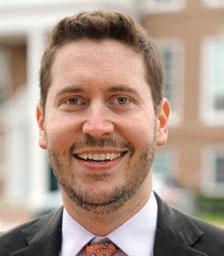
Students Talk About Mental Health
On a day held every spring on the Middle School cam pus, Milton students step away from their routines to participate in Focus Day, when they have a chance to consider matters of importance to them. Past Focus Days have centered on issues such as microag gressions and bullying. This year’s topic: mental health.
“After all that has oc curred in the past couple of years,” says eighth-grader Amelia Simoneau, a mem ber of the Middle School DEIJ committee, which each year chooses the day’s topic, “we thought mental health should be the focus.”
Gathered in small groups, the sixth-, sev enth-, and eighth-grad ers attended workshops focused on depression, anxiety, and emotions. Organized by the students, who prepared the materials and led the discussions, the workshops offered a wealth of mental health information and scenarios to think about. Students considered various ways of responding to a variety of mental-health concerns for themselves and their peers.
By all accounts (a survey was issued to students), the day was a success. “The really important part of the workshop was just giving them the chance to talk about their own mental health,” says Simoneau. “The kids I talked to said it was a really valuable ex perience just to have a day devoted to understanding and acknowledging mental health and that it’s not something you should be ashamed to talk about. It’s something that exists and that you shouldn't ignore.”
44 Milton Magazine gregory
white (left) john gillooly (right)
On Centre Lower School
“To get to deep learning, it’s important to ask, ‘Do students feel safe and supported? Is their mental health in a place where they can engage and learn in a really deep way?’”
Steven Bertozzi (above), Middle School principal
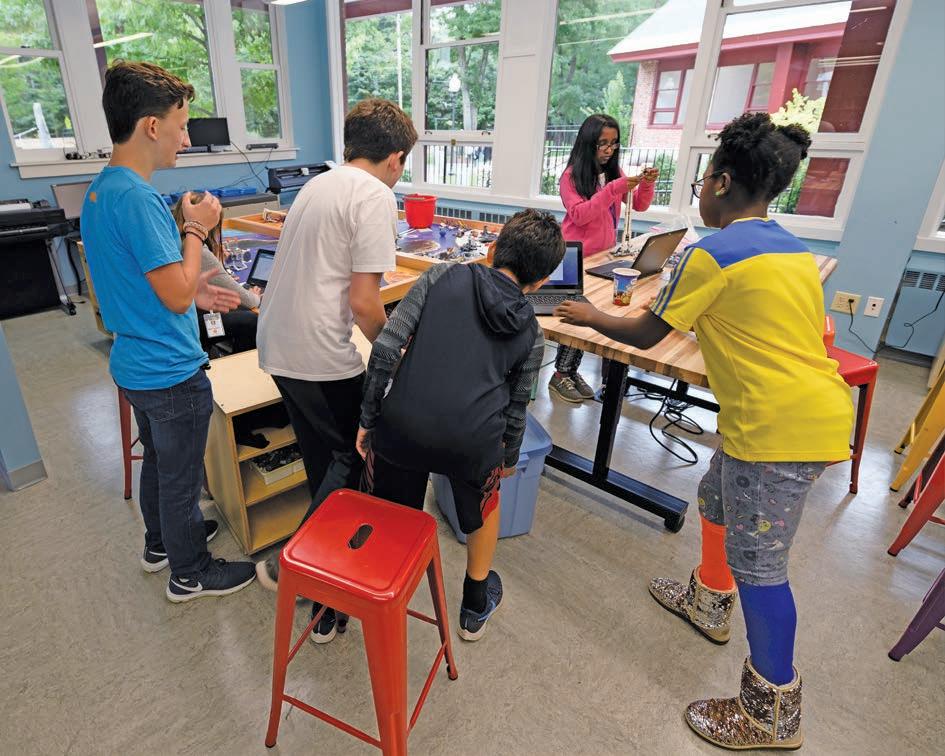
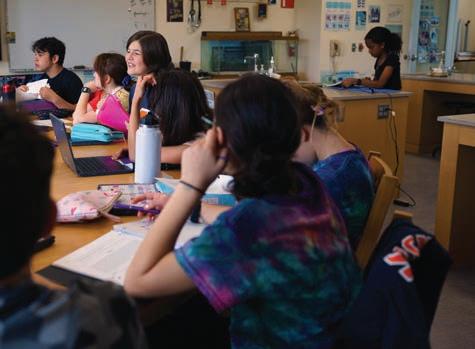
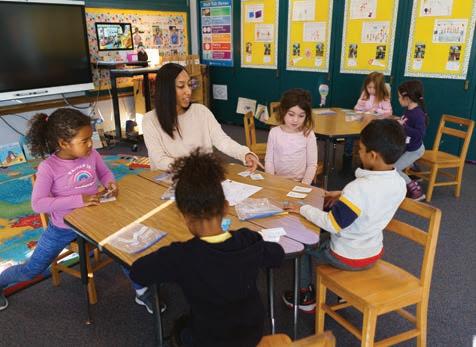
45Fall/Winter 2022
In the News

46 Milton Magazine
Alixe Callen ’88 Appointed 13th Head of Milton Academy
ALEXANDRA (ALIXE) H. CALLEN ’88 will begin service as our next Head of School on July 1, 2023. Below is the school’s June 8 an nouncement:
Alexandra (Alixe) H. Callen ’88 has been selected by the Board of Trustees to be Milton Academy’s 13th head of school, effective July 1, 2023.
Callen, a Milton gradu ate with extensive teaching and leadership experience in both public and independent schools, currently serves as the head of St. George’s School in Middletown, Rhode Island, a position she has held since 2017.
During her time at St. George’s, Callen and her team undertook a full-scale effort to review and renew the school’s curriculum to support interdis ciplinary and connected learn ing, prioritizing strong aca demics and reflecting the latest research in education. In collab oration with the school’s most veteran faculty, Callen formed the Senior Teaching Cadre and has energized pedagogical and professional development through dedicated programs for teaching and learning. She led the development of St. George’s current strategic plan, campus master plan, and the school’s first diversity, equity, and inclusion strategic plan. Her team also launched the Beloved Community Initiative, a program focused on the history of St. George’s and the experiences of students across diverse identities. Over the past five years, she has collaborated
with the school’s advancement office to raise more than $20 million to support new capital projects, including two new turf fields and the restoration of the Memorial Schoolhouse. She has overseen all aspects of the school’s operation, including academics, student life, equity and inclusion, finance, ad vancement, admission, college counseling, and athletics.
“Alixe Callen is a leader and intellect who combines innate curiosity and careful listening with a strong desire for action and the courage to push for positive change,” said CLAIRE HUGHES JOHNSON ’90, chair of the Head of School Search Committee and incoming Board of Trustees president. “With her sound judgment and inclusive style, Dr. Callen’s enthusiasm for delivering a stellar environ ment for student learning will permeate all aspects of educa tion and school life and will help her excel as the next leader of Milton Academy. She embrac es the constantly developing advances in pedagogy and curriculum development and is unafraid to ask bold ques tions and seek positive change. As a Milton graduate, Alixe’s connection to and love for our school underpin her strong commitment to continuing our ongoing work to build the best community for Milton students today and in the future.”
“I am thrilled to be named Milton’s next head of school,” says Callen. “The opportunity to follow in the footsteps of my friend and mentor Todd
Bland is a tremendous privi lege. Thirty-five years ago, the Milton faculty challenged me to become a critical thinker, eloquent communicator, and inclusive and thoughtful leader. The lessons they imparted con tinue to inspire me every day. To be chosen as the School’s next leader is the highest profession al honor I can imagine. Thank you to the search committee and the Board of Trustees for this incredible opportunity. I am humbled and delighted to be entrusted with the future of my alma mater.”
Milton Trustees unanimously supported the recommendation by the Head of School Search Committee to hire Callen, following a rigorous search that considered several highly qual ified school leaders. Callen’s experience and ability to look into the future and navigate changes in pedagogy and ed ucation—along with her focus on student-centered curriculum development, collaborative approach to leadership, and en thusiasm for building communi ty—were among the many posi tive attributes noted during the selection process. The Search Committee and Milton’s Trust ees were additionally impressed with Callen’s motivation to champion Milton’s intentional, deeply held commitment to building a diverse and inclusive community that fosters an un derstanding of injustice and a common goal of fair, equitable practices for all.
As part of a long-planned succession strategy, Head of
School Todd Bland will remain in his role at Milton through June 2023 and will work with Callen and Milton’s Board of Trustees to ensure a smooth transition of leadership as his tenure ends.
“Alixe is the right leader at the right time for Milton Acad emy,” said Board of Trustees President LISA DONOHUE ’83. “She has proven to be a decisive ad ministrator who values collabo ration and she places students at the center of all her work. I have full confidence that Alixe will continue the excellent prog ress that Todd has made and continues to make at Milton and I look forward to a bright future for our school.”
“I have been delighted to know Alixe for the past 25 years and appreciate her as a tremendous friend and extraor dinary fellow educator,” said Bland. “I could not imagine a better next head of school for Milton Academy than Alixe. She combines the very best qualities of heart and mind, and I am so excited to support her leadership at our wonderful institution. I look forward with great enthusiasm to working with Alixe over the next year to provide the smoothest transi tion possible for Milton.”
Callen received her bachelor’s degree in American civilization from Brown University, a master of arts in teaching degree from Brown, a master’s degree in administration, planning, and social policy from Harvard Uni versity, and her doctorate from Harvard, where she was elected to the Harvard Educational Re
47Fall/Winter 2022 LEADERSHIP
view. Prior to St. George’s, Callen was the upper school director at Lakeside School in Seattle, the principal of Acton-Boxborough Regional High School, in Acton, Massachusetts—a 2,000-stu dent public school consistently rated among the best in the state—and assistant principal of Needham High School, in Need ham, Massachusetts. She has also held leadership, teaching, and research positions through the Harvard Graduate School of Education; the Francis W. Parker Charter Essential School in Devens, Massachusetts; the Se dona-Oak Creek Unified School District in Sedona, Arizona; and the Coalition of Essential Schools.
Remembering Faculty Member and Outdoor Program Director Kendall Chun (1963–2022)

Kendall Chun passed away April 26 after a recurrence of cancer. A faculty member in the Computer Science Department, Chun also served as director of the H. ADAMS CARTER ’32 Outdoor Program, leading Milton students on hik ing, climbing, biking, and boat ing trips all over Massachusetts and New England, along with excursions in several national parks and abroad.
Before becoming a teacher, Chun received his undergraduate degree in electrical engineering and worked in the biomedical in dustry. His love for the outdoors was sparked at a young age, and he passionately encouraged Mil ton students to explore, instilling in many a deep and lasting ap
preciation for the natural world.
Chun’s family and friends hosted a celebration of his life on campus on May 22, where many shared stories of his influence, adventurous spirit, and genius in creating everything from a working electric guitar to aug mented-reality displays. In ad dition, a group of Upper School students finished construction and programming of a project they had started with him in an off-campus workshop, the Milton Makerspace. The project is an ar cade game with access to more than 12,000 classic arcade titles. It will be permanently installed in the Schwarz Student Center. To read more about it, visit milton magazine.org.
Marvin Gutierrez Is the First Upper School Dean of Faculty
Marvin Gutierrez became Milton’s first dean of faculty on July 1. Gutierrez comes to Milton from the Boston Public Schools, where he was principal of the James P. Timilty Middle School. He previously taught mathematics at the Cambridge School of Weston, where he also served as a teacher coach. Gutierrez has taught at the English High School in Boston, Brighton High School, the Bos ton Day and Evening Acade my, and the Baltimore Public Schools. He received bachelor’s degrees in mathematics and secondary education from the University of Rhode Island, a master’s in science education from Boston University, and a master’s in learning science from Worcester Polytechnic Institute.

On Centre In the News LEADERSHIP
IN MEMORIAM
gage skidmore; ian torney; marisa donelan
Cornel West Meets with Milton English Students
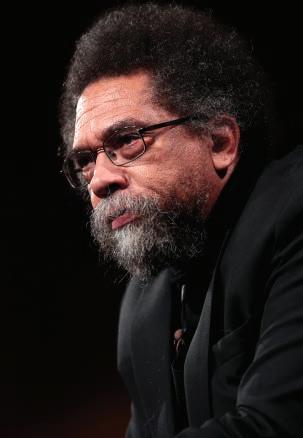
“What does it mean to be human?” philosopher Cornel West asked students. “How do we hold on to integrity in the face of oppression? How do we hold on to honesty in the face of deception? How do we hold on to decency in the face of insult and assault, and how do we hold on to the enabling virtue of them all—courage—in the face of cat astrophic bombardment?” West, a renowned scholar, writer, and activist, virtually joined students taking the course Philosophy and Literature. He discussed how literature can help people under stand seemingly insurmountable challenges—or what Samuel Beckett called “the mess” of modern human existence.
■ The Nesto Gallery hosted an exhibition called Paying It Forward: Artists Who Returned to Teach. The exhibition featured works by alumni including TE PALANDJIAN ’17 (at center with IAN TORNEY ’82), JU LIA VON MENTZSCH-RAMOS ’03, EMILIE STARK-MENNEG ’02, NICOLE DARLING ’97, and SARAH SZE ’87.
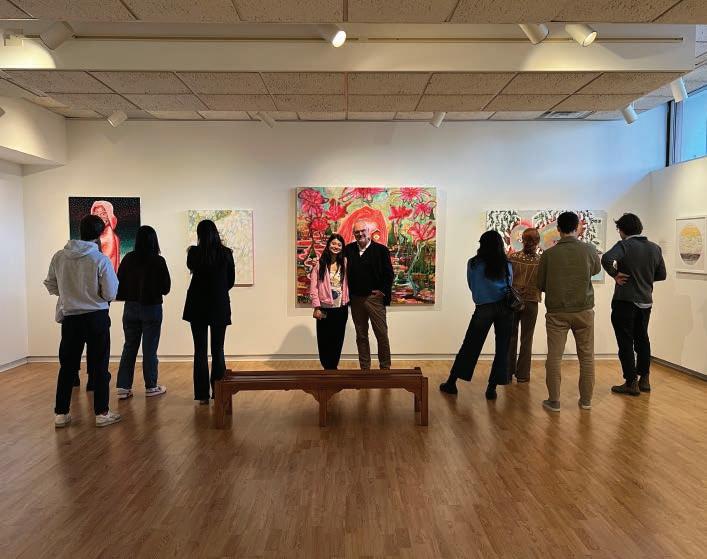
Janelle Wong Visits as Hong Kong Distinguished Speaker
Asian Americans and Pacific Islanders (AAPI) have long endured discrimination influenced by nearly two centuries of history and exclusionary laws, said University of Maryland professor Janelle Wong, who explained that law and policy play critical roles in re versing discrimination.
“The story of Asian Americans has been shaped by these two dominant stereotypes: the ‘model minority’ myth and the ‘forever foreigner’ stereotype,” said Wong, who was this year’s Hong Kong Distinguished Lecturer. “Those stereotypes are the products of both history and laws. And the experiences of Asian Americans are deeply connected with other minority groups in the United States. When disparities are shaped by policy, their solutions must also come from policy.”
■ Artist and educator Endia Beal kicked off Milton’s Black History Month events. Beal spoke virtually with students about her work, which shares stories of the real lives of people of color, particularly Black people, through photographs and videos.
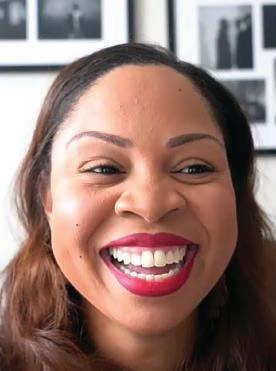
49Fall/Winter 2022
SPEAKERS
SPEAKERS
Anika Walker-Johnson Appointed
Milton’s First Director of Residential Life
Endowment Investment Policy Updates
Anika Walker-Johnson launched her boarding school career in 2001 at Tabor Academy, where she taught English and served for 17 years in both boys’ and girls’ dormitories. For four years, Walker-Johnson also served as a head class advisor, and for five years she coordinated Tabor’s community service program. In 2007, she stepped into the role of dean of multicultural education and community life, chairing the Faculty Diversity Leader ship Council and authoring the school’s statement of diversity and inclusion. She subsequently became Tabor’s first associate
director of admission for mul ticultural recruitment. In 2018, Walker-Johnson became the director of equity and inclusion at Germantown Academy, a gender-inclusive day school with 1,200 students. There she collaborated with senior ad ministrators to develop and implement the school’s equity and inclusion goals across three divisions, chaired the Equity & Inclusion Leadership Team, consulted on student disciplinary cases, partnered with counselors to support restorative practices, and cochaired the Black Family Alliance.

Milton Academy’s endowment performance is critical to the school’s current and long-term success. With a value of approx imately $400 million the endow ment contributed 18 percent of the school’s budget last year.
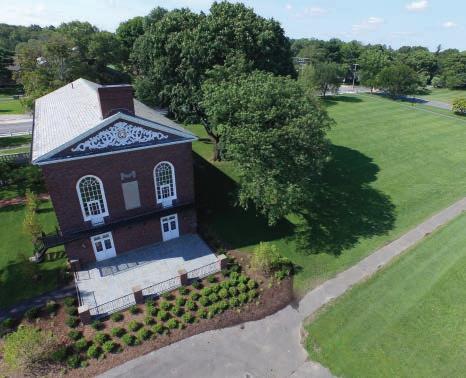
Recently, Milton Academy’s Board of Trustees discussed how the school's endowment investment decisions are made and how environmental, social, and governance factors (also called ESG factors) are con sidered as part of the school’s investing philosophy. Following a review of university, college, and other independent school best practices, the Investment Committee recommended that the school add more specific environmental, social, and governance (ESG) guidance to the school's Investment Policy Statement, which sets forth the
guidelines the committee uses to manage the school's endow ment. These guidelines require that the committee collect ESG data annually, review existing and prospective investment managers’ holdings and firm practices, and incorporate that information to better inform in vestment decisions. The Trustees approved these changes in 2021, ensuring that ESG consider ations play a larger role in the school’s investment process.
Overall, the incorporation of ESG factors into Milton’s investment policy marks an im portant step forward and places Milton in a leadership position among independent schools. It also demonstrates the school’s ongoing commitment to data-driven decision making, environmental sustainability, and diversity.
50 Milton Magazine On Centre In the News courtesy of the wheelock family theater; marisa donelan LEADERSHIP
FINANCE
Lisa Donohue ’83 Recognized with Milton Medal
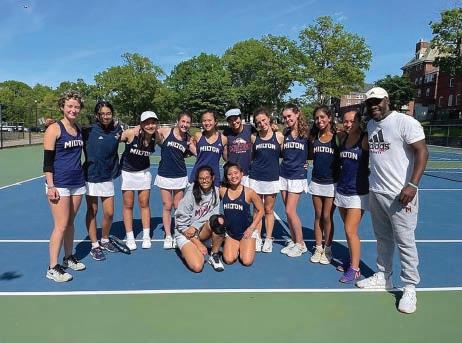

On April 30, the Board of Trust ees honored its outgoing presi dent, LISA DONOHUE ’83, with the Milton Medal, recognizing her years of leadership and dedica tion during a significant period of growth for Milton Academy. The Milton Medal recognizes extraordinary service to the school.
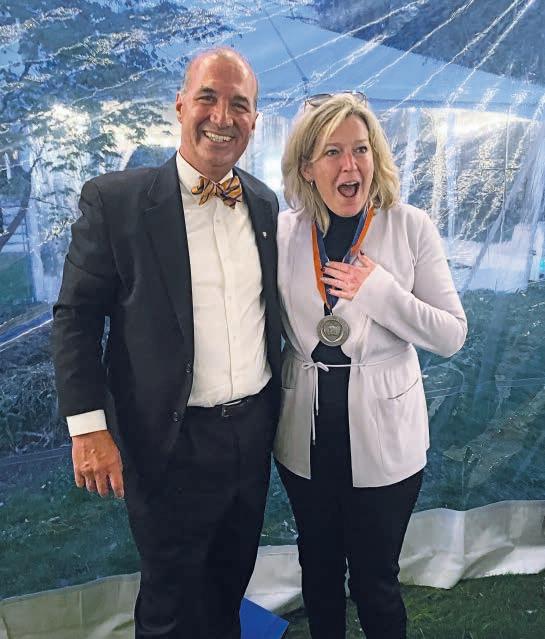
“Lisa’s incredible service to Milton clearly makes her deserv ing of this important honor,” said Board member CLAIRE HUGHES JOHNSON ’90, who suc ceeded Donohue as president
on July 1. “Lisa served Milton during a critical period, and every time the school needed more from her, she increased her level of time, energy, and dedication to Milton’s success. Although Lisa credits Milton for its positive role during a for mative time in her life, what is most impressive is her ability to separate the Milton of the past from what the school and the students most need today. Constantly guided by what’s best for the students, Lisa set an example for all of us.”

51Fall/Winter 2022 HONORS
■ LILY PARK ’23 and MAXWELL SEELIG ’22 starred in The Wizard of Oz at Boston’s Wheelock Family Theater, kicking off the theater’s 40th-anniversary season.
■ The girls’ varsity tennis team (above) finished as co-champions of the Independent School League this spring following an undefeated season. (Below) Harkness table restored by AUSTIN VYAS ’17
Graduation 2022
“Throughout the trials and tribulations of life we must encourage ourselves to be susceptible to struggle. That is the price we must be willing to pay to live authentically, to live truly.”
KAROL QUERIDO ’22
Milton awarded diplomas to 185 seniors during this year’s graduation exercises on June 10, 2022.
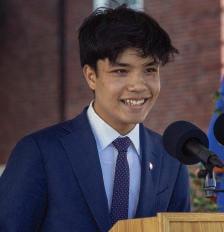
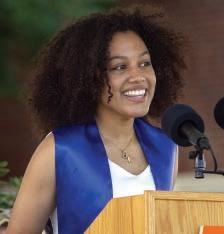
• Campbell Reynolds Abelow
• Kwabena Jack Asare Adae
• Rhea Anand
• Catherine Burke Anderson
• Dylan Burton Arevian
• Martin Steven Arias-Castillo
• Caroline Ashley Baldwin
• Matthew Jaden Baron
• Carly Lauren Bell
• Frederick Duncan Berkeley
• Alison Mary Eithne Blake
• Calvin Jones Bonomo
• William John Bordes
• Samuel Kinnicutt Borggaard
• Noah Kenneth Brenner
• Conrad Herbert Brown
• Barbara Abigail Buonato
• James LeComte Burton
• Mary Michelle Callahan
• Caroline Blake Cannata
• Alison Haichu Cao
• Evelyn Haixuan Cao
• Jake Ryan Cardonick
• Louis Bartholomew Casagrande III
• Ki Aston Chan
• Xingya Chen
• Victoria Erica Cheng
• Erich Matthew Clark
• Emmeline Grace Cobb
• Rebekah Kylander Cody
• Tamsin Claire Connerly
• Frances Lovett Corcoran
• Marisa Lynn Costello
• Lily Eve Creem
• Anna Kathryn Cressman
• Dina Sara Custo
• Ava Rose D’Ambrosio
• Ethan Brady Davidson
• Pankhuri Dayal
• Barrett Francis DeVaul
• McCoy Louis Devonish
“I hope you’ve considered that by getting too absorbed in your goals you may fail to also live a beautiful life outside of them. Don’t wait until it’s too late to recognize that.”
TYLER TJAN ’22
• Sneha Jaiswal
• Mathilde Shattuck Jaques
• Yanan Jiang
• Rickardley Rody Joachim
• Ilya Sergeevich Kan
• Samuel Kaufman
• Joonhyoung Kim
• Hannah Hanxi Kotler
• Talia T’ing Hui Kriegel
• Ingrid Elmslie Krishnan
• John Frederick Kulow
• Phyllis DuBois Ladd
• Mya Renee Lampley
• Calvin Luke Lareau
• Iliana Rosario Diaz
• Zhixin Ding
• Nathan Joseph Dixon
• Puck Henderson Doboe
• Ines Drissi Qeytoni
• William Aidan Dubois
• Gus Allan Dudley
• Samuel Henry Dunn
• Cameron Hong Edgar
• Edward James Ellis
• Haley Jamieson Englert
• Emily Grace Evans
• Victoria Maria Fawcett
• Jayne Mendelson Feeney
• Mathias Dallas Fowler
• Stephanie Fuentes
• Zoe Jane Garrett
• Sarah Elizabeth George
• Alexander Thomas Godwin
• James Patrick Whateley Good
• Olivia Anne Greenaway
• Joshua Gulyansky
• Finn Larkin Hackett
• Morgan Jacqueline Hackett
• Alec Prentiss Hamblet
• Lillian Danielle Hanly
• Zoë Mima Heard
• Ida Ayu Sakira Hermawan
• Bradley McCabe Holcomb
• John Benton Hull
• Jooahn Hwang
• Sydnee Eugenia Hyacinthe
• Sam Alexander Jaffe
Joshua Michael Lebowitz
Amelia Nicole Lee
Jae Richard Georgia Lee
Seo Young Lee
Jack Stanley Leitzes
Lucy Brooks Leness
Noah John Lippa
Chen-Chih Liu
Duncan William MacDonald
Griffin Burke MacGillivray
• Sarah Elizabeth Maciel
Sophia Andrea Mack
Claire Ming Lai Mallela
Piper Elizabeth Marshall
John Matters
Laëtitia Lowndes Maybank
Lauren Daisy McLaughlin
Ava Malinee McNeil
Catherine Rose McNulty
Lara Metri Metri
Katerina Dmitrievna Mikhailova
James Elliott Millington
Neha Yogesh Modak
Simone Shanice Moise
Boid Nako
Myles Mwatha Ndiritu
Thaddeus Augustus Bartol Noble
Ann Fallon O’Malley
Philip Chukwudi Okafor
Joshua Oluwadamilola Olatunji
Grace Shaw Panerese
Isabel Pavlonnis
• Arthur Farwell Perry
Gunner James Peterson
Henry Pikus
Zachary deSola Pool
Jackson Sewall Tillinghast Potter
Emma Victoria Pottow
Katheryn Anne Prather
Sophia Ann Putnam
Karol Pereira Querido
Gavin Elliott Randolph
Luke Garrett Randolph
Henri Raphael Richter
Elodie Irina Root
Mallory Rae Rubin
Aoidin Julia Salmon
Zachary Sardi-Santos
Christopher David Scanlon
Ava Gray Scheibler
Maxwell Beck Seelig
Yavuz Shahzad
Ameen Ahmad Sheikh
George English Sherbrooke
Talia Maya Sherman
Katherine Elizabeth Shih
Zoe Elizabeth Zimmerman Shleifer
Daniel Joshua Siegel
Riya Singh
Elliot Russell Smith
Jackson Joseph Smith
Quinn Sanae Smith
Zachary Porter Stayn
52 Milton Magazine michael dwyer GRADUATION
On Centre In the News
•
•
•
•
•
•
•
•
•
•
•
•
•
•
•
•
•
•
•
•
•
•
•
•
•
•
•
•
•
•
•
•
•
•
•
•
•
•
•
•
•
•
•
•
•
•
•
•
•
•
•
•
•
•
•
•
•
•
•
•
•
Elizabeth Jessica Stoller
Elliot Jaffe Strauss
Catherine Anne Stutzman
Theodore Jacob
Acuña Sunshine
William Athanasius Taaffe
Jillian Celia Taveira
Ian Doran Terell
Rajan Mihir Thakore
Jake Maurice Thibeault
Luke Thorbahn
Kirsten Ji You Ting
Tyler Anthony Tjan
Charlotte Rhodes Torrey
Doan Tran
Andrew Tsang
Zahra Kali Tshai
Emma Qi Jun Tung
Emmanuel Ifeanyichukwu
Nathan Dean Vanech
Audrey Catherine Volpe
Wyatt Matias Walley
Elizabeth Walton Waterfall
James Ryan Wei
Jack Christopher Wilson
Anne Blodgett Winter
Daryn Wong
Julianne Barbara Woodward
Corey Benjamin Wright, Jr.
Tiankai Wu
Abraham Max David Wyett
Ka Chin Yau
Andy Taiyue Zhang
Anthony Rong Zhao
Emma Thorn Zuccotti
When you have a chance to dive and take a big leap off of one of life’s diving boards, go ahead— dive right in…. Go ahead, join some club from a culture that is not your own, or swipe right on a person from a different background whose smile you like, because when you love people who don’t look like you, who don’t come from the same places as you, your humanity grows.”
GRADUATION SPEAKER
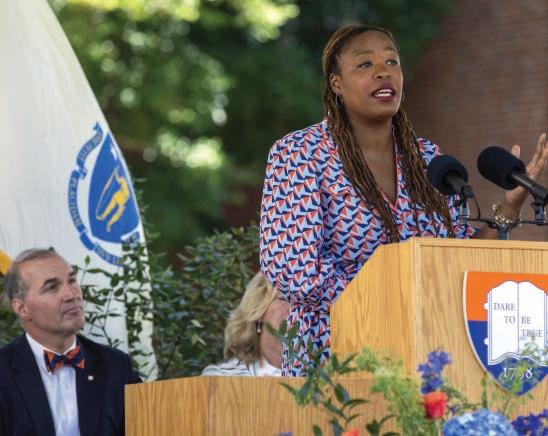
HEATHER MCGHEE ‘97
AUTHOR AND PUBLIC POLICY ADVOCATE
Where They’re Headed
Harvard, George Washington University, and Georgetown University top the 90 destinations for Milton’s ’22 grads.
53Fall/Winter 2022 University of Aberdeen 1 American University 1 Amherst College 1 Babson College 2 Barnard College 2 Bates College 1 Boston College 4 Boston University ................ 3 Bowdoin College.................. 4 Brown University ................. 4 Univ. of California, Irvine ..... 1 Univ. of California, San Diego ........................... 2 Univ. of California, Santa Cruz 1 Carnegie Mellon University 1 Case Western Reserve University 1 Central Connecticut State University ........................... 1 Chapman University............ 1 Chicago, University of 5 Colby College 3 University of Colorado, Boulder ............................... 1 Colorado College ................. 2 Columbia University 2 Columbia Univ/Sciences Po Dual BA prg .................... 1 Connecticut College ........... 5 Dartmouth College ............. 2 Duke University 2 Elon University 1 Emory University 1 University of Florida 1 George Washington University ........................... 7 Georgetown University 6 Georgia Institute of Technology ......................... 1 Hamilton College ................ 3 Harvard College ................. 9 College of the Holy Cross 1 Indiana University, Bloomington ...................... 2 Johns Hopkins University .... 2 Kenyon College ................... 2 King’s College London 1 Lafayette College 1 Lehigh University 1 Loyola University New Orleans ....................... 1 University of Massachusetts, Amherst...... 3 McGill University ................. 1 University of Michigan 3 Middlebury College 3 Morehouse College ............. 1 University of New Hampshire ................... 2 New York University ............ 1 University of North Carolina, Chapel Hill 1 Northeastern University 4 Northwestern University ..... 3 University of Notre Dame .... 1 Occidental College .............. 1 University of Pennsylvania 2 Princeton University ............ 2 Purdue University ................ 1 Rensselaer Polytechnic Institute.............................. 2 Rhode Island School of Design ............................ 1 Rice University 1 University of Richmond ....... 1 Rochester Institute of Technology ..................... 2 University of Rochester ....... 3 University of San Francisco 1 Santa Clara University 1 Scripps College.................... 1 Simmons University ............. 1 Smith College...................... 1 University of Southern California 1 Stanford University ............ 4 St. Lawrence University ...... 1 The New School (Parsons) .... 1 The Ohio State University 1 Trinity College 1 Tufts University .................. 4 Tulane University................. 3 Union College...................... 1 University of St Andrews 2 Vanderbilt University ........... 1 Vassar College ..................... 3 University of Vermont .......... 1 Villanova University 2 University of Virginia 5 Washington University in St. Louis .......................... 3 Wellesley College ................. 1 Wesleyan University ............ 4 William & Mary 2 Williams College 1 Worcester Polytechnic Institute.............................. 1 Yale University .................... 2 •
•
•
•
•
•
•
•
•
•
•
•
•
•
•
•
•
•
Uzobuife •
•
•
•
•
•
•
•
•
•
•
•
•
•
•
•
“
Milton Welcomes Its Newest Trustees
Milton’s Board of Trustees provides essential support to the school in promoting its mission, vision, and goals. Milton is grateful to this year’s retiring board members: ROB AZEKE ’87, LISA DONOHUE ‘83, RANDALL DUNN ‘83, DUNE THORNE ‘94, and KEVIN YIP ‘83 P’16 ‘23. We thank them for their service. In September, the Board welcomed the following new members:
■ Author and Milton graduate
EMILY FRANKLIN ‘90, P’17, ‘22, ‘25 spent time this spring working with creative writing students. Franklin, who has written more than 20 books, is a Bingham Visiting Writer. Franklin’s debut poetry collection, Tell Me How You Got Here, was published in 2021.
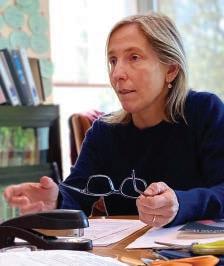
OSAREMEN OKOLO ‘13 is currently a Ph.D. student in the Depart ment of the History of Science at Harvard University. A 2017 graduate of Harvard University, she recently served as policy advisor for public health and equity in the Office on COVID-19 Response at the White House. In 2016, Okolo was a White House intern in the Science Division in the Office of Science and Technology Policy. She also held positions as legislative aide for the U.S. Senate’s Committee on Health, Education, Labor and Pensions, a senior health policy advisor for the U.S. House of Representatives, and a member of the Domestic Policy Team on the Biden-Harris Transition Team. She currently serves on the board of directors of the Har vard Alumni Association.
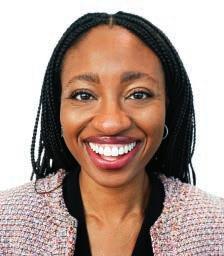
JUSTIN WALSH ‘99 is a portfolio manager for Viking Global Investors, a Greenwich-based hedge fund with offices in New York, Hong Kong, London, and San Francisco, which cur rently has $35 billion in assets under management. He is a 2003 graduate of Dartmouth College. Prior to joining Viking in 2011, where he has worked since graduating from Harvard Business School, Walsh worked as a club finance analyst for the National Football League, a private equity analyst for Blackstone, and an investment banking analyst for Goldman Sachs. In 2017, Walsh estab lished the ROBERT J. WALSH P ’99 Memorial Scholarship in honor of his late father, Robert John Walsh. Walsh lives in New York City and is married to Kirstie M. Le Bron.

HELEN ZHU P’25 has served, since 2019, as the managing director and chief investment officer of Nan Fung Trinity, which manages a multi-billion dollar portfolio of public securities, funds, and private equity. A 1998 graduate of MIT, Zhu previously worked as the head of China equity for BlackRock Asset Management North Asia Ltd., where she oversaw $1.5 billion in assets, chief China strategist for Goldman Sachs, and in various positions at ABN AMRO Group NV and Donald son, Lufkin & Jenrette Interna tional. Zhu lives in Hong Kong with her husband Frank Shi.
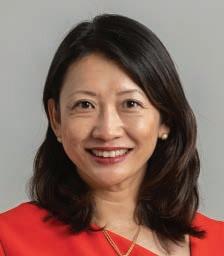
■ The speech and debate teams celebrated several accolades this spring. TALIA SHERMAN ’22 (left, with JACK BURTON ’22) won the Massachusetts Speech and Debate League championship in dramatic performance. Burton was recognized for his creation and leadership of the MSDL Student Board and was invit ed to give a speech, in which he acknowledged the league’s coaches for their work throughout the past two years of online competition.

54 Milton Magazine On Centre In the News
Osaremen Okolo
Justin Walsh
BOARD OF TRUSTEES
marisa donelan
Helen Zhu
MILTON PAYS TRIBUTE TO RETIREES
MILTON RECOGNIZES THOSE EMPLOYEES WHO RETIRED IN JUNE FOR THEIR MANY YEARS OF DEDICATED SERVICE
Elaine Apthorp
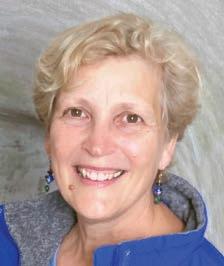
ENGLISH DEPARTMENT 1999-2022
“She has been a role model for me and I know that I am not alone. I have often referred to Elaine as the conscience of the English Department. Her instincts and practice are always in the best interests of the students.”

—NICOLE E.C. COLSON, CHAIR ENGLISH DEPARTMENT
Gerry Brosnahan
FACILITIES SERVICES 2001-2022

“No matter what room he walked into or whatever situation he found, Gerry was always ready with a quip or a joke to fit the situ ation, and his smile could light up a room. His can-do attitude was always on display, and when lo cated on the radio to address an issue, his response was always ‘I’ll take care of it.’”
—NICK PARNELL, DIRECTOR FACILITIES SERVICES
Sandy Butler
LOWER SCHOOL ART AND DESIGN TEACHER 2001-2022

“Sandy is a wizard at introducing students to ways of seeing real and imaginary worlds, appreciat ing different media and art forms, and celebrating artists who have brought techniques and perspec tives to the world. She approaches learning and teaching in multiple ways.”
TEACHER
Ed Donahue
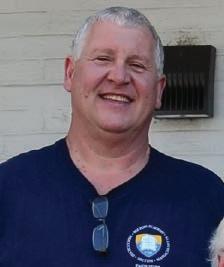
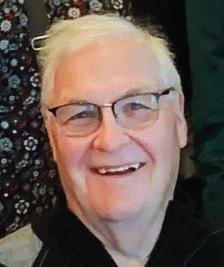
CONTROLLER 1999-2022
“Ed has marvelously headed our finances for the past 23 years. But the key to his success is that he does not see himself as just an ac countant or a forecaster. Those roles are reactive, and that’s not Ed at all—he is a person of action. He’s always encouraging dialogue, asking his colleagues and team, ‘How can we make this happen despite what’s going on?’”

 —HEIDI VANDERBILT-BROWN CHIEF FINANCIAL & OPERATING OFFICER
—HEIDI VANDERBILT-BROWN CHIEF FINANCIAL & OPERATING OFFICER
Terri HerrNeckar
MATHEMATICS DEPARTMENT 1996-2022
“Terri is the consummate lifelong learner and a gifted teacher who knows that how each student learns best is a moving target. Thus, she is always on a quest for new ways like slide-decks, hyper docs, pacing guides, and DESMOS investigations to provide her stu dents easy access to the work at hand along with clear expecta tions and built-in flexibility for its completion.”
—GREGG REILLY MATHEMATICS DEPARTMENT
Isabelle Lantieri

MODERN LANGUAGE DEPARTMENT 2001-2022
“Isabelle’s enthusiasm working with middle and upper school stu dents never wavered. An invaluable member of the Modern Language Department, a gifted teacher of French, and a long time leader of the French Exchange, Isabelle brought the same energy and love for her students every day. She will be greatly missed by her colleagues and students alike. Bonne retraite Isabelle! Et bons voyages!
modern languages department, a gifted teacher of
SÉVERINE CARPENTER MODERN LANGUAGE DEPARTMENT
Manny Tavares
FACILITIES SERVICES 1985-2022
“Manny took great pride in his job and there was never any question about whether a task scheduled would be completed. His exacting nature showed in everything that he did, especially in the perfectly lined-up corners between paths and fields. He literally (and stub bornly) refused to cut corners.”
—NICK PARNELL, DIRECTOR FACILITIES SERVICES
55Fall/Winter 2022 TRIBUTE
—JENN KATSOULIS
GRADE 5
TO READ THE FULL ENCOMIUMS, GO TO WWW.MILTONMAGAZINE.ORG/ SITE/RETIREMENTS. DEPARTMENT
Milton Academy’s foundational strength lies in its people. Each year, alumni, parents, and friends of Milton come together in support of the Milton Fund to provide critical current-use resources that sustain the excellence of a Milton education and provide flexibility to embrace new opportunities. The power of our community’s collective giving leaves an indelible mark on the lives of students, faculty, and staff.
Visit www.milton.edu/donate to make your annual Milton Fund gift today.













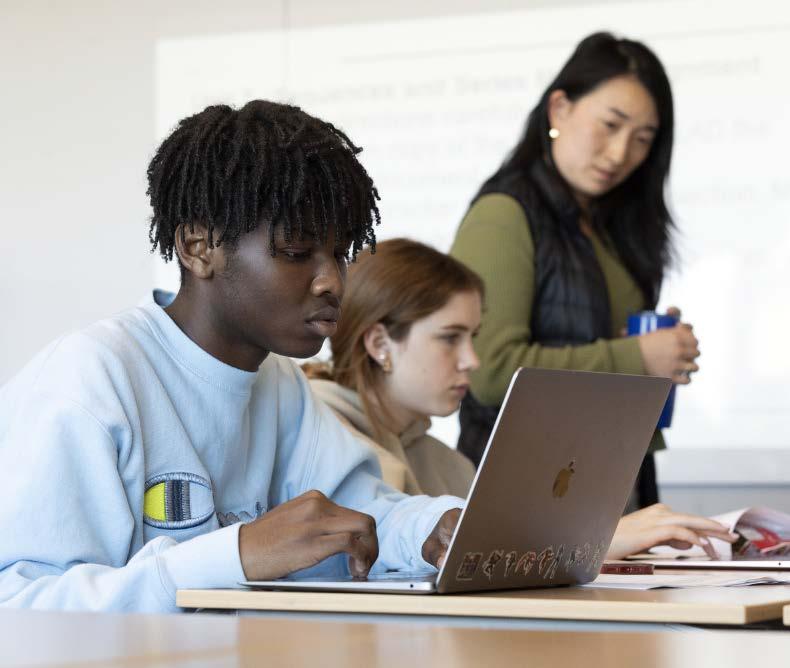
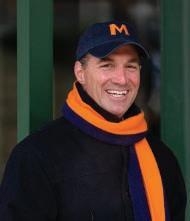



“We could not possibly be the school that we want to be without all of you.”
—Todd B. Bland Head of School
Make your annual gift today at www.milton.edu/donate PRIORITIES DIVERSITY, EQUITY, INCLUSION, AND JUSTICE FACILITIES FACULTY SUPPORT FINANCIAL AID SCHOOL’S GREATEST NEEDS STUDENT EXPERIENCE
Alumni Life

photograph by 57
News & Notes from Our Alumni Community
1948
BASIL “JACK” GAVIN did graduate work at UCB after college (Ho bart) and three years plus in the U.S. Navy. He shares that unlike his friend GEORGE LEE ’47, he saw no action in the South Korean the ater, but spent much time in the Orient. His life’s employment was singular and at Lawrence Berkeley National Laboratory as a staff scientist in the Accelerator Divi sion. His studies were in physics and art history.
1949
BAYARD HENRY shares that he was very saddened by the recent death of classmate MADELINE (LEE) GREGORY. He and “Mad” lived near each other in the retirement com munity Fox Hill, in nearby West wood. They saw each other fre quently, but as he said, “not often enough.” He recalls that “Mad invariably pointed out the supe rior academic quality of MAGUS vs. those of us ‘across the street’; and, darn it, she was right.”

1950
▲ NANCY (BURLEY) CHASE surprised SUZANNE FITZGERALD on her 90th birthday! They have been spe cial friends since age 14 through all seasons, enjoying sailing, cross-country skiing, making blackberry ice cream, sharing family celebrations, adventurous trips, and more all through the years.

1951
NANCY “NANINE” (POWELL) RHINELANDER continues to practice her acupuncture but no longer at her office. Due to the COVID-19 pan demic, she has been seeing cli ents at her house. With 30 peo nies in salmon, yellow, pink, rose, and five different whites, her yard was ablaze this spring. Still teaching line dancing to seniors, she is learning some very compli cated square dance steps.
1952
▼ KITTY (BIGELOW) BENTON was sorry not to be able to attend the 70th Reunion. For those won dering if Kitty is still playing the violin, the answer is a resound ing “YES!” She also remembers fondly her late classmate SARAH (CROCKER) GARRISON, with whom she played chamber music from the time they were classmates in Class III until her death. Kitty shares, “Two days before she passed away, our quartet, The G-String Grannies, had a wonder ful session. Sarah was at her best, playing beautifully and grinning
over the music stand.” Kitty also cherishes the times that she, Sarah, and CLEMENTINA “BON NIE” (BROWN) GARDNER played trios together, “once having the arrogance to perform Beetho ven’s trio, The Archduke, for the school, without having asked for any coaching or assistance.” Finally, Kitty pays tribute to Howard Abell, her beloved music teacher who instilled a joy of singing in the Glee Club, playing in the orchestra, and listening to classical music in all their ”rowdy teenage hearts.” Kitty recently received the Helen Rice Award from the Associated Chamber Music Players.
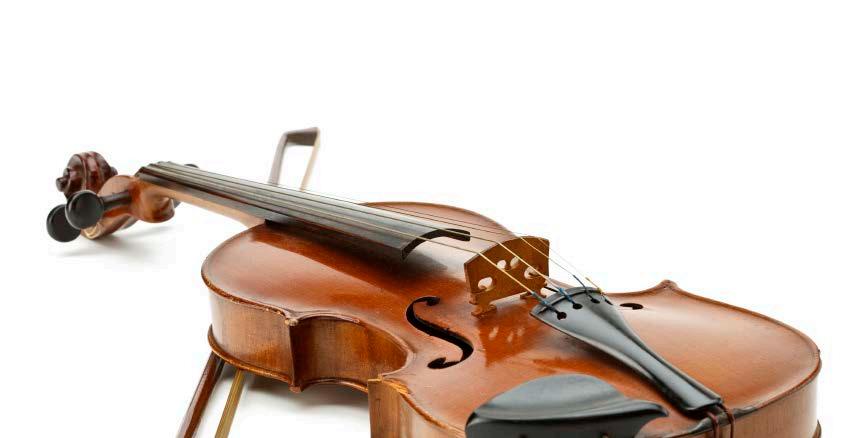
EMERY “EM” (BRADLEY) GOFF and her husband, Bill, announce with sheer delight the arrival of their first great-grand child! (See NKOTQ, p. 78.) She is the daughter of their grandson Ben Goff (elder son of Em and Bill’s son Mark and Anne) and his partner, Mercedes Gurney, and the adorable baby is named Mad eleine. She was born on Saturday, May 14, and like another Satur day’s child, her great grandma, she “must work for her living,” according to the old rhyme.
1954
JEAN (WORTHINGTON) CHILDS is still busy with committees at North Hill and volunteered at the USGA Open golf tournament. She and John painted their old boat bottom after a young er friend sanded it. With some help, the boat was launched over the summer. Jean shares, “Life was simpler when we were at Milton! Our children are work ing in the immigration and men tal health areas, but can’t cover the whole world!”
CYNTHIA HALLOWELL moved to Burlington, Vermont, after living most of her life in Boston. Unfortunately, Cynthia had two falls and broke a hip each time. The first healed well, but that was not the case with the second one. After the second fall, she was only able to move around in a wheelchair, so living on her own was not practical. She shares, “The Converse Home in Burlington takes wonderful care of me, and it is very near where my brother lives. Come for a visit if you are in the area.”
LILLA LYON moved to a co-housing community in Peterborough, New Hampshire. She shares, “It’s beautifully designed and maintained with environmental sensitivity, and
58 BIRTH BOOK RELOCATION WEDDING Class Notes 1948–1962
Nancy (Burley)
Chase ’50 and
Suzanne
Fitzgerald ’50 ICON KEY Milton Magazine
includes a farm and walking trails on over 100 acres. We enjoy being with neighbors of all ages from newborns—two since June 2020—to a few folks slightly older than us. All congenial and work hard to be good neighbors. It was a good place to be during the pandemic lockdown.” She stays occupied by reconnecting through Zoom with New York City poet friends for weekly workshops and attending monthly get-togethers (mostly Zoom) with a French Book Club in Cambridge. She spent nearly three months preparing a 30-minute talk in French on Baudelaire for the book club.
1955
COBURN rendezvoused last spring in Fort Myers, Florida, to enjoy a Red Sox spring training game vs. the Tampa Bay Rays at Jet Blue Park (Fenway South). “Ace,” John, and Phil did some remi niscing about their baseball days at Milton under coaches Frank Millet and “Lefty” Marr, and as an extra bonus to a fun reunion, the Sox won the game 5–3! Phil’s great nephew SAMUEL “SAM” BORGGAARD ’22 graduated this past spring.
DEBORAH “DEB” (WEBSTER) ROGERS is still thriving at Wesley Acres retirement community, which is under a huge renovation. She reports that the best things are “the staff, the loop of paved trail in the back woods, the neigh bors, and the activities.”
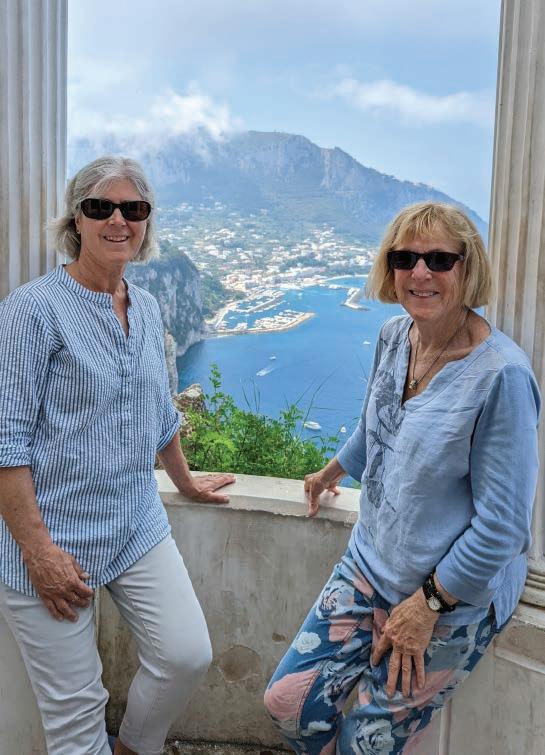
1962
SUSAN SHERK has lived most of her life in the province of Newfoundland and Labrador, Canada, experiencing an interesting and diverse 56 years since graduating from Wheaton College in 1966. After attending graduate school in cultural anthropology at Memorial University of Newfoundland, she worked there in economic development and helped create a magazine for and about the province’s people, culture, and history. She went on to work for Mobil Oil Canada as manager of socioeconomics and public affairs for eastern Canada, with a short stint in New York City as the community affairs manager for Mobil Corporation. She then returned to Canada to work as Michelin Tires Canada’s manager of corpo rate affairs, commuting from Newfoundland to Nova Scotia for two years, and later returning home to take a position as assistant deputy minister of economic development and tourism for the province of Newfoundland and Labrador. Eight years later, she returned to the private sector, spending 20 years working for a large international engineering company as a senior associate of socioeconomics, which took her to many parts of the world. Susan sat on three large corpo rate boards and chaired several nonprofits. After retiring, in 2018, she continued to work full-time for two Newfoundland nonprofits. Susan has been amicably divorced for a little over 20 years and is a proud great-grandmother. She’s also had a hobby farm for more than 30 years, which she recently downsized to 12 chickens, two goats, and a cat. Her house sits on a large pond outside St. John’s, and when not working, she can be found in her large veggie and perennial gardens.
VICTORIA “TORY” BARR recently published a book of color plates of her paintings done over the last 50 years, entitled Victoria Barr Paintings
1958
NEILSON ABEEL finally celebrat ed—two years late—the 80th birthday of his Upton House roommate, JOHN P. DE NEUFVILLE ’57, at a dinner party in New York City. He also shared that he is “aging in place with my wife, Tori Bryer, in our antique building topfloor loft in Portland, Oregon.”
1959
PHILIP “PHIL” KINNICUTT shared that he, DAVID AMES, and JOHN
1962
WILLIAM “BILL” REIMERS missed Reunion owing to a scheduling conflict. Retired for about five years, Bill worked at a docu ment management company for 30 years handling the medical needs of 150 hospitals in the Car olinas, Kentucky, and Virginia. Bill has been married to Sandra for 54 years. They have three children within 100 miles and enjoy spoiling their five grand children “as payback.” He sends his best to the Class of 1962.
DIANA “DINA” ROBERTS is in her fourth year as director of insti tutional advancement at Gore Place Society in Waltham. This past year, she cochaired the
59Fall 2022
Susan Sherk ’62 (right) hiking with her sister on the Amalfi coast, March 2022
stewardship campaign of Saint Michael’s Church, where she serves on the vestry. She is re viving her love of languages in a French cinema class for two hours every week. Dina is limp ing her way toward publishing her third book, a novel titled Both Sides Now. Her daughter, DIANA MCCARLEY ’99, has been a big help with editing. Bob and Dina still live in Milton and are blessed with a blend of five kids and four grandchildren.
1964
NICHOLAS “NICK” HINCH received the Federal Aviation Adminis tration Wright Brothers “Mas ter Pilot” Award from the FAA Denver Flight Standards District Office in June at the United Air lines Flight Training Center. The award is the most prestigious the FAA issues to professional pilots to recognize individuals who have exhibited safety, skill, and aviation expertise in aircraft operations for at least 50 years.
Nick first soloed in 1970 and flew both military and commercial aircraft. Although retired from commercial flying, he is still teaching at the United Flight Training Center as a flight tech nical instructor on the Airbus 319/320.
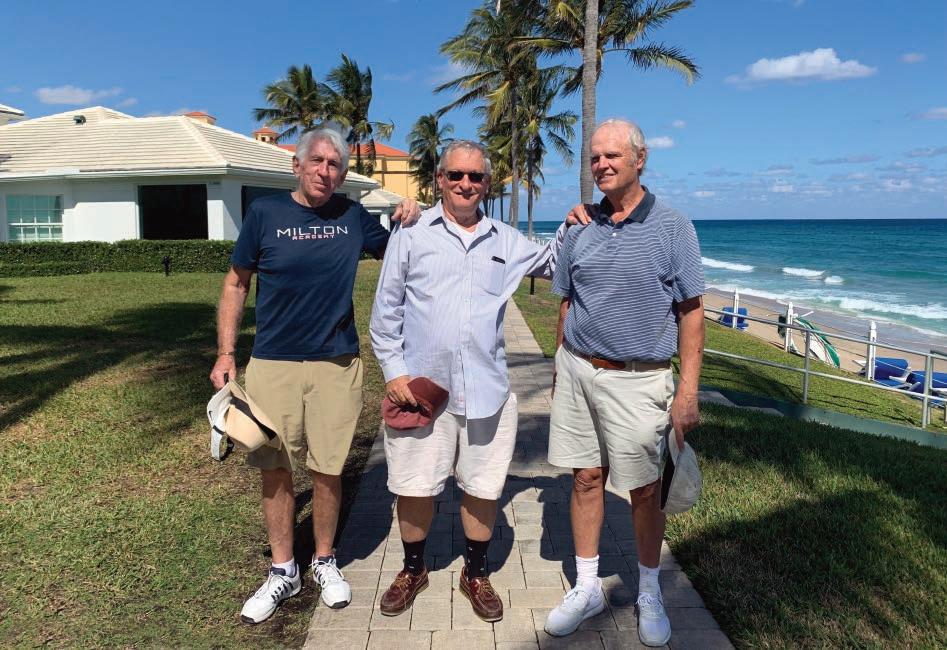
1967
ROBERT “THOR” APTHORP was on a previously planned trip at the time of Reunion. He and Rose mary live in a retirement home next to the ocean—a very safe distance—where they have been for six years. Robert is still shout ing out with joy about living there because it feels a lot like living on a boat tied up to the dock, but without the worries. He shares that looking out to the south from the space of Piper Shores in Scarborough, Maine, feels very inspirational. Robert sees and talks often with several other Milton graduates, and in his own mind, he still plans on skiing and sailing.
1968
ANN MCCLELLAN received the Order of the Rising Sun, Gold and Silver Rays, from Japanese Ambassador Koji Tomita on May 10, 2022, at his official residence in Washington, D.C. The distin guished award, an imperial dec oration originally issued in the spring of 2021, was accompanied by a certificate signed by Japan’s prime minister. It honors Ann’s written work, presentations, and appearances that have contrib uted to introducing Japanese culture and promoting friendly relations between Japan and the United States.
1969
SARAH “DIXIE” DIXWELL
BROWN writes, “My book about my unusual middle name was recently published. Who knew I’d been named for a regicide of Charles the First, John Dixwell, who fled to this country

in 1665 and lived under an assumed name until his death! I didn’t, until I happened on his story in London when I was 28.” Many of his descendants attended Milton Academy. To learn more about Dixie’s story and her book, Regicide in the Family: Finding John Dixwell, visit her website: sarahdixwell brown.com

60 Milton Magazine
1966 THOMAS “TOM” TURNER, DANIEL “DAN” GERRITY, and FREDERICK “FRED” FISKE enjoyed a rousing game of pickleball followed by lunch and a libation or two.
Class Notes 1964–1980
Presse, Sylvie is still very active in BizAv journalism as coeditor of Ultimate Jet Magazine, a life style magazine (print & digital) dedicated to business aviation. She was not able to attend Re union in June but was looking forward to visits from Milton Academy classmates, starting with BRYAN BRUMLEY and KATH ERINE “ANGIE” (YERXA) CALVERT
To all classmates: Should you be visiting France, please give Sylvie a heads up!
these many years.
BARTLETT “BART” HAYES retired from the Air Force in 2018 but continues to teach ophthalmolo gy on the faculty at Wake Forest University in North Carolina.
1976
EDWARD PELLEGRINI shared that his kids and wife are extreme ly well; “We have been blessed.”
He is confident that their for ward-looking careers will ensure they are taken care of, along with organic food, clean water, and minimizing their carbon footprint. He barely drives any more himself and would like to bike to the farmer’s market. They recently joined a new church filled with wholesome, patriot ic people who are followers of Jesus and the Bible. He shares that when they go there, he feels like he is “in a time warp of the 1950s.”
1975
1971
▲

SYLVIE PÉRON, a French Riviera resident, was happy to travel to nearby Switzerland to attend the European Business Avia tion Convention & Exhibition, where she met and mingled with friends from the industry after a long three-year hiatus due to the pandemic. The founder of Milton

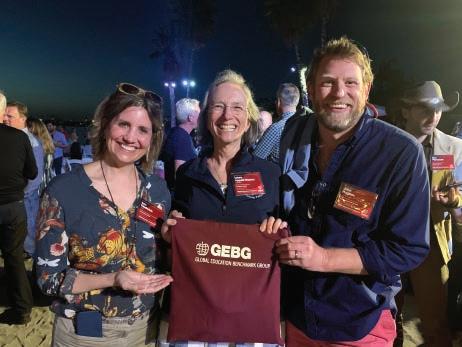
ELAINE APTHORP retired in June after 42 years of teaching, the last 23 of which were at Milton. Her wife, Terri HerrNeckar, who had taught in Milton’s Math De partment three years longer than Elaine taught in the English and History Departments, is “hangin’ ‘em up too, so they can trun dle off into the sunset together (hopefully to enjoy LOTS of sun sets, tutoring, volunteering, read ing, writing, and, for Terri, pho tography, along with lots of long walks on woodsy trails).” As they were moving stuff (from their dorm-staff faculty apartment in the basement of Goodwin House to their home in Northampton, Massachusetts), Elaine smashed up her ankle carrying a box of books downstairs, so that has definitely added an extra twist to the farewell process that Elaine and Terri hadn’t hoped for, but they’re grateful—for the adven ture of this work and for all the dear people with whom and for whom they’ve worked at Milton
PATRICIA “PATTY” SPENCE has been working with a fabu lous team at the Urban Farm ing Institute (UFI; www.urban farminginstitute.org) growing more than 17,000 pounds of food and donating 3,200 pounds to families in need. Her team is training a new crop of urban farmers every year, building raised beds in backyards or driveways and introducing chefs of color to the community, all in an effort to assist in building healthier lifestyles and provid ing the freshest possible food for Boston communities dealing with some of the highest rates of hypertension, diabetes, cancer, and food insecurity. Farm Stand Fridays started in mid-July. Patty shares a fun fact: Milton Acade my students have been volun teering at UFI for well over six years!
(Polytechnic School), and JOHN HUGHES ’91 (Lawrenceville) repre sent three Milton decades on the board of directors of the GEBG (Global Educators Benchmark Group), and each is responsible for the global program at their school. They had an in-person re union in San Diego at the annual GEBG conference, where a photo was taken by Rachel Kelley, a former Milton staff member and currently the director of enroll ment management and market ing at SYA.
ELANA KANTER and her husband started a synagogue in order to build the kind of community they would want to join. This fall, they’ll celebrate 20 years since they began. “Special thanks to KARIN MAHONY, OLIVIA (FARRAR) WELLMAN, and HOLLY (GETCH) CLARKE for their support and friendship during my years at Milton.”
1978 ▲ LAURA APPELL-WARREN (St. Mark’s School), ANN DIEDERICH ’89
1980 DEBRA SPARK’s latest book (coedited with Deborah Joy Corey), Breaking Bread: Essays from New England on Food, Hun ger, and Family, was published in May. Profits support the hunger nonprofit Blue Angel in Maine. The book features major literary writers and newcomers and is a fun read for a good cause.
61Fall 2022
Ann Diederich ’89, Laura Appell-Warren ’78, and John Hughes ’91 in San Diego
Sylvie Péron
’71
1982
▲ LAURA (GILMAN) RUHE enjoyed connecting with the Class of ’82 at the 40th Reunion. She recent ly had another milestone, cele brating her 30th year at FactSet Research Systems Inc, which over the course of time grew from a handful of people to 10,000 em ployees around the world with an amazing product, service, and culture. She started and man aged many departments during this time and is grateful for the experience. She uses many of the skills she learned at Milton every day. She is still in Connecti cut with two of her four daugh ters, while one is in Massachu setts and her oldest works in San Francisco. She was excited to see many classmates in person at Reunion and to catch up with others virtually.
1985
ELIZABETH “LIZ” DAVIS has been appointed to the National Ad visory Committee on Individu als with Disabilities and Disas ters, led by the Secretary of the U.S. Department of Health
1986
and Human Services. She is the founder and executive director of EAD & Associates, LLC, based in New York, which is a boutique consultancy focused on inclu sive emergency management bringing voice and real-world solutions to disaster response for traditionally marginalized/un derserved populations.

JAMES “JAMIE” FORBES contin ues his work with independent schools through Learning Cour age, the nonprofit he started

in response to sexual abuse he experienced as a student at Mil ton. He is proud to have KATH LEEN “KATE” (SULLIVAN) HENRY ’87 working on his team and to have many other alums who have been supportive of his work.

1987
SARAH (WHITE) BOURNAKEL re cently had a chance to catch up with CAROLINE “CASSIE” ROBBINS on the slopes in Utah. They spent
more time laughing than ski ing. BLAIR (DONOVAN) ALEXANDER and Sarah had fun catching up in Park City and look forward to skiing together on the Wasatch Front next season, reliving their 1980s ski trips!
PETER KELLNER shares that he and Meredith moved from New York City to Chestnut Hill, Massachusetts, last September. Their daughter, Morgan (see NKOTQ, p 78), is finishing her first year at Apple Orchard (AO) School, where Peter enjoys frequently seeing MARTINA ALBRIGHT ’86, AO’s amazing head of school. They were away in June and were sad to miss Reunion. He hopes classmates in the Boston area will reach out because he would love to reconnect.
1988
► BRENDA “BREN” MCELROY is delighted to be back in her native Massachusetts after more than a decade in Dublin, Ireland, where she was known best as Cassandra in the national TV series Fair City. Bren runs her own coaching school at commu
62 Milton Magazine Class Notes 1982–1994
JOSEPH “JOE” VINCIGUERRA was named chair of the Dramatic Writing Department at NYU Tisch School of the Arts in September 2021.
Joshua Goodman ’88 and Liza Engelbrecht ’90 enjoy a hike.
nicationmattersstudio.com and is delighted to be acting in Gloucester Stage Company’s The Thin Place this autumn. She also leads in a short film as a tough business woman with a heart, co-starring Milton student ELLA GOLDBERG ’24 and Mattia Farmer, JENNA MOSKOWITZ’s daughter! The Sibling Rule by Mari San Giovanni: Two women fake a gay marriage to keep their kids in the same school, but complications arise when the marriage becomes a bit too real. Out this fall.
1990 JOSHUA “JOSH” CARPMAN cel ebrated his twins Joseph and Brian graduating from Texas A&M University in May.
◄ LIZA (ACEVEDO) ENGELBRECHT took on a new hobby: hiking. Good friend and avid hiker, JOSH UA GOODMAN ’88, agreed to teach Liza the ropes. Great exercise, a fun trip to Palm Springs, Califor nia, and a mini Milton reunion all rolled up in one.
political analyst and anchor at CNN, doing his daily Reality Check segments. He is looking forward to bringing his two kids, Jack and Toula Lou, for their first joint visit to Milton’s campus with Margaret. They live across the street from HENRIK BRUN and around the corner from David Dunbar in New York City, near Gramercy Park. He hopes that everyone is doing very well.
LEONORA (ZILKHA) WILLIAMSON
has been living in Nashville, Ten nessee, for the past five years. She’s a professor at Vanderbilt University, where she teaches negotiation and corporate social responsibility, and she has an ex ecutive coaching and leadership development firm, Platinum Rule Advisors, that she founded three years ago. Leonora coaches C-suite leaders, primarily of fam ily-owned businesses. If you’re ever passing through Music City, she hopes you will be in touch! She’s also excited that she’ll be spending more time in Boston, because her oldest daughter, Louise, will be joining the Class of 2026 as a boarder!
come her way. Claire could not be prouder. Claire has been a school adjustment counselor on Cape Cod for the past 17 years.
1993 PRIYA (THOMAS) STEPHEN is excited to be moving back to Massachusetts with her husband, Ben, and son, Jacob, after 22 years! She will be joining Pediatric Associates of Greater Salem and is looking forward to reconnecting with Milton friends.
1994
NOAH FREEMAN is thrilled that both his children, Ella (rising 6th grader) and Julian (rising 4th grader), will be attending Milton in the fall. Noah has been enjoy ing guest-teaching advanced AI to seniors in Milton’s Computer
Science Department.
ALISON “ALI” GASS is excited to tell any Bay Area Milton alums to stay tuned for the opening of a new contemporary art museum! She is the founding director of the Institute of Contemporary Art San Francisco, set to open in the Dogpatch neighborhood this fall. She hopes you will visit when it opens!

FREDERICK “FRED” MELO, the St. Paul bureau chief for the St. Paul Pioneer Press in St. Paul, Minne sota, was accepted into the fall 2022 teaching fellows program at the University of Minnesota and continues to enjoy teaching journalism to undergrads as an adjunct professor. He has also joined the board of ThreeSix ty Journalism, which instructs high school students in journal ism through the University of St. Thomas.
Brenda McElroy ’88 and Ella Goldberg ’24
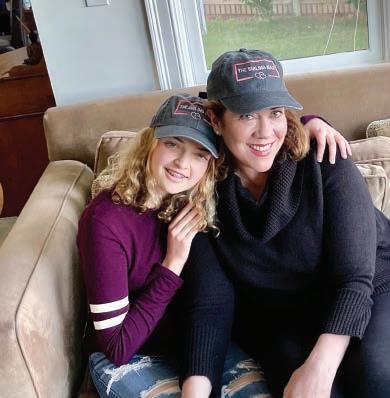
1991 JOHN AVLON published a new book in February, Lincoln and the Fight for Peace (see page 76). It’s about Lincoln’s plan to win the peace after winning the war and his vision for national reconciliation and reunification. John wrote it while working as editor-in-chief of The Daily Beast and now as a senior
1992
CLAIRE (MCNAMEE) POOLE is ex cited to announce that she has successfully raised an amazing daughter, as a single mother, for the past 20 years. Her daughter, Ava Poole, is a junior in college and is studying to be a genetic counselor. Ava is kind, empa thetic, smart, and driven, de spite many challenges that have
THE RISE AND FALL OF A DRUG START-UP

In The Hard Sell, Evan Hughes ’94 presents an in-depth ac count of the rise and fall of a pharmaceutical company whose potent opioid made a fortune for company executives while devastating the lives of many of those prescribed the drug. Based on hundreds of interviews with inside players including compa ny employees, patients, doctors, and attorneys, the book focuses on the people behind Insys Ther apeutics and its signature drug, Subsys, a spray made of fen tanyl, a synthetic opioid about 50 times as powerful as heroin, which was ostensibly designed for seriously ill people facing se vere pain. Although the company founder, John Kapoor, contend ed that the product was in spired by the travails of his wife, who suffered a painful death
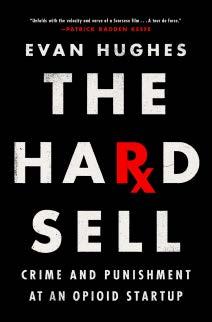

from cancer, the author expos es Kapoor as a hard-charging businessperson who relentless ly pushed for more sales of the drug. That effort centered on cultivating “whales”—a small number of doctors who pre scribed high volumes of opioids whom the company identified through pharmacy data. Provid ing “an unprecedented view into the marketing of painkillers in the midst of a deadly [opioid] ep idemic,” Hughes details how the company induced these “gurus of fentanyl,” as one company exec utive put it, to prescribe Subsys, including paying them for bogus speaker programs and even hir ing a woman as a drug rep be cause a doctor she would visit on behalf of the company was ro mantically interested in her.
The strategy worked, leading to an initial public offering on Nasdaq and an eventual market capitalization of $3 billion. The financial success was facilitat ed by many prescriptions that were written for unapproved use (called “off label”), not for seri ously ill patients but for those who complained of pain. Some of the patients became addict ed, including one who reported, “Life with me was unbearable.” The company’s downfall began when investigators scrutinized Insys in response to whistleblow er complaints and the arrest of a doctor who was by far the num ber one Subsys prescriber in the country for Medicare patients, charged with prescribing the drug “for no legitimate medical purpose.” The book culminates in the 2019 federal trial of Ka
poor and other Insys executives and managers, which included testimony from former CEO Mike Babich acknowledging that the company achieved success by bribing doctors. After the ver dicts were read, the defendants became the first pharmaceuti cal executives sent to prison in connection with the opioid epi demic.
□ ALUMNI BOOKS
64 Milton Magazine M i K e lawrie
Reunion Weekend 2022
Over the weekend of June 17–18, 505 alumni from classes ending in 2 and 7 joined us for our first on-campus Reunion in three years! To make up for lost time, Reunion also included 50th Reunion celebrations for the Classes of 1970 and 1971.

photograph by
Reunion 65Fall 2022 Photogra P hy: Kjeld Mahoney of Kjeld Mahoney Photogra P hy and Caitlin Cunningha M Photogra P hy ll C
“I try to go to every event Milton hosts in New York, and even came to homecoming last fall. I have also been on my Reunion Committee for each Reunion since graduating and love it. The best thing is getting to see friends you haven’t seen in years, and so it’s really important to me that we come back and reconnect.”
REUNION WEEKEND JUNE 17-18

Alumni celebrating their reunions (some belatedly) came to campus in June to catch up with old friends and participate in a variety of activities—from choral and art events to student panels and school updates.
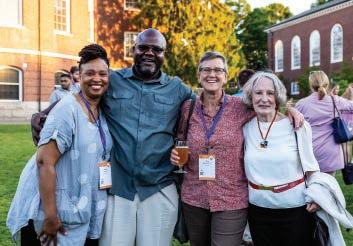
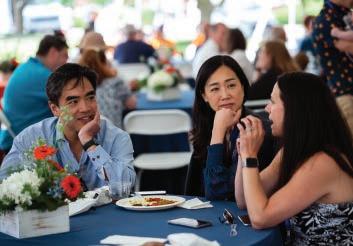



Angie and IVAN TING ’92 P ’22 ’25 catch up with classmates at the Barbecue. Below: Members of the Class of 1987 including
and MEG
“I grew up in Milton, and therefore attended school here from nursery school through Class I. It’s wonderful to be back to see Milton today, and a treat to revisit our old haunts.”
Members of the Class of 1972 reminisce over photos from the Girls’ School
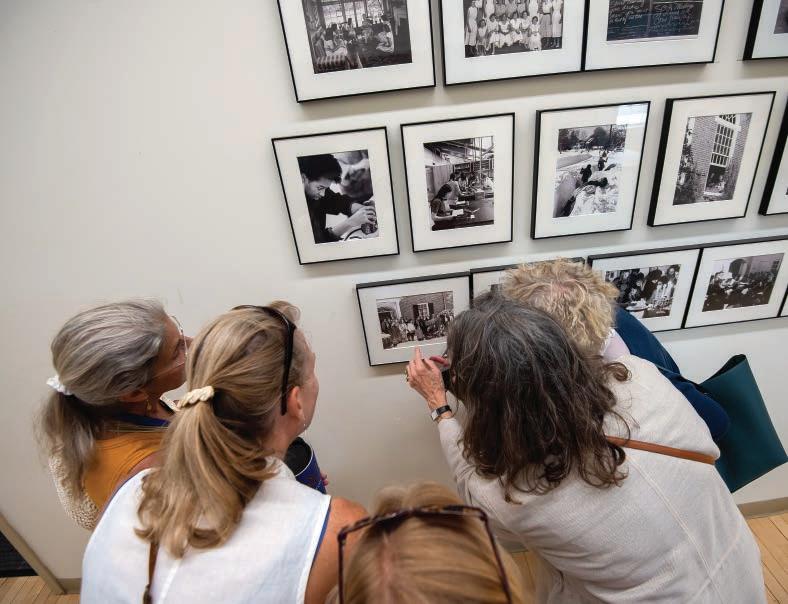
—FAZAL YAMEEN ’02
—LISA GRAVES WARDLAW ’57
ALEX LITTLEFIELD ’02 builds a giant LEGO tower with family at the Family Festival
ALETHIA JONES
ROBERTSON
66 Reunion

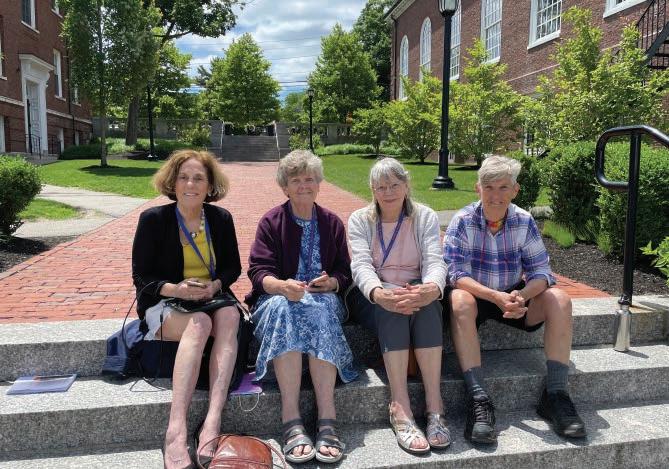

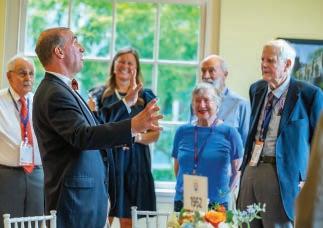

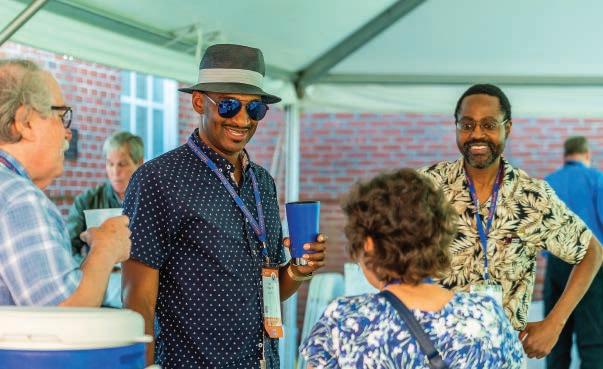
LAMONT LEE DUBOSE ’92 and SADIKI MWANYOHA ’92 chat with retired faculty members John and Erica Banderob DINA ROBERTS BRAY ’62 P ’89 ’95 ’96 ’99; EMMY NORRIS ’62; POLLY ABELL JIMENEZ ’62; and BET LADD CECILL ’62 relax by the Quad
Members
of the Class of 1997 at a football screening party with Coach Mac
MELISSA
COLEMAN ’87 catches up with class mates at the 1977, 1982, and 1987 Class Dinner. Below: JAMES BOWDITCH ’57, Kathy and BOB HUBBY ’57, and TIMOTHY GATES ’52 chat with Todd and Nancy Bland at the 1952 and 1957 Class Dinner 67Fall 2022
BY THE NUMBERS
Total
Highest Reunion
Largest Reunion
Most Reunion Class
Greatest distance
Represented
(U.S., China,
Most attendees
Earliest class year
● FRIDAY, 1 PM MILTON IN THE CLASSROOM: MATH AT MILTON
Milton Academy math faculty member Gregg Reilly (standing) gave NATHANIEL WEEKS ‘70, Silence Weeks, and BET LADD CECIL ‘62 a taste of what math looks like in today’s classroom. The department is working to make math more accessible, reaching students with differing interests and comfort levels, so that everyone has the skills they need to succeed. The team shared an algebra exercise with differentiated start ing points. When students have a choice of where to start, it gives them agency to assess their comfort level with the material, determine where they need help, and ask thoughtful questions.
Total Reunion Committee
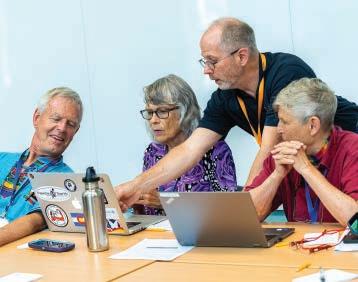
50th Reunion pins
Decades of Spotify music played
consumed at the Barbecue
LEGO towers built at the Family Festival
Math problems solved at Milton
the
carts giving rides around campus
Number of partnerships with Milton faculty, staff, and administrators
Number of students who helped make Reunion special

● FRIDAY, 2:30 PM GLEE CLUB SING
Founded in 1925, the Glee Club is the longest-running activity at the school, boasting more than 100 mem bers annually. Music faculty member Ted Whalen led a group of 25 alumni of all ages in a reprise of Glee Club favorites. The group sang a French Renaissance piece, “Mon Coeur Se Recommande a Vous,” in honor of the late Jean McCawley, founder of the alumni Glee Club Sing and 44-year member of the music faculty. They rounded out the program with a stirring rendition of “Somewhere” from West Side Story
“I am excited to be back on campus for my 20th Reunion. Milton holds a special place in my heart, and it’s great to just be back with our friends where a lot of our learning and growing happened. I look forward to participating in the events and catching up on old times.”
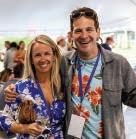
“I have been involved with my Reunion Committee and Regional Committee in Washington, D.C., and I love connecting with fellow alumni. I personally stay connected with Milton because I know how unique the gift of a Milton education is, and I want to help make that more accessible and better for future students.”

photograph by 68 Milton Magazine Reunion
—CAITLIN WALSH ’02
—WATSON LEFFEL ’12
Attendees 505
Class Gift participation ......................... 51% (’62)
Class Gift total ..............................$490,850 (’87)
Gift donors 66 (’82)
traveled 7,950 miles (Hong Kong) Countries
4
Egypt, Uganda)
53 (’12)
represented .......... 1952 Classes represented ................................ 16
volunteers ..... 71
gifted........................ 45
7 Cookies
550 Giant
150
in
Classroom 30 Golf
... 6
........ 75
10 Memories made Innumerable
● FRIDAY, 4:30 PM
ALUMNI STORYTELLERS PANEL

Director of College Counseling ROD SKINNER ’72 served as moderator to a panel of talented alumni, includ ing actress, filmmaker, and producer JESSICA CARLSON ’12; screenwriter and playwright TANYA EVERETT ’02; and filmmaker, photographer, producer, and director JEHANE NOUJAIM ’92. Each panelist shared how their careers in storytelling found their roots at Milton. Their work each includes a thread of activism, giving platforms and a voice for diverse perspectives.
“Many people don’t come to their 5-year Reunion because it is not long after graduating college, but I felt it was important to come back because of my deep connection to Milton. The people I met here are still my very good friends that I admire and want to keep in touch with. The friendships forged at Milton are so much deeper than college because we went through so many formative experiences
● SATURDAY, 11:45 AM
STUDENT LIFE PANEL
Associate Director of College Counseling Rachel KleinAsh led a panel of Upper School students, (pictured left to right), SAM ’22, AMELIA ’23, ADRIANA ’23, and HENRY ’23. The students shared their various clubs and activities, how they’ve grown during their time at Milton, and their experiences in the classroom. Each student expressed how their time at Milton expanded what they thought was possible for their interests and talents. By learning how to articulate what they need to learn and grow, they increased their self-confi dence during times of success and through mistakes.

● SATURDAY, 10:30 AM
STATE OF THE SCHOOL ADDRESS

CLAIRE HUGHES JOHNSON ’90, incoming president of the Board of Trustees, introduced Head of School Todd Bland for an update about the health and vitality of Milton Academy. Highlights included news about the next Head of School ALIXE CALLEN ’88, facilities updates, and strategic planning. Despite recent challenges, Milton has seen tremendous growth over the past 10 years, with increased applications, curricular renewal, and a stronger financial foun dation. This progress would not have been possi ble without the extraordinary work of faculty, staff, administrative leadership, the Board of Trustees, and generous alumni.
Father and son Charlie Walcott ’52 and Sam Walcott ’97 attended Reunion this year.
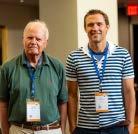
recently moved back to Massachusetts, and it is nice to come to Reunion with my dad and to host him at our new place.”
● SATURDAY, 1:30 PM
NESTO GALLERY RECEPTION
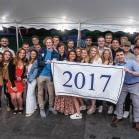
Reunion attendees were treated to the artworks of fellow Reunion alumni on display in the Nesto Gallery exhibit “Paying It Forward | Alumni Artists Who Returned to Teach,” featuring TE PALANDJIAN ’17,
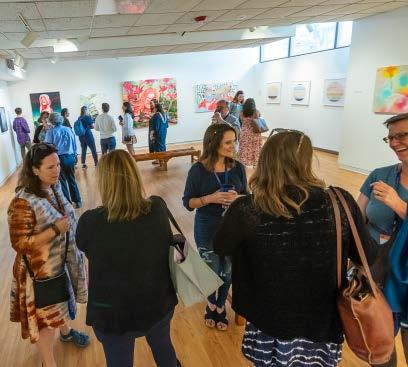
VON MENTZSCH-RAMOS ’03, EMILIE STARK-MENNEG
, NICOLE DARLING ’97, SARAH SZE ’87, and IAN TORNEY ’82. “Truth,” by MACRAE WYLDE ’82, was also on display outside the Art and Media Center.
photograph by 69Fall 2022
together.” —NICK O’TOOLE ’17
“I
—SAM WALCOTT ’97
JULIA
’02
MARCEL THE SHELL CHARMS AUDIENCES
Since Marcel the Shell with Shoes On—cocreated by comedian JENNY SLATE ’00 and filmmaker Dean Fleischer Camp—opened in theaters last summer, the largely improvisational animated film has been garnering rave reviews. The film follows Marcel, a tiny, one-eyed shell voiced by Slate, as he searches for his lost family, bravely navigating through feel ings of loneliness and grief. Seven years in the mak ing, the 90-minute film is based on the popular You Tube videos about Marcel that went viral more than a decade ago.

In an interview with Rolling Stone in July, Slate said she’s not entirely surprised that the one-inch mollusk remains relevant to viewers. “Marcel is like a person talking pretty honestly about his life and what he thinks,” she said. “It’s interesting generally to see someone try to figure themselves out and to be honest about who they are .... I think that’s al ways charming and also reminds us of how we are or how we’d like to be or how we used to be before we became jaded.”
It’s also a film, she said, that evokes feelings of nostalgia for what people have lost during the past several years because of COVID. After being split apart for so long, she said, “we lost the ability to be face-to-face and explain ourselves to other people. I think there’s a tenderness to that too.”
ALEXANDRA “LEXA” GLUCK has been making headway in Holly wood. After receiving her MFA from the American Repertory Theater at Harvard University, Lexa went on to work profes sionally in Los Angeles. Her credits include a recurring arc on Noah Hawley’s Legion; Deon Taylor’s female-driven thriller Fatale, with Hil ary Swank, and two roles in forthcoming Hulu pilots, one of which she worked on with the legendary director Matt Shakman of WandaVi sion. She also produces and stars in her own work under her produc tion company, Seventh House. Most recently, Lexa world premiered her latest project, Desert Sky—a sci-fi/fantasy episodic—at the iconic 25th Annual Dances With Films Festival at the Chinese Theaters in Hollywood.
ANNA (ROSEFSKY) SAAVEDRA and her family returned to the Boston area after 12 years away in Bogotá and Los Angeles. She is thrilled to be back and connect with other local alumni.
2001 TREVOR MCCOURT and SAMANTHA BENDETSON MCCOURT ’05 welcomed Blakely Bendetson McCourt to the family on July 11, 2021. Big sister Hayes (2) is smitten with her built-in best friend (see NKOTQ, p 78).
2002
ANNE DUGGAN and David Ranieri welcomed their second son, James, in February 2022. (See NKOTQ, p 78.) Anne has enjoyed stroller walks with fellow new mom JENNIFER “JENNY” (COHEN) GORDON
SETH MAGAZINER and his wife, Julia McDowell, welcomed their new son, Max, this past fall in Providence, Rhode
Island, where Seth is serving in his second term as state treasurer. Seth is currently running for Congress in the open Rhode Island Second Congressional District.
2003

DANIEL CALLAHAN recently wrote and directed Come on In (www. comeoninfilm.com), which is now available on Prime Video and Apple TV. Daniel’s work as a transmedia artist and design er merges various disciplines. He and his work have been featured at the Museum of Fine Arts, the Isabella Stewart Gardner Mu seum, the Institute of Contem porary Art, and the Queens Mu seum, and also in publications such as The Boston Globe and The Bay State Banner. He is a recipient of the Donor Circle for the Arts and the NEFA Creative City grants.
2004
NATALIE (CURTIS) THORNE joined the New England board of Pos
70 Milton Magazine Class Notes 2000–2007
□ GONE HOLLYWOOD 2008
itive Coaching Alliance (PCA), a national nonprofit working to inspire youth to be their best selves through sports done right. PCA says that “as a lifelong athlete and advocate for sports, Natalie will bring her experience and energy to PCA.” Read their full press release by searching for Natalie Curtis Thorne on the PCA website, pos itivecoach.org.
COLLEEN RITZAU LETH relocated to London, where she is working as director of marketing for Wright & Wright, an architecture firm specializing in museums and special-collec tion buildings. She continues to consult for museums interna tionally and has recently been appointed to the executive board of the Château de Versailles by the French Ministry of Culture. This year, she also produced a documentary film, The Story Won’t Die, which documents the lives of Syrian artists working in exile. It was released this summer on International Refugee Day. She looks forward to connecting with fellow alumni working in the arts and culture sectors and anyone now based in London!
GIANCARLO TALARICO and Chantal Stafford-Abbott were married on October 16, 2021, in Bromont, Quebec.
2006
OWEN “WILEY” CAINE recently took a job as the vice president
of government affairs for the Toy Association in Washington, D.C.
EMILY HARRIS married Tom Dibblee in Altadena, California, in March. ALLEGRA PALMER, LARA KOERNER YEO, and WENDY CONN ’04 were there to help celebrate. Other beloved Milton friends were unable to attend but were there in spirit!
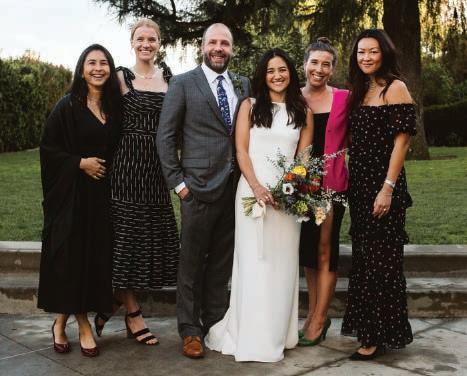
MEREDITH (FRECHETTEMOULTER) RUTA and husband Andrew welcomed a baby boy, Wells Raymond Ruta, on March 22, 2022. (see NKOTQ p. 79.) Wells, his parents, and their dog, Mango, live in Quincy.
2007

LAURENELIZABETH (PALMER) COHEN and MIKE COHEN welcomed twin boys. Charles Pennington “Penn” and William Wilder “Wilde” arrived in January 2022 (see NKOTQ, p. 78). Big brothers Beau and Wells are overjoyed with their new playmates. The family is also excited about an upcoming move to Albany, New York, where Mike will join Albany Medical Center as a gynecologic oncologist.
TIM CORKUM FIFIELD and JOCELYN “JOCIE” FIFIELD (The Mountain School S’08) were overjoyed to celebrate SARAH EBERT’s wedding to Claire Murray this summer! They miss the crois sant deliveries, walking the dogs at Allendale Woods, and just being neighbors now that

71Fall 2022
Above: Giancarlo Talarico ’04 and Chantal Stafford-Abbott married in October 2021
Below: left to right, Wendy Conn ’04, Allegra Palmer ’06, Tom Dibblee, Emily D. H. Dibblee ’06, Lara Koerner Yeo ’06, and Hilda Lui at Emily and Tom’s March wedding
IRENE LI ’08 WINS JAMES BEARD LEADERSHIP AWARD
In June, IRENE LI ’08, traveled to Chicago to receive the James Beard Foundation 2022 Leadership Award, the youngest recip ient ever to receive the prestigious award. Calling her a vision ary, the foundation described Li as someone who “has spent years driving the restaurant industry forward through sustain able, ethical sourcing of ingredients and fair and progressive employment practices.”
The award comes after two years of fits and starts for Li’s restaurant. In early 2020, Li was running Mei Mei, a successful Boston restaurant she had cofounded eight years earlier with her siblings. As COVID-19 forced shutdowns across Boston, Li closed Mei Mei’s doors,converting the restaurant into a virtu al classroom and dumpling-making operation. She also turned her attention to the larger community, piloting the distribution of cooked meals and groceries to frontline health care workers, helping raise more than $15,000 to support struggling small-restaurant owners, and cofounding Project Restore Us, which has fed more than 3,000 Boston-area working families with more than 500 tons of food.

One of the most difficult challenges of the past two years, says Li, was laying off so many of Mei Mei’s staffers. “Restaurant jobs need improve ment,” she says. “Human resources is all about protecting the company; it doesn’t provide clo sure, invest in people, or help in making people whole.” Toward that end, she developed Prepshift, an online relationship-build ing tool that conveys the important message that employees are valued and respected.
Although Mei Mei will not return as a sit-down restaurant, Li is looking forward to what lies ahead. “It was hard to say goodbye,” she says, “but what we’ve all learned is that Mei Mei is not really about being a restaurant. What we’ve built and created transcends any one business model.” Mei Mei’s tran sition to a dumpling-making factory will be complete when its location moves later this year to South Boston, where employees—once servers—will produce and process shipments. The new location will also include a small, “pared-down” restaurant.
they’ve moved to Portland. Tim and Jocie welcomed their first child in June.
▲ TREVOR PROPHET was induct ed into the Connecticut College Athletic Hall of Fame for soccer and tennis, celebrating with family and friends earlier this spring.
FRANK SMITH premiered his LGBTQIA+ comedy series, Open To It, which he writes, directs, executive produces, and stars in at Wicked Queer: Boston’s LGBTQ+ Film Festival in April, where he won the Audience Award for Best Comedy Short. The series was also accepted into Oscar- and BAFTA-qual ifying Outfest, the largest LGBTQIA+ film festival in the world. Frank recently completed Episodes 4–6, featuring Manila Luzon, Laganja Estranja, Pan dora Boxx, and Honey Daven port, of RuPaul’s Drag Race. The

72
Class Notes 2007 -2008
□ AWARDS
“
He Was the Most Resilient Person I’ve Ever Known”
REMEMBERING JACK ROBINSON ’18
JACK ROBINSON ’18 (pictured right, center), who loved his family and friends, compet itive rowing, and a good de bate, passed away in February from osteosarcoma. He was 21 years old.
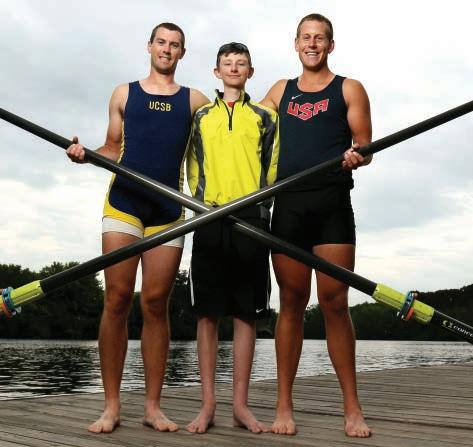
He entered Milton as a kin dergartner, and is remembered by teachers and friends for his curiosity, intelligence, and quick wit. Eighth-grade science teach er Tom Troy credits Robinson with making him a better teacher. “Jack fueled countless class dis cussions with his probing ques tions about the course content and the scientific process,” Troy recalls. “Admittedly, I made sure to prepare fully for each lesson in anticipation of Jack’s questions.”
“He was super smart and had the sharpest wit of anyone I’ve ever met,” says his longtime friend JACK WEILER ’18, who re members many spirited discus sions with Robinson and their close friends JIM DELANO ’18 and KEVIN LUL ’18. “He would always find a way to get us going about something. You could say any thing and he would find a way to disagree with you.” Weiler also remembers Robinson for his resil ience. Diagnosed with osteosar coma at age 10, Robinson never talked about it, he says. “He was the most resilient person I’ve ever known. He didn’t want anyone to give him anything. He didn’t want anyone to treat him differ ently; he just wanted to be treat ed like everyone else.”
Happiest on the water, say family members, Robinson loved fishing with his family on Cape Cod and rowing competitively. In high school, he was a mem ber of the Community Rowing Competitive Youth team, where he received the Coach’s Award for his contributions. At Cornell University, he was recruited to
coxswain on the D1 men’s heavyweight crew team and was elected co-captain in his junior year—one of only four coxswains to ever be elected captain in the team’s 150-year history. In the 2020-2021 sea son, Robinson was awarded the Intercollegiate Rowing Coach
Association Student Athlete Scholar award.
Among the many tributes paid to Robinson by his Cor nell teammates last winter, one crew member wrote: “You al ways supported me and had my back. More than that, you made me feel like part of the team. When I was scared and lonely, you showed me that I belonged. Thank you so much Jack. I love you man.”
He was also recognized at Cornell for his academic prow ess. Last year, the university’s economics department awarded Robinson the Tapan Mitra Prize
for his work in the area of law and economics. Robinson was awarded a B.S. degree posthu mously in June from Cornell.
“When we think about char acteristics that exemplify the best of Milton,” says Head of School Todd Bland, “Jack indeed exemplified ‘Dare to be true.’ He lived his truth and spoke his truth from the time he was in Middle School through the rest of his career into college. We want our students and graduates to live their authentic honest lives. Jack did exactly that!”
In March, family and friends gathered at Trinity Church in Boston to celebrate Jack’s life. An endowed fund has been cre ated in Jack’s memory to sup port scholarships at Milton. This school year, a Butterfly Garden will be planted in Jack’s memory on the campus.
In Memoriam
Paul D. Lamson
Edwin C. Lincoln
George W. Whitney
Claire Porter Pearmain
Luis F. Browne
Jan Royce Conant
Glenn M. McCrillis
Madeline Lee Gregory*
E. Amory Hubbard
Edward C. Johnson
Valentine
H.
Barnes
M.
G.
K. Elliott
L.
C. Hauser
E. Anderson
Lee Walsh
R. Robinson
Monique Lehner Faculty and Staff George F. Barnett Kendall Chun
photograph by
1930–1939
Jr. ’39 1940–1949
Jr. ’43
’46
’47
’48
’48
Jr. ’48
’49
’49
III ’49 1950–1959 Ann
Cobb ’50 Robert
Weiss ’50 Joanna
’52 Elinor Lamont Hallowell* ’53 Howard
Ticknor ’53 Robert
Shaw ’577 1960-1969 Philip
’61 1970-1979 Alexander
Cortesi ’79 1980-1989 Lesley
’86 Mary
’87 2000-2009 Caroline
’03 2010-2019 John
’18 Trustees
Gilbert Kline J. W. Mees Margaret Panarese Hugh Silbaugh * FORMER TRUSTEE ALUMNI, FACULTY, AND STAFF WHO PASSED DECEMBER 11, 2021-JUNE 21, 2022. TO NOTIFY US OF A DEATH, PLEASE CONTACT THE DEVELOPMENT AND ALUMNI RELATIONS OFFICE AT ALUMNI@MILTON.EDU OR 617-898-2447. be
es’
□ TRIBUTE 73Fall 2022
show also was invited to be the opening film at Rio LGBTQIA+ Film Festival; will be closing out qFlix Philadelphia; and has been accepted into Twisted Arts Tulsa and New Filmmakers Los Ange les. You can see the trailer for the show at opentoitseries.com or reach out to Frank on Insta gram (@frank.arthur.smith) to find out more.
2008

IRENE LI, cofounder and chef of Mei Mei, received a 2022 James Beard Foundation Lead ership Award (see sidebar on page 72). Considered by some to be the “Oscars of the food world,” the awards “recognize exceptional talent in the cu linary and food media indus tries, as well as a demonstrat ed commitment to racial and gender equity, community, sustainability, and a culture where all can thrive.” In addi tion, Irene received a 2022 Pin nacle Award for Achievement in Entrepreneurship.
MOLLY KRAUSE married Henri Neuendorf on May 1 in a private ceremony officiat ed by IAN MALONE ’14 at Bethesda Terrace in Central Park. Following the ceremony, several Milton alumni joined the celebration, including Molly’s first Hathaway room mate, CATHERINE GIBBONS; SAM PANARESE, who also graduated from Cornell with Molly in 2013; CHUKWUEMEKA “EMEKA” KANU ’07; and NICK GINSBURG ’10
Molly Krause ’08 and Henri Neuendorf wed in May.
2012
SARAH EVANS graduated from University of Massachusetts Medical School in June 2022 and began orthopedic surgery residency at University of Texas Health San Antonio in July 2022.
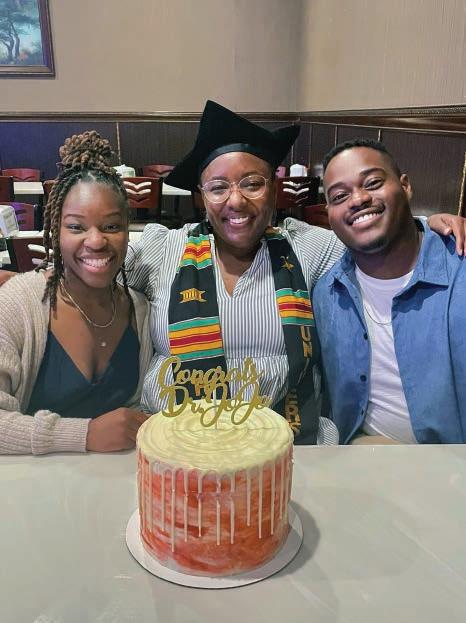
2013
ELIZAVETA “ELYA” REZNICHEN
KO married Michael Decker on June 18, 2022! They currently live in Hingham, Massachusetts, and work at Graphable in data analytics consulting and at Quickbase managing the deal desk, respectively.
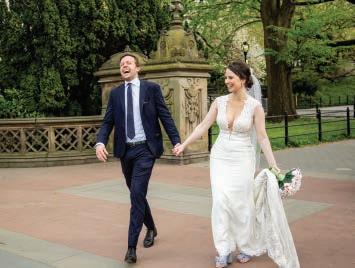
2015
NICHOLAS “NICK” DIGIOVANNI and his team at Kovert Creative were nominated for a Webby Award and won the Best Creator, Peo ple’s Voice of 2022! Nick shares, “I do all sorts of cooking videos on YouTube, TikTok, Instagram, and beyond, and we’re current ly at about 15 million followers, which has been quite crazy.”
JOVONNA “JOJO” JONES earned her doctorate in African & African American Studies from Harvard University in May 2022. She is now an assistant professor of English and Afri can & African Diaspora studies at Boston College. Jovonna was in troduced to African American studies as a field in Mr. Hilgendorf’s elective course at Milton. She thanks Mr. H., along with her speech team coaches Ms. Simon and Ms. Jean-Baptiste, her English teach ers Ms. Colson, Ms. Bond, Ms. Gerrity, and Ms. Levine, and her photography teacher Mr. Cheney for nurturing her desire to write about Black culture.
2011
2016 In April, SIMONE HUNTER-HOB SON was elected as the sec ond African American woman to serve as editor in chief of the Journal of Constitutional Law at the University of Pennsylvania Carey Law School. Noted in the Philadelphia Inquirer when Sim
74 Milton Magazine
ICONIC SONG GETS A DEEPER LOOK
A song many people associate with the Kentucky Derby has a deeper and more disturbing history, as detailed in the book My Old Kentucky Home: The Astonishing Life and Reckon ing of an Iconic American Song
Author EMILY BINGHAM ’83 spoke with Milton Magazine about the song’s origins, how it became the Kentucky state anthem, and why she believes it should not be celebrated at the Derby—or any where else.
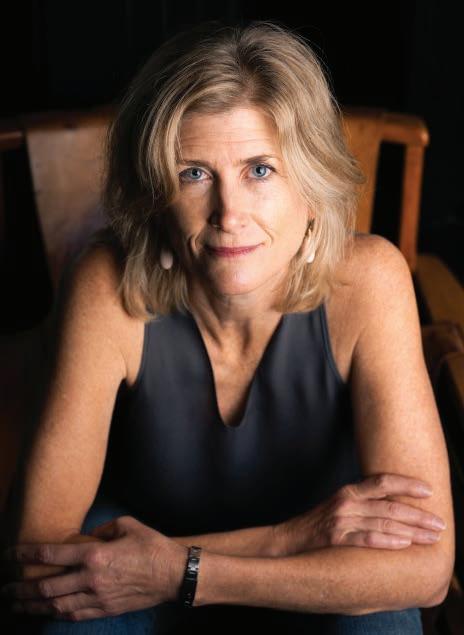

Why did you decide that the song “My Old Kentucky Home” would be a good subject for a book?
When I delivered a talk to a small group about Stephen Foster’s 1853 tune and shared its full lyr ics and its origins in blackface minstrelsy, and how it had been used to build an inauthentic pic ture of Kentucky history, some
of the white listeners declared, “I had no idea; I will never sing it again.” Black members of the group said, “How could you not know? This was never our song.” I began with the question, How did a song about the slave trade become a beloved and nostalgic anthem, a sonic monument to a segregated memory?
Tell us about the songwriter, Stephen Foster.
Everyone assumes it’s a Ken tucky song. In fact, for 50 years at least it had no direct tie to the Bluegrass State. Stephen Foster (1826-1864) was from Pittsburgh and deep in debt when he wrote “My Old Kentucky Home.” For a few dollars, he gave the era’s biggest blackface act, Christie’s Minstrels, exclusive performance rights before the sheet music was released as a way to boost sales. It was a moneymaker. But he didn’t produce enough hits in the years that followed and died with 37 cents to his name.
How did it become a tradition to play the song at the Ken tucky Derby? Kentucky never joined the Confederacy but identified as “southern” in the decades after the war, as the United States abandoned the civil rights of Black citizens and whites em braced egregious myths of gra cious plantation life. Legislators voted to make a song with a first verse presenting a Kentucky plantation as “the happy home of slavery” the state anthem. Two years later, in 1930, Churchill
Downs substituted “My Old Ken tucky Home” for “The Star Span gled Banner” at the moment of peak excitement when the Derby horses step onto the racetrack and parade to the starting gate. It made for a uniquely emotional moment in an American sport. People believed it had always been the Derby’s song.
Why did you conclude that the song is irredeemable?
For 170 years a song about happy plantation life followed by family separation, perhaps the most brutal aspect of our nation’s great sin, has given white Amer icans sentimental pleasure—and lined the pockets of white insti tutions.
You’re a member of a promi nent family with a deep history in Kentucky. How did being a
member of that family influence your perspective when writing your book?
For much of the 20th century, in cluding my time at Milton in the 1980s, the newspaper my family owned was perhaps Kentucky’s most progressive institution. The book touches on the liberal tradi tion and its limits when it comes to race in America. It felt import ant to acknowledge that my for bears and I, an avowed liberal, a wearer of Derby hats, and shed der of sentimental tears at the Derby, had without thought per petuated a song that represents a national wound.

75Fall 2022
□ ALUMNI BOOKS
Farming for Our Future: The Science, Law, and Policy of Climate-Neutral Agriculture
 PETER H. LEHNER ’76 & NATHAN A. ROSENBERG ENVIRONMENTAL LAW INSTITUTE
PETER H. LEHNER ’76 & NATHAN A. ROSENBERG ENVIRONMENTAL LAW INSTITUTE
Most efforts to ameliorate climate change have focused on the energy and transportation industries. Yet agri culture also deserves focus, the au thors contend, as an industry that both contributes to climate change and is profoundly affected by it. In Farming for Our Future, PETER H. LEHNER ’76, the managing attorney of the Sustainable Food & Farming Program at Earthjus tice, an environmental law organization, and Nathan A. Rosenberg, an attorney consulting for Earthjustice, offer “the only comprehensive overview of the sci ence, existing law, and policy proposals on agricultural emissions in the United States.” Currently, they say, agricultural production is one of the least-regulat ed industries in the country, and they advocate for policymakers to regulate practices of large industrial operations that are highly polluting and also drive smaller farms out of business. They pro pose federal policy to support “carbon farming,” which would capture and store carbon dioxide rather than releas ing it into the atmosphere. The book covers topics such as how the private sector can facilitate carbon farming and how government can encourage the consumption of climate-friendly foods. The agricultural sector, the authors say, is decades behind in instituting environ mentally beneficial practices.
A Path into the Mountains: Shugendō and Mount Togakushi

 CALEB SWIFT CARTER ’96 UNIVERSITY OF HAWAI’I PRESS
CALEB SWIFT CARTER ’96 UNIVERSITY OF HAWAI’I PRESS

In A Path into the Mountains, CALEB SWIFT CARTER ’96, an assistant profes sor of Japanese religions and Buddhist studies at Kyushu University, explores how Shugendō became Japan’s pre mier mountain religion. Based on a decade of research and fieldwork, in cluding visits to the alpine terrain of Togakushi in the Nagano Prefecture of Japan, the book traces the history of the religion, which developed in the late medieval period from branches of Buddhism, and examines the medieval Buddhist landscape before Shugendō. Topics covered include the exclusion of women from areas of the moun tains and voices opposed to the policy; how warfare in the mountain region affected the religious community; and the role of narrative in elevating Shugendō. Rituals and ritual knowl edge were crucial to the development of Shugendō and helped provide con tinuation from one generation to the next, according to the author. People’s interest in the religion in contemporary times stems “from a desire to escape the urban environment, explore alter native forms of healing and spirituali ty, connect with mountain spirits, visit power spots [places thought to bring healing and good luck], and engage with the natural world,” Carter writes.
Lincoln and the Fight for Peace
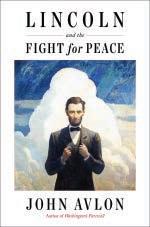 JOHN AVLON ’91 SIMON & SCHUSTER
JOHN AVLON ’91 SIMON & SCHUSTER


Few of the thousands of books pub lished about President Abraham Lincoln examine his role as a peacemaker seek ing to unite the country after the U.S. Civil War, because he was assassinated only five days after the surrender of the Confederacy. Yet although he didn’t live to lead the country after the war, he spent two years before his death plan ning for reconciliation and reunifica tion. In Lincoln and the Fight for Peace, JOHN AVLON ’91 outlines the political reforms and economic expansion that Lincoln believed could integrate a slav ery-free South back into the Union. His plans were predicated on the principle of “unconditional surrender followed by a magnanimous peace.” While Lin coln insisted on an end to slavery and a restoration of the Union, he also of fered the Confederacy generous terms of surrender, with the defeated soldiers allowed to return home. The book in cludes accounts of Lincoln’s visit to the front lines and the Confederate White House and his final speech, in which he endorsed a right to vote for African Americans. Avlon explores how Lincoln’s death led to the betrayal of his vision by his successor, Andrew Johnson, and the subsequent curtailing of rights for African Americans. The author also sur veys Lincoln’s effect on leaders in the aftermath of the world wars of the 20th century. Lincoln’s plan to win the peace is still relevant today, Avlon writes, of fering a path away from polarization in an increasingly divided country.

photograph by 76 Milton Magazine □ ALUMNI BOOKS
one was appointed, it is the first time in the history of Penn’s law school that three African Ameri can women are leading three law journals. Simone’s work on the importance of the legal commu nity to prioritizing Black women’s health was highlighted last win ter on the school’s website (www. law.upenn.edu/live/news/14427simone-hunter-hobson-l23-callson-the-legal).
2021
▲ MATTHEW O’ROURKE bumped into Boys’ Squash Head Coach Morgan Poor on the slopes over spring break. He shares, “Mor gan is a former ski patroller, and I grew up skiing. We had always talked about the sport, so it was awesome to meet up.” They ended up skiing the rest of the afternoon together, including on some knee-deep powder. Matt reports that “it was one of the best days I’ve ever had, especially because it was great to catch up with Morgan.”
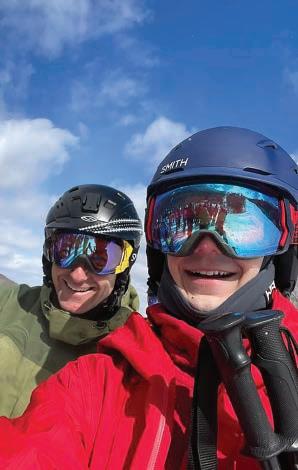
Milton Academy Board of Trustees
Claire D. Hughes Johnson ’90 P ’24 ’27
Stuart I. Mathews P ’13 ’17 ’17
Edward E. Wendell Jr. ’58 P ’94 ’98 ’01 GP ‘35
Bradley M. Bloom P ’06 ’08
James M. Fitzgibbons ’52 P ’87 ’90

President Milton MA
Vice President Waban MA
Vice President Milton MA
Emeritus
Wellesley MA
Emeritus Chestnut Hill MA
Franklin W. Hobbs IV ’65 P ’98 Emeritus New York NY
David B. Brewster ’90 P’25
Cambridge MA
Yeng Felipe Butler ’92 P ’25 ’33 Milton MA
Douglas Crocker II ’58 Delray Beach FL
Jason Dillow ’97 New York NY
Shadi Farokhzad P ‘23 ‘25
Waban MA
John B. Fitzgibbons ’87 Bronxville NY
Eleanor Haller-Jorden ’75 P
Peter Kagan ’86
Sonu Kalra P ’23
Wädenswil Switzerland
New York NY
Milton MA
Elizabeth B. Katz ’04 Boston MA
William A. Knowlton P ’23 Boston MA
Yunli Lou ’87 P
Ravi Mallela P ‘22,
John D. McEvoy ’82
Meika Tylese Neblett ’90
Shanghai China
Honolulu HI
Milton MA
Lincroft NJ
Osaremen Okolo ‘13 Cambridge MA
Gene Reilly ’79 P
Hendrick Sin P ’23
Gabriel Sunshine P
North Andover MA
Hong Kong China
Boston MA
Patrick Tsang ’90 Hong Kong China
Luis M. Viceira P
Belmont MA
Justin Walsh ‘99 New York NY
Sylvia P. Westphal
Ronnell L. Wilson
Boston MA
Jersey City NJ
Helen Zhu P’25 Hong Kong China
77
2022-2023
’93
’09
’26 ’28
’24
‘24
P ’19 ’20 ’25
’10 ’12
’25
’22 ’24
’16 ’19
P ’18 ’21 ’25 ’27 ’27
’93
Kids

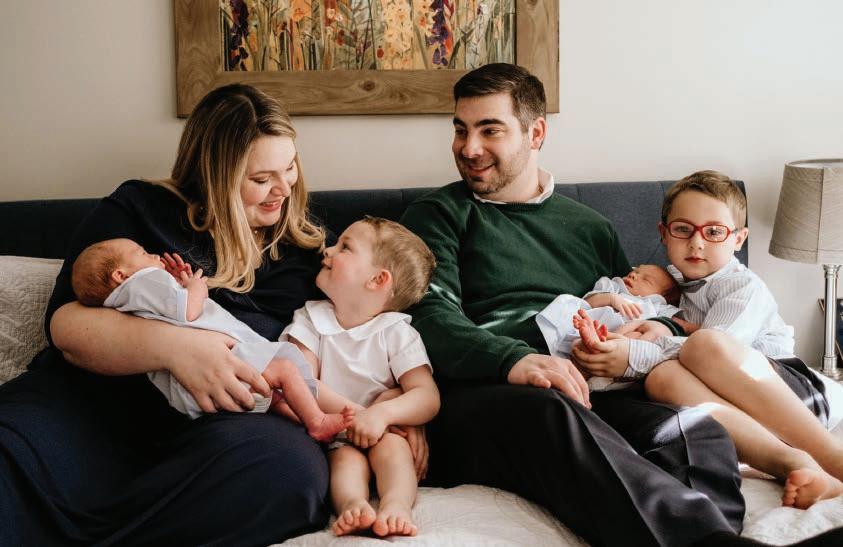

78 Class Notes N.K.O.T.Q.* *New
on the Quad ALUMNI FAMILIES & THEIR LATEST ADDITIONS Morgan and Grayson DAUGHTER AND SON OF MEREDITH AND PETER KELLNER ’87 Penn and Wilde LAURENELIZABETH (PALMER) COHEN ‘07, MIKE COHEN, AND BIG BROTHERS BEAU AND WELLS WELCOMED BABIES PENN AND WILDE
Blakely Bendetson
McCourt BABY OF TREVOR MCCOURT ‘01 AND SAMANTHA BENDETSON MCCOURT ’05
who they become. Starting points matter. Foundational principles matter.
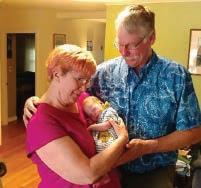

Not even robust principles, of course, can resolve every peda gogical or curricular dilemma. Yet those principles remind us what it means to honor students. When we ask students to wrestle with hard historical truths, when we call on them to confront uncomfortable re alities, when we urge them to create a better world, when we acknowl edge their distinctive experiences and multiple identities—when we do those things, we convey our con fidence in their singular gifts, their remarkable potential, and their full humanity. If we do all that, how can schools not be places of great depth and great joy?
And about that essay: I can’t stop loving it. I will reframe the course in light of the student’s critique, and when I do, I will do my utmost to devise assignments that give every student the opportunity to think with such freedom and write with such verve. They deserve it. I also can’t wait to help the author wran gle his unruly sentences—commas, footnotes, and periods all running wild—so that the power of his writing matches the power of his thought. He is good, wise, curious, creative, and capable. I will honor him with one final challenge.
AS A MEMBER OF MILTON ACADEMY’S HISTORY AND SOCIAL SCIENCES DEPARTMENT, BALL WILL CONTINUE TO TEACH AND, BEGINNING THIS FALL,
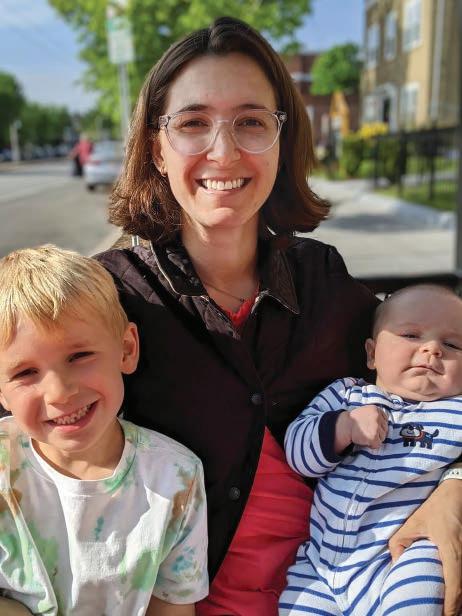
Postscript CONTINUED FROM P. 80
WILL ALSO COORDINATE MILTON’S RE-ACCREDITATION PROCESS FOR THE NEW ENGLAND ASSOCIATION OF SCHOOLS AND COLLEGES. 79Fall 2022
Madeleine Anne Powelson and Mark Goff, son of Emery Goff ‘52 and husband, Bill, with Emery’s first great-grandchild
Matthew and James CHILDREN OF ANNE DUGGAN ‘02 AND DAVID RANIERI
Wells Ruta
BABY
OF MEREDITH
(FRECHETTE-
MOULTER)
’06 AND
ANDREW RUTA
Teaching Reimagined
DAVID BALL ’88 , WHO RECENTLY STEPPED DOWN AS MILTON’S UPPER SCHOOL PRINCIPAL,DISCOVERS A NEW APPROACH TO THE ART OF TEACHING.
by any conventional measure, the essay was a mess. An overflow ing introduction nearly submerged the essay, leaving the paper’s body gasping for air; sentences, some with indiscernible beginnings or endings, clanged against one an other; the citation was, well, inno vative, a truly distinctive amalgam of errors. Yet the essay sang. Bold and original, the author presented an argument that, more than he knew, challenged the underlying assumptions of the course, blend ing his experience, his insight, and his aspirations. At once angry and hopeful, the essay was a beautiful, compelling, memorable mess.
Is my enduring affection for this essay misplaced? A sign of some sort of softening? I certainly do not mean to diminish precision. Indeed, every time I set my fear ful foot on an airplane, I expect meticulous adherence to procedure from the pilots; they can take their flights of fancy another day. We tol erate the sloppy and slipshod at our own peril: Words matter, evidence matters, reason matters. And yet that essay burst with a bracing, invigorating humanity. That must have value. Isn’t that the ultimate value?
Now more than ever, and in myr iad ways, we find ourselves asking what is indispensable in education. And at a time when matters of ped agogy and curriculum have turned divisive, schools, those shared spaces where together we cele brate youthful potential and hon or human possibility, must stand securely on a few firm foundation al principles, principles resting on our shared humanity. Two seeming ly disparate sources have shaped my
recent thinking.
A few years back, I was intro duced to circle protocols, a core element of restorative practices. Un familiar with the process, I initially approached training in these pro tocols with a healthy dose of skep ticism. Any resistance soon melted away. I learned that the first animat ing assumption of circle practices, as Carolyn Boyes-Watson and Kay Pranis explain, is simple: “Everyone has a self that is good, wise, pow erful, and always there.” I will leave it to the more spiritually facile to wrestle with the metaphysics here; I just know how transformative this premise can be. Imagine an educa tional landscape in which every teacher were to begin each class, as I now do, with that as their inter nal mantra, a reminder that our task is to see that good and wise self in every student—the sullen and silent, the bright and bubbly, the cautious and caustic. They are adoles cents.
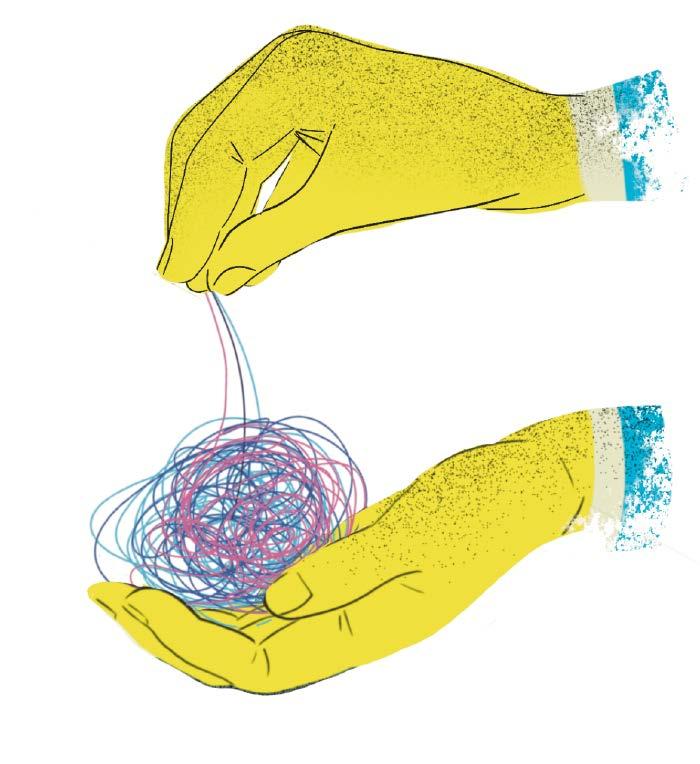
At about the same time, a colleague intro duced me to Jal Meh ta’s and Sarah Fine’s In Search of Deeper Learn ing, an elegant and deep ly researched study of American high schools. Regardless of a school’s dominant pedagogy, Mehta and Fine conclude, the most effective teachers take a certain stance to ward their students. These teach ers see students as “creative, curious, and capable”; they recognize stu dents as “creators of knowledge”; they embrace an ethos of “rigor and joy.” These teachers start from certain premises: that their students
are eager to discover, to create, and to meet challenges. In effect, Mehta and Fine are calling on all educa tors to revise that earlier mantra. All students have a wise and good self, yes, and they also hold within them curiosity and creativity just
waiting to be unleashed.
Mehta and Fine are suggesting something more, too. Researchers rather than soothsayers, they might reject the old saw about self-fulfill ing prophecies. Still, their analysis confirms what we might intuitive ly expect: Our vision of who stu dents can be shapes the reality of
80 Postscript
illustration by Jason Schneider CONTINUED ON P. 79
Milton Magazine
Milton
Milton Forever.
Create Your Legacy at Milton Academy
In your will or trust. If you are planning to create or update a will, you can include Milton as a specific or percentage beneficiary.
Through a beneficiary designation. Name Milton Academy as a beneficiary of your retirement plan, investment account, or life insurance policy by simply filling out a form online with your plan administrator.
With a life income gift. With a gift of $25,000 or more, a charitable gift annuity is a simple contract, guaranteed by Milton Academy, which can provide you and/or a loved one with a secure income for life and Milton Academy receives the remainder.
Document your legacy. If you have included Milton in your estate plans, please contact us to receive a bequest intention form and learn more about how your future gift can help count toward your Reunion and class fundraising totals.
Contact Director of Planned Giving James Barrett at 617-898-2376 or james_barrett@milton.edu for more information or to inform Milton of your legacy gift.
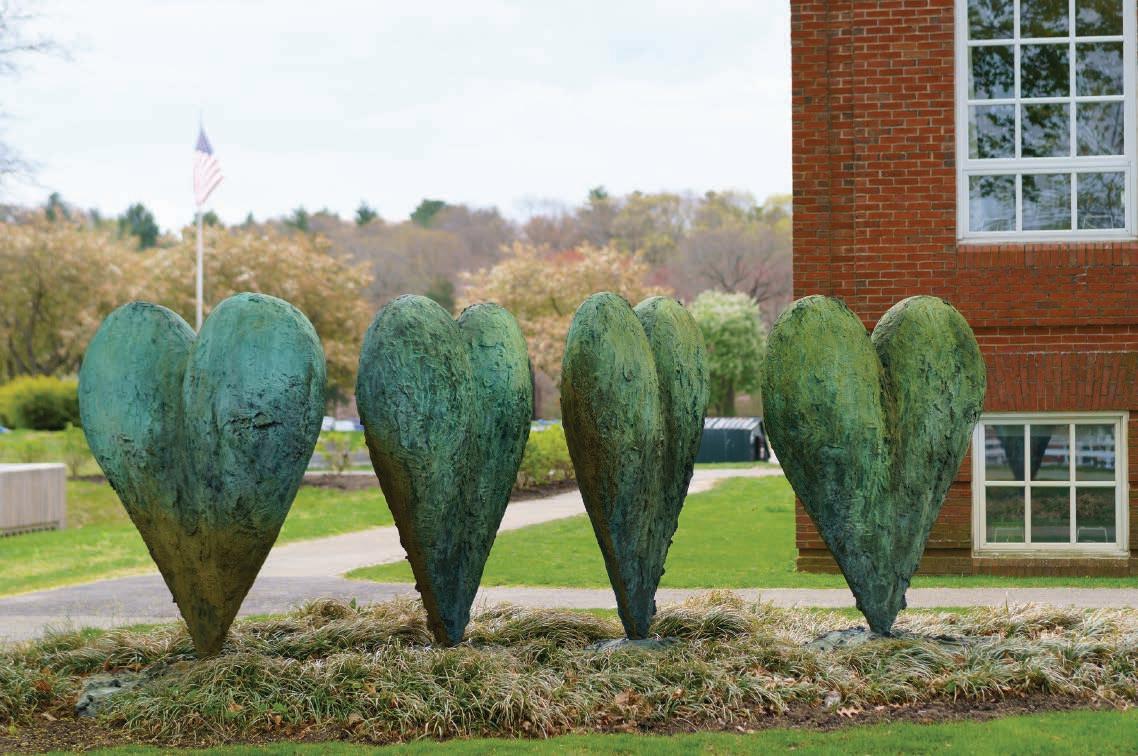
Now.

“To be a teacher is to always be learning.”
PROFESSOR AND DIRECTOR OF AFRICANA STUDIES AT NORTHEASTERN UNIVERSITY RÉGINE MICHELLE JEAN-CHARLES ’96 (SEE PAGE 24) Milton Magazine Milton Academy Communication Office Milton, MA 02186 Change Service Requested Non-Profit Organization U.S. Postage PAID Boston, MA Permit No. 58423






















 Story by Grace Tatter
Photographs by Michael Warren
Illustration by Mike McQuade
Story by Grace Tatter
Photographs by Michael Warren
Illustration by Mike McQuade





























































 —HEIDI VANDERBILT-BROWN CHIEF FINANCIAL & OPERATING OFFICER
—HEIDI VANDERBILT-BROWN CHIEF FINANCIAL & OPERATING OFFICER



































































 PETER H. LEHNER ’76 & NATHAN A. ROSENBERG ENVIRONMENTAL LAW INSTITUTE
PETER H. LEHNER ’76 & NATHAN A. ROSENBERG ENVIRONMENTAL LAW INSTITUTE

 CALEB SWIFT CARTER ’96 UNIVERSITY OF HAWAI’I PRESS
CALEB SWIFT CARTER ’96 UNIVERSITY OF HAWAI’I PRESS

 JOHN AVLON ’91 SIMON & SCHUSTER
JOHN AVLON ’91 SIMON & SCHUSTER











